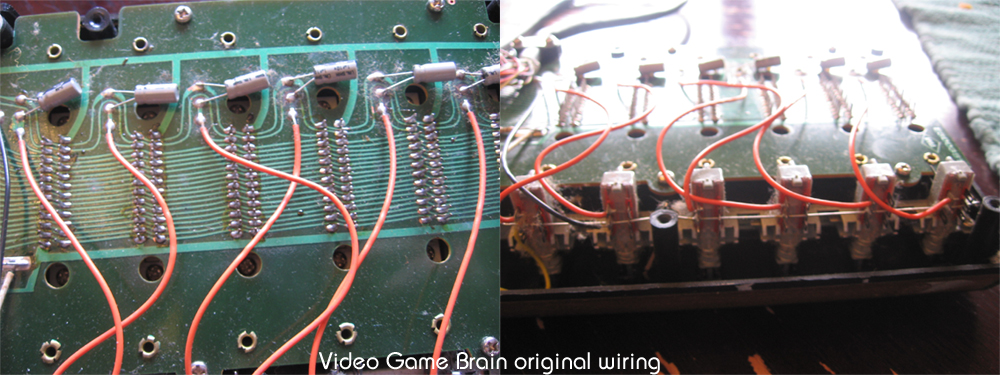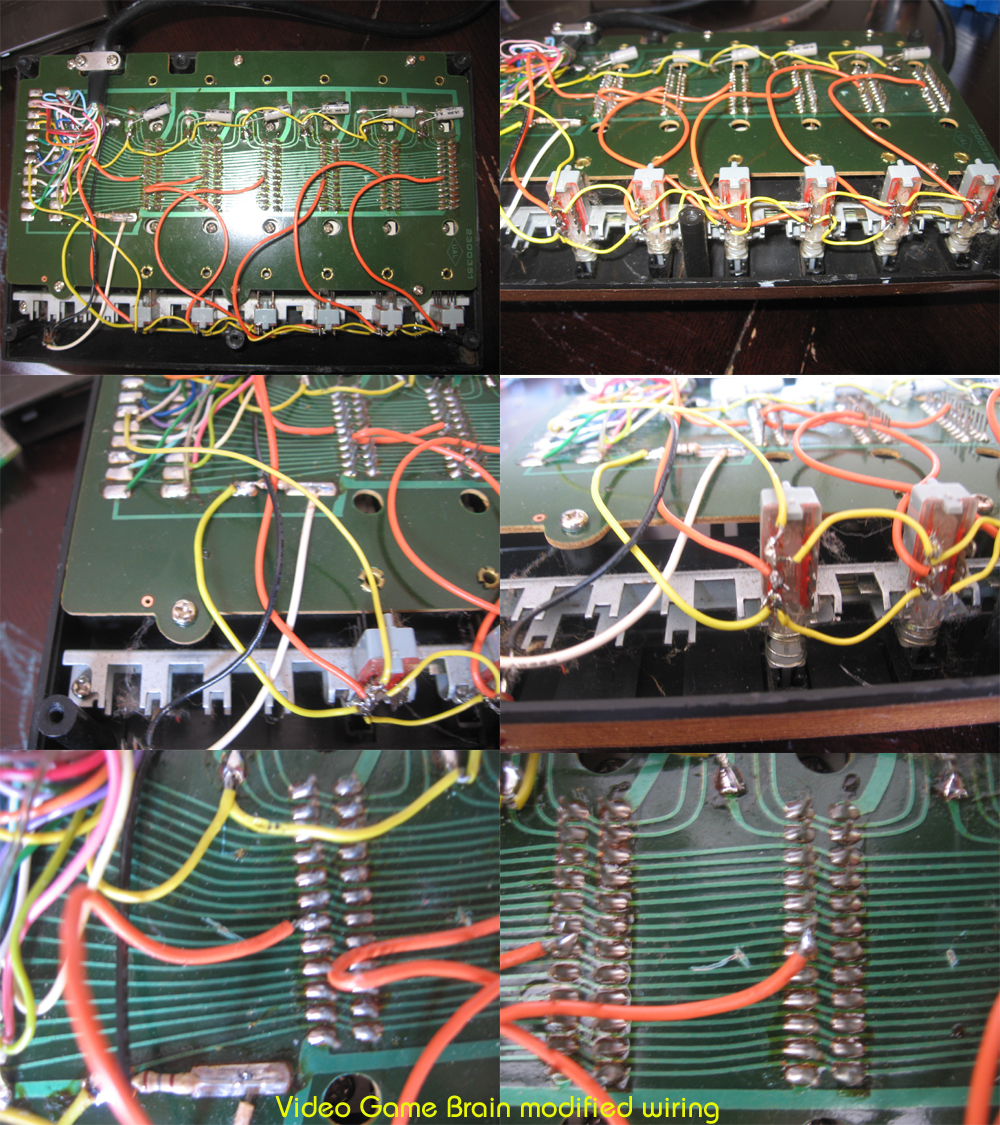

ATARI VCS/2600 FAQ
Last updated 11-17-2025
This FAQ is an evolving document. If you have any additions, suggestions, or corrections, please email me.
|
GENERAL |
A: Articles of Incorporation for Atari were filed in the office of the Secretary of State of the State of California on June 27th, 1972, and finalized on July 1st, 1972. Check out Michael Current's excellent website for a copy of the paperwork, as well as for more details on the complete history of Atari.
Q: When was the VCS/2600 developed and who developed it?
A: First conceived in 1975 by Steve Mayer of Cyan Engineering, he felt developing a microprocessor-based home system would be more versatile than the dedicated systems they had been developing (starting with Home Pong). Ron Milner developed the breadboard-level design and the sound circuits that were used for the first prototype that Mayer interfaced that with a JOLT 6502 (which was made by Microcomputer Associates Inc.). Atari hired Joe Decuir to work with Mayer and Milner at Cyan Engineering to debug the prototype, which was code-named "Stella". Decuir later took it back to Atari to continue development of a second gate-level design of the prototype (that used the 6507), which was completed in March 1976. The gate-level prototype was designed to mimic as closely as possible the intended final graphics chip, using circuit-design techniques specific to MOS integrated circuits. Jay Miner was brought in to help design the graphics chip, called the Television Interface Adaptor (TIA). The first software written for it by Mayer - later with help from Decuir - was assembled on a DEC PDP-11 minicomputer. See the March 1st, 1983 IEEE Spectrum article, "Inventing the Atari 2600").
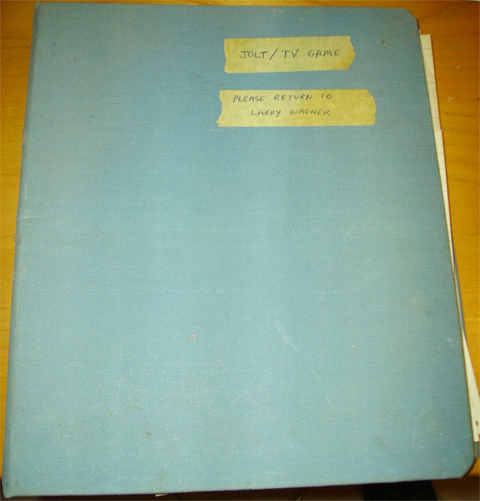
A: The in-house nickname for the VCS/2600, "Stella", was not derived from a female employee like most Atari hardware projects were, but rather designer Joe Decuir's French Stella bicycle. The nickname wasn't for the system itself but rather the custom graphics chip, TIA.
Q:
When was the VCS/2600 first released and what did it sell for?
A: Although many sites now claim September 11th, 1977 as the "official release date", there's simply no documentation to prove it. According to Jerry Jessop, there were no "launch" dates back when the VCS was released. Production started with the Sears version in July of 1977 and it immediately went to retail warehouses.
From Michael Current:
| I came to the conclusion that one or
more people probably took the Macy's ad of 9/11/77 as indicating the
"official release date". So that's my theory of where the date came
from. Older versions of my timeline may have been guilty of going
along with that idea, but no longer. As with most product releases
back then, I think there was no set release date, more a matter of product
shipping out over a period of time, so it became available around the
country over a range of dates as resellers received stock to sell.
Ship dates can be more tangible, especially if the product is manufactured
and shipped from one place. In this case, I have Atari indicating at the CES in June that they expected the VCS to be available in July. Based on the reports in Television Digest (LINK) along with the August newspaper ads, I think Atari probably at least shipped it by late July, so that it began to be available by early August, give or take a few days. |
One long-believed story/rumor is that the VCS was ready for release a year earlier, but was held back due to Atari's agreement with Magnavox over Pong. Magnavox had sued Atari for patent infringement, and Atari ended up getting a paid-up license (the first company to do so) to pay Magnavox a royalty on every Pong system that Atari sold (via a paid-up license). That deal was to expire right before the 1977 CES in Chicago, so Atari just kept the already-in-development 2600 under wraps until the show so they wouldn't have to pay Magnavox any royalties for it (which they would have had to do if they shipped it earlier).
The more common belief is that the VCS's release was held up due to lack of funding, which is partly why Bushnell sold Atari to Warner in 1976.
The earliest advertising found thus far are these ads from August 1st, 1977. The first is from Longs drug stores that appeared in The Times newspaper from San Mateo, CA. The VCS was listed for $170 ($169.88) with carts for $18 ($17.88). The second is from the San Diego Union newspaper.
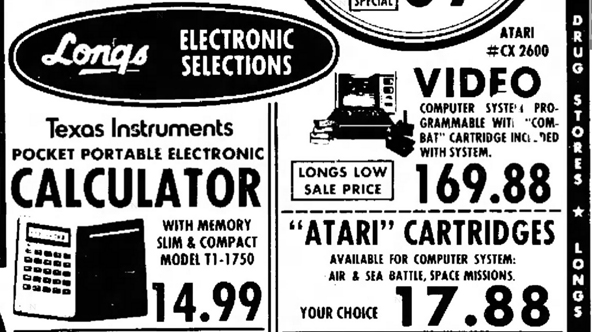
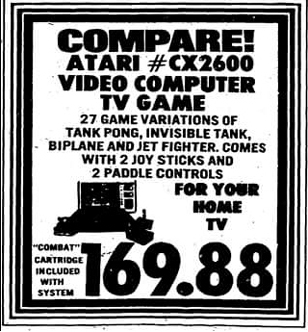
Other ads found in newspapers throughout the country show prices ranging anywhere from $150 to $180, with a retail list price of $190. One ad from a Canadian paper listed it for $238.
Q: What Usenet groups actively discuss the VCS/2600?
A: There are several groups, although there is very little activity on them these days:
Most ISPs no longer support access to them, but Google Groups is one web-based option.
Q: What website forums actively discuss the VCS/2600?
A:
Q: Where can I find VCS/2600 games?
A: Besides Ebay, there are still several sources online for both new and used game cartridges, such as:
Other sources for both new and used games, and consoles include:
Q: Where can I find cartridge lists?
A: Atariage and Atarimania have searchable lists online. Atarimania's is the only one that's frequently updated.
Q: Which magazines covered the VCS/2600 in the 1980s?
A:
Scott Stilphen made complete scans of most these and more, which can be found here in the archives section.
Q: Which recent magazines cover the VCS/2600?
A:
Q: Which newsletters covered the VCS/2600?
A:
Scott Stilphen made scans of some of these, which can be found in the archives section.
Q: Which books covered the VCS/2600?
A: The most comprehensive list is maintained in the archives section of the Atari Compendium website, which includes scans I made of some of them. Some of the best ones are:
Q: Are there any documentaries that cover the VCS/2600?
A: Once Upon Atari is a four part series exploring the early days of Atari. Produced by Howard Scott Warshaw, the series is a first hand look at Atari from the people who worked there.
Stella at 20: An Atari 2600 Retrospective is a series of documentaries from CyberPuNKs (Russ Perry Jr., Glenn Saunders, Jim Nitchals and Dan Skelton) on VHS. Both "Volume 1, Tales of Stella" and Atari" and "Volume 2, The Game Designers or One Person, One Game" are around 90 minutes in length and originally sold for $25 each or $40 for both (+ shipping). The videos were never released on DVD, but the raw footage from the gathering was finally released.
Two videos - one documenting the 1998 World of Atari show and one documenting the 1999 Classic Gaming Expo - are available from Mark Santora for $25 + $4 shipping each or $50 (shipping included) for both tapes. Contact him directly to order or to inquire about international orders or PAL format tapes.
A 4-DVD box set, CGE 2K7, documenting the 2007 Classic Gaming Expo show, is available from Scott Stilphen for $25 each.
Q: Where can I view Atari TV commercials?
A:
Q: Where can I view Atari print advertisements?
A:
Q: What is IRC and how do I use it?
A: IRC is Internet Relay Chat, a global real-time chat network. You can download an IRC client from www.mirc.com, and you will also find some general information and instructions there.
Q: What does the Atari symbol represent?
A: The Atari symbol was designed by George Opperman in 1972. Pong was very popular then, and the symbol was a stylized version of a capital 'A', with the two opposing video game players representing the sides, and the center of the Pong court in the middle.
Q: What does the word "atari" mean?
A: The word atari comes from the game of Go, perhaps the world oldest board game. Nolan Bushnell described it as a polite way of saying you're about to be engulfed. Some sets of rules (such as the Japanese and World Amateur Go Championship) define it as, "A group of stones is in atari if it has only one liberty left." For more information about the game, check out the American Go Association.
Q: Where can I find Atari-like fonts?
A: The most common Atari VCS/2600 font type is Bimini. True Type Fonts (TTF) for it can easily be found online for free (LINK).
Q: Which shows, events, or gatherings cover the VCS/2600?
A: There are several in both the U.S. and in Europe:
Q: What's the story about Atari being sued for not having a chess game?
A: There were 2 different boxes for the original VCS model in 1977. 6 artwork photos were changed between them:
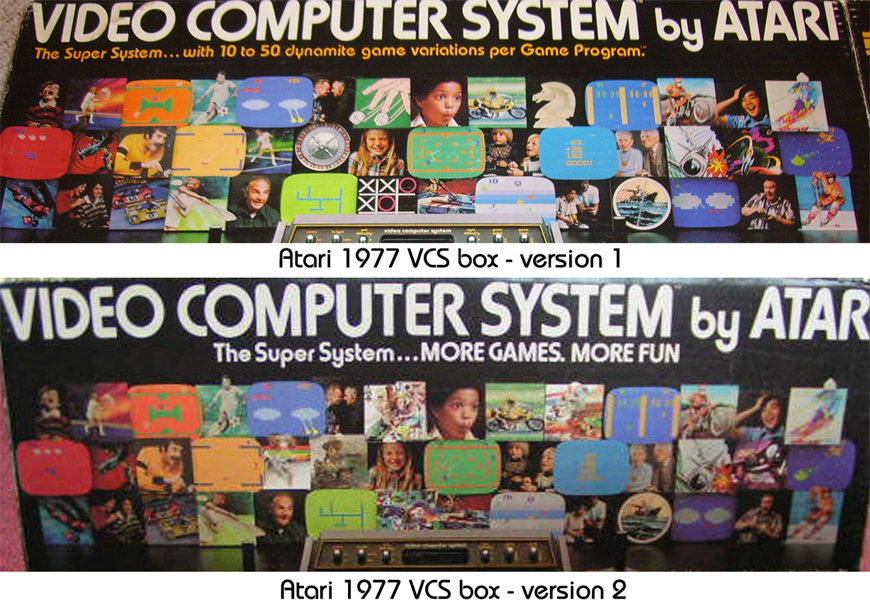
The reason for why the artwork was changed is related to a story about someone in Florida who sued Atari for having a picture of a chess piece on the box when Atari didn't offer a chess cartridge:
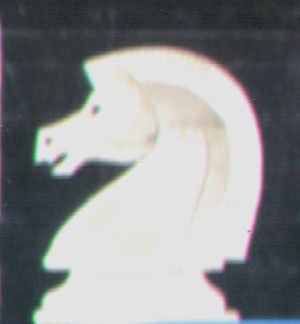
The story has its roots in an article that appeared in the March 1983 issue of IEEE spectrum that featured quotes from then-VP of the VCS Development group Larry Kaplan and head of Engineering Allan Alcorn:
| "When the VCS was first manufactured," Mr. Kaplan recalled, "the box had a chess piece on it. 'Those marketing guys! Come on,' we said. 'It'll never do chess.' Well, some guy in Florida sued because there was a chess piece on the cover and we didn't have a chess game." A year later Atari's designers began developing Chess. "The guys were playing around," Allan Alcorn, then head of engineering at Atari, recalled, "and one guy said, 'I could write an algorithm, but I couldn't get a playfield on the screen.' Another guy said, 'That's easy.'" Larry Wagner wrote the algorithm; it took him two years with the help of national chess champion Julio Kaplan. Mr. Whitehead did the display in two days, developing the trick now known as Venetian blinds. |
The lead designer of Atari Video Chess, Larry Wagner, once mentioned the cartridge was developed as a result of this lawsuit, but later recounted his statement and said its development started as an interesting R&D project, and referred to the same IEEE spectrum article:
| To set the record straight, the chess algorithm started on a microprocessor system with 128 bytes of RAM. The best source is the IEEE spectrum article in the 80's. It was not because someone threatened Atari with a lawsuit; the chess cartridge was developed because we wanted to have an interesting R&D project. |
Bob Whitehead, the person responsible for developing the display, had this to say:
| One of the corporate reasons for doing chess I heard repeated to me several times was that we needed to do 'a chess game' because it was in some of the original VCS/2600 artwork, I think even the box itself. So, 'Atari’s committed to doing it.' |
The fact that artwork for games that Atari didn't have at the time (chess, tic-tac-toe, casino games) were quickly removed from the box, which gives credence to the lawsuit story. Atari probably felt the less people that knew about the lawsuit the better, and simply didn't tell the programmers the complete story as to why they needed a chess cartridge. By the time the IEEE spectrum article came out in 1983, it hardly mattered.
Q: What are those black lines I see along the left side of the screen in some games?
A: The black lines are the result of using a programming trick developed by Larry Kaplan that uses what's called an HMOVE command. If an HMOVE is initiated immediately after HBlank starts (which is the case when HMOVE is used as documented), the [HMOVE] signal is latched and used to delay the end of the HBlank by exactly 8 CLK, or two counts of the HSync Counter. This is achieved in the TIA by resetting the HB (HBlank) latch on the [LRHB] (Late Reset H-Blank) counter decode rather than the normal [RHB] (Reset H-Blank) decode. The extra HBlank time shifts everything except the Playfield right by 8 pixels, because the position counters will now resume counting 8 CLK later than they would have without the HMOVE. This is also the source of the HMOVE 'comb' effect; the extended HBlank hides the normal playfield output for the first 8 pixels of the line:
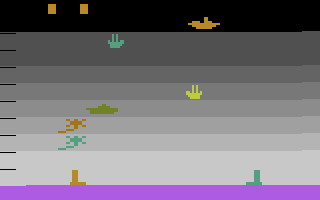
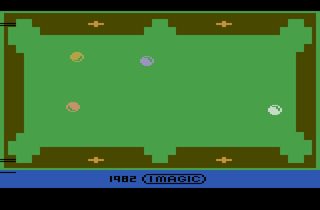
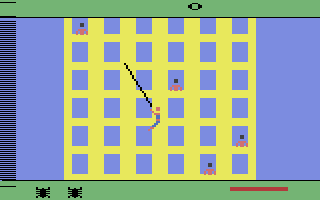
Here's an excerpt from an article that appeared in the March 1983 issue of IEEE spectrum, explaining what led to its development:
| One critical MOS-dependent feature was the use of a special counter - called a polynomial counter, or pseudorandom shift register - instead of a true binary counter to determine object positions on the screen. A polynomial counter occupies one-fourth the silicon area of an equivalent binary counter, but, unlike a binary counter, it does not count in any simple order. Thus, a programmer cannot calculate a screen position for an
object and load it into the position counter.
The original Stella prototype had only one signal to the position counter: a reset that would trigger the immediate display of an object. Mr. Decuir and Jay Miner, who designed the production version of the Stella chip, used this same concept in their design. As a result, displaying an object in a given position on the screen requires that the programmer count the number of clock cycles taken by a given set of instruction, figure out how far across the screen the electron beam would be after the instructions had been executed, and act accordingly. Once the position counter for an object is reset at the proper point, it continues to display the object at that spot on succeeding lines. To move objects, the prototype blocked out four clock pulses from the position counters during the vertical blanking interval; a programmer could then add pulses to move an object left or right - four pulses had to be added to keep the object in the same place. Mr. Miner added a set of motion registers, which add or subtract pulses automatically when a signal - called H-move - is sent by the microprocessor. The H-move can be sent during the vertical blanking interval, or during the horizontal blanking interval at the beginning of each line. "This seemed innocuous enough," said Larry Kaplan, the first software designer hired to develop games for the Stella project. "But I discovered early that it was possible to reposition player objects during a screen [a frame of the TV picture], though that was not a consideration of the design." So Mr. Kaplan designed Air-Sea Battle, which has horizontal bands of player objects, a technique used in countless VCS games, including Space Invaders, Freeway, Asteroids, and Football. "Without that single strobe, H-move, the VCS would have died a quick death five years ago," said Mr. Kaplan, now vice president of product development at Atari. |
Activision got around this by using the trick on every scanline, which effectively blacked out the screen area where the lines appear (with Boxing being the first).
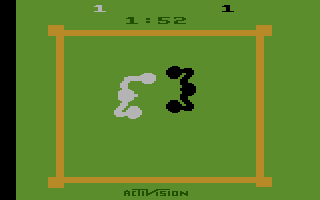
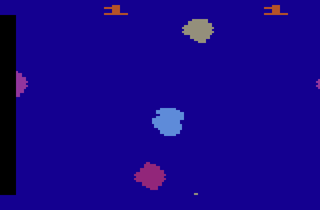
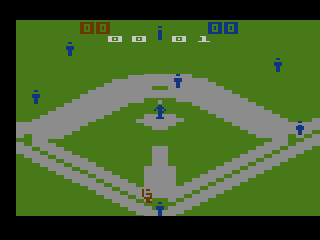
Eric Del Sesto of M Network devised a method that he called "hidden V-clocks" to remove the lines. From Sesto:
| The Atari 2600 had no video memory. Instead, the CPU had to write each line of sprite data out to a set of hardware registers, in close synchronization with the video display's horizontal retrace timing. One unfortunate side-effect of this was that the hardware would display what looked like a random set of short, black, horizontal lines near the left edge of the display. The M Network group had an accepted workaround for this, which would cause those lines to appear on every scanline, thereby forming a solid black border at the left edge of the display. My Monkey Business prototype demonstrated a method to eliminate those lines completely. The trick was to write to certain registers in exact synchronization with the horizontal retrace timing. |
Q: Why do some of the early games automatically end after a certain amount of time?
A: After checking manuals for most of the early VCS titles, 5 were found to have a 2:16 minute time limit:
These games end using different time limits or rely on scoring limits:
Scott Stilphen asked 3 of Atari's early VCS/2600 game designers on how 2:16 came to be used. Here's their replies.
| This is a question whose answer dates from 1976 or 1977. There would be two parts: - why have one? - why this number? Having a time limit at all applies to some games but not others. E.g. Video Olympics will end on score. Some games end when the player uses up too many resources, or achieves some goal. Some games (like Combat) could go on indefinitely, or until a certain amount of damage was taken. I suspect that this was common in some Arcade games. 2:16 = 136 seconds = 8160 display frames ~ 8192 display frames. That is 2^13. Some arcade game probably used a binary 13 bit counter, and the practice followed. |
| Here's the comments from Combat's source code that describes it: ; GameTimer is incremented and SelDbnce reset when ; CLOCK & $3F = 0. This occurs 1 frame out of 64 or ; about once/second. Thus the game is 128*64 frames ; or about 2 minutes long. ; 128*64 = 8192 frames / 60 fps = 136.5 seconds = 2 min 16 seconds Yes, we always minimized code and cut corners so it was easier to do 64 frames than 60. 4 min 32 seemed too long, so we started timer at 128 and inc'ed until 0. |
| 8196 frames or (8196/60) 2 to the power of 13 divided by 60 is equal to approximately 136.5 seconds. It was an easy equivalent to 2 minutes using a simple base 2 digital counter. It means if the programmer needs 2 minutes, it's cheaper in code to just use a 13 bit counter. You will see this approximation to minutes throughout all the games (i.e., 68 seconds instead of 60). Programmers were disparate for program bytes and saving a dozen program bytes was critical sometimes. Two things to note: 1.) Atari 2600 frames are not exactly 1/60 of a second (it has to do with not using interlacing half lines and the system's digital clock speed). 2.) More importantly, 2 minutes are kind of a standard player attention span per level that was understood from the coin op days and propagated by the 2600's "casual" short attention span style games. "2 minutes" has its roots in the coin op arena. |
Q: Why do some some games exhibit color-cycling if left on too long, and others don't?
A: The color-cycling is an early example of what's now called a screensaver. Systems prior to the VCS/2600 had a nasty habit of burning-in people's B&W TVs with game graphics such as scores and boundary lines. The VCS/2600 offered protection from burn-in damage by slowly cycling through all the 128 possible colors. Contrary to popular belief (due to how Atari marketed this feature), the color-cycling is not built into the hardware; it's a code routine that was written by Joe Decuir. All the system manuals up to 1984 (except the 1982 manuals for some reason) include the following statement:
"Your Atari 2600 Video Computer System game is engineered not to show a phosphor memory of the playfield or score digits."
The Sears Tele-Games manuals have a slight variation to this:
"Your Sears Cartridge Tele-Games System Video Arcade is engineered to help eliminate phosphor memory of the playfield and score digits."
Most of Atari's VCS games in the first few years immediately go into color-cycling when powered up. Basic Math was the first to have delayed color-cycling (after the game has been idle for a few minutes). Some early games (Blackjack, Casino, Basic Programming, Adventure, Maze Craze,
and Stellar Track) don't color-cycle at all, which is surprising considering including the code for it should have been a requirement.
Q: What scores were needed to earn an Activision patch?
A: The memorabilia section lists all the patches that were available, as well as the scores needed to earn them and the letters included with them.
Q: What was the SwordQuest contest? What happened with the prizes?
A: The SwordQuest Challenge was conceived by Tod R. Frye, and originally was called the Adventure Series. It encompasses 4 separate games: EarthWorld, FireWorld, WaterWorld, and AirWorld. Each game was to have its own contest, and the prizes were each valued at $25,000 (although the first 2 were worth a bit less at the time they were awarded).
The series was to culminate in 1984 with the winner from each of the 4 contests facing off for the grand prize: the $50,000 SwordQuest Sword. From Howard Scott Warshaw:
| We were driving back from a brainstorming session in Monterey. Warner had just bought D.C. Comics and we were going back-and-forth talking about getting a comic book series tie-in with D.C. Tod Frye did all the designs, with the four elements and how to tie everything together, which added up to about $200k worth of code! It was a cool concept, but early on though I felt that it wouldn’t come together the way we imagined. |
Each game represented one of the 4 Symbols of Astrology:
Earth (directed will - energy radiating out from the center; action)
Fire (physical - force that holds the atoms together; practical applications; consolidation)
Water (intellect; the energy that shapes the pattern of things to come; communication)
Air (soul, emotions; power of the unconscious mind; connecting to the source; reception)
The games and contest were promoted heavily by Atari's own Atari Age. The first 2 games, EarthWorld and FireWorld, were released, and the contests were held and the prizes awarded. The 3rd game, WaterWorld, ultimately fell victim to the infamous industry "crash"; it only saw a limited release, as it was initially only available through the Atari Age (copies eventually reached store shelves at the height of the crash, and priced at only a few dollars), and the contest was delayed and eventually cancelled. The programming for the 4th game, AirWorld, was started but never completed.
In 2024 The Legend of SwordQuest podcast debuted. Written by Jake Rossen and hosted by Jamie Loftus, it featured new interviews with EarthWorld winner Stephen Bell and Warner Executive VP Manny Gerard. None of Jack Tramiel's 3 sons - Leonard, Sam, and Gary - agreed to be interviewed for this, which would have helped confirm/deny the remaining prizes were in the Tramiel family. In part 8 of the podcast, it's mentioned 2 of Sam's kids, Mark and Gabriel, co-managed a franchise coffee house in Toronto, Canada called Aroma Expresso Bar until 2013. In 2011, a worker at Aroma, Casey Jones, asked Gabriel about the SwordQuest prizes, and according to Jones, Gabriel not only saw the prizes at Jack's house, he even had a picture of himself with 2 of the prizes, and Jones had a sense that the photo was taken within the last few years. Mark Tramiel possibly confirmed this with Jones, but he hasn't responded to recent inquires about it. Mark is currently a realtor for Re/Max Gold (LINK). Gabriel died in 2016 of a drug overdose. It's unknown if anyone reached out to Gabriel's wife to ask her.
Stephen Bell stated in the 4th part of The Legend of SwordQuest podcast, Descent Into Darkness, he got a letter from Atari in October 1986 with a settlement offer of $15,000 to cancel the contest - the same offer SwordQuest FireWorld winner Michael Rideout mentioned in his 1998 interview. Rideout also confirmed the terms of the offer, that everyone had to agree or the contest would continue.
To date, it's unknown for sure what happened with the remaining 3 prizes. It has long been rumored that the SwordQuest Sword (and possibly the other prizes) ended up in the hands of Jack Tramiel, and the 2nd-hand information from The Legend of SwordQuest podcast would seem to give some weight to that theory. The earliest public statement about this was when Clay Halliwell posted this in his Jaguar Explorer Online newsletter, issue October 15th, 1997 (V1I3):
| "Useless Fact O' The Month: Remember the $50,000 grand prize sword for the SwordQuest contest Atari was running? Well that sword is hanging over the mantle of Jack Tramiel's fireplace." |
There was no source mentioned for this information, but the likely person responsible was ex-felon Curt Vendel, who first claimed credit for it in the Jan/Feb 1998 (#45) issue of the 2600 Connection newsletter:
| "Curt at www.atari.nu stated he knows an ex-Atari programmer that worked on Unix for the TT030s who is personal friends with Jack. This person has been to Jack's home on many occasions and has described a large, solid gold sword with a FUJI symbol on it." |
On April 13th, 1998, Vendel made this RGVC newsgroup post:
| "I found out several months ago from a close friend of Jack Tramiel the former owner of Atari, that the $50,000 sword of ultimate power is hanging over his fireplace in his home in California." |
The only artwork to depict the sword having the Atari logo on it was on both the Challenge EarthWorld poster/contest entry form and the EarthWorld pamphlet. All the other artwork is identical to the only known photographs of the sword (from both the Observer-Reporter newspaper and the FireWorld contest). It's possible the Atari symbol is only on one side of the handle, though highly unlikely; why would the Franklin Mint mark valuable prizes with a company name or logo? Years later, both Vendel and one of his 'yes' men, Martin Goldberg, refuted the 'myth' of Jack Tramiel having the sword (without acknowledging that Vendel was the source of that myth) and claimed to have spoken with either Jack Tramiel or his son, Leonard, with both claiming Jack did not have the sword or the other 2 prizes, in several public statements between 2010 and 2014 (LINK 1, LINK 2, LINK 3). In 2014, both Vendel and Goldberg claimed the prizes were returned to the Franklin Mint and that Atari never retained them, and even claimed Manny Gerard confirmed all this with them. As was often the case with Vendel and Goldberg, neither offered any evidence or proof to back up their claims, and when Gerard was interviewed for 2024 The Legend of SwordQuest podcast, he had zero recollections of what happened with the prizes. It's worth noting that Warner Communications sold Atari to Jack Tramiel in 1984, thus ending any connection with either Warner Communications or Manny Gerard. What's more, the podcast questioned Ken Van Mersbergen's original comment ("We talked to the Tramiels - Leonard, Sam, and even Jack himself") claiming the sword above Jack Tramiel's fireplace was not the SwordQuest sword but a different sword, and that nor were any of the remaining prizes in his possession. Mersbergen clarified that he personally didn't speak with Leonard about the sword but that Vendel claimed to have. The SwordQuest contest was officially cancelled by Jack Tramiel in 1986. The prizes would have had to survive until the contest was officially cancelled, so they couldn't have been melted down and/or repurposed for other uses, or sold off, until that happened.
With the prizes having last been shown at the January 1984 FireWorld contest, there's only 2 possible theories at this point as to what happened to them - either the remaining 3 prizes no longer exist (being returned to the Franklin Mint after the contest was cancelled and being either repurposed or resold) or they remained with Jack Tramiel and his family. Hopefully one day the truth will come out, and with it, full disclosure and concrete evidence as to what happened to them. We simply cannot rely on the words of known liars like Curt Vendel and Martin Goldberg - 2 people who spent years making wild claims, but never verified their information or offered any evidence to back them up.
I wrote an in-depth article about the contest, called SwordQuest Revisited.
Q: Are there still VCS/2600-related contests being held?
A: Yes. The following sites maintain active contests and high score challenges:
Q: What's the myth about Atari's E.T. game?
A:
There are several. One is Atari made more copies of E.T. than there were systems in circulation. Another is that the game was so bad (often incorrectly cited as the "worst Atari VCS game of all time") and sold so poorly that its failure led to the infamous market crash of 1983-84 and to Atari's demise. Yet another is that so many people returned the game to where they bought it that Atari was stuck with millions of carts and ultimately dumped them in a landfill. In actuality, none of these are true.To start with, most stores didn't accept returns at that point, unless the game was defective. Prior to that, companies were criticized for not having screenshots on boxes, or of using deceptive screenshots (either showing every element of a game at once, or a screenshot from a different system). Haunted House, released in February 1982, was the first game Atari released that included a screenshot on the box.
In the fall of 1983, Atari decided to clear their excess stock of unsold games from their warehouse in El Paso, TX. Knowing they couldn't dump the product onto the market like smaller 3rd-party companies were doing (such as Data Age selling their games to Kandy Man Sales, who resold them to distributors for a fraction of their original worth), they instead labeled them as being faulty and chose to dump them in a landfill in Alamogordo, New Mexico, in a hasty effort to write-off the inventory. Games were trucked there in late September 1983 from Atari's El Paso, TX facility 90 miles away. Different accounts of the story have anywhere from 8 to 24 truckloads of items being dumped:
| September 25: The Alamogordo Daily News (New Mexico) reported that Atari was in the process of disposing of a sizable amount of inventory at the local landfill, and that "eight 18-wheeler truckloads (of games) have been crushed and buried in the pit since operations began." September 27: The Alamogordo Daily News (New Mexico) reported on the local landfill and "the dumping of 11 semi-trailer truckloads of Atari computers, cartridges, and assorted parts from an El Paso warehouse in the dump since last Thursday." Atari spokesman Bruce Entin said Atari was sending scrap merchandise to the Alamogordo dump, and said, "I won't tell you there may not be some of that stuff that's good in the items sent to Alamogordo, but most is not. The majority of the stuff is cartridges." September 28: The New York Times article reports "With the video game business gone sour, some manufacturers have been dumping their excess game cartridges on the market at depressed prices. Now Atari Inc., the leading video game manufacturer, has taken dumping one step farther. The company has dumped 14 truckloads of discarded game cartridges and other computer equipment at the city landfill in Alamogordo, N.M. Guards kept reporters and spectators away from the area yesterday as workers poured concrete over the dumped merchandise. An Atari spokesman said the equipment came from Atari's plant in El Paso, Tex., which used to make videogame cartridges but has now been converted to recycling scrap. Atari lost $310.5 million in the second quarter, largely because of a sharp drop in video game sales." InfoWorld August 6th, 1984 article (pg. 52) reported "Twenty truckloads of games, VCSs, and home computers are found in a dump. Atari says they are defective, but critics say Atari is tossing inventory it can't sell." |
The local media picked up on the story when people started sneaking into the landfill at night and scavenging games. Atari sent a security guard there and paid to have the games covered in concrete to prevent any further theft, which only brought more attention, because why would Atari bother to do that if the games were as faulty as they claimed? Well, the games weren't, and it wasn't long before the national media picked up on what was happening there, and with Atari in general. Over the years, the story of what happened was twisted to the point where the only game that was dumped there was E.T., and there were millions of copies of the game. This was coupled with the misconception that the failure of E.T. was such that it was the main reason for the market crashing and Atari's eventual demise. The fact is, there are FAR worse games for the VCS than E.T., and even with all the negative attention it received, it still ended up being the 8th best-selling VCS game Atari made (plus Atari actually re-released it in 1986).
On April 26th, 2014, a 5-man team of archaeologists who call themselves the "Punk Archaeologists" were partially funded by MicroSoft and Fuel Entertainment to excavate the site at the Alamogordo, NM landfill to prove or disprove games were actually dumped there. A documentary team headed by director Zak Penn filmed the excavation and everything that was found, with the purpose of releasing a documentary film exclusive for XBOX 360 and XBOX ONE owners. As expected, boxed copies of at least 33 different games were found, along with some common controllers:
The Punk Archaeologists released an article on The Atlantic website on August 7th, 2014 with details about the excavation, although their claim of there not being a concrete cap over the buried items is incorrect. Credit the documentary team for tracking down James Heller, the former Atari manager who arranged for the games to be dumped there, who confirmed there were a total of 12 truckloads (totaling approximately 750,000 cartridges) and that 6 concrete trucks were used. An April 26th, 2014 Yahoo article includes comments Mr. Heller, who gave a more accurate number for how many games were dumped there:
| The game's finding came as no surprise to James Heller, a former Atari manager who was invited by the production to the dig site. He says in 1983 the company tasked him with finding an inexpensive way to dispose of 728,000 cartridges they had in a warehouse in El Paso, Texas. After a few local kids ran into trouble for scavenging and the media started calling him about it, he decided to pour a layer of concrete over the games. "I never heard about again it until June 2013, when I read an article about E.T. being excavated," he remembers. He was not aware of the controversy and never spoke out "because nobody asked." |
The article also recounts stories from one of the people who scavenged games from the landfill back in 1983:
| Among the watchers was Armando Ortega, a city official who as a teenager back in 1983 got a tip from a landfill employee about the massive dump of games. "It was pitch dark here that night, but we came with our flashlights and found dozens of games," he said. They braved the darkness, coyotes and snakes of the desert landfill and had to sneak past the security guard. But it paid off as they found dozens of crushed but still playable cartridges. |
Q: What's the infamous video game market "crash" that happened?
A:
Often referred to as the "big shake-out" by publications at the time (such as this article from Electronic Games), the market crash is often falsely attributed to Atari’s VCS E.T. game, so it’s impossible to talk about one without talking about the other. As previously explained, E.T. was hardly the sole factor for the crash; the reality is the seeds for it, as well as Atari’s own demise, had been sown years before.After 4 years of managing Atari and struggling to grow the company and expand into the home consumer market, Nolan Bushnell decided to sell the company. On July 26th, 1976, Warner Communications, Inc. (WCI) created a new division within the company, WCI Games Inc.; by October 1st, 1976, Warner formally owned all of Atari for $28 million (some accounts put the figure as high as $32 million, with Bushnell getting $15 million). Warner was founded by Steve Ross the same year as Atari, 1972. With the sale to Warner, Bushnell - now Chairman and CEO - at last had the financial resources to successfully launch a product like the VCS. One term of the sale was that Bushnell had to sign a 7-year non-compete agreement in the event he left Atari (that expired October 1st, 1983). But with Warner, Bushnell also found an enemy with Warner Executive VP Manny Gerard. Gerard had a major issue with the amount of money Atari spent on R&D, and what little marketing they did for the products they sold. As Ray Kassar rose up through the ranks, both he and Gerard began to cut Atari's R&D while aggressively expanding Atari's marketing. Bushnell and Atari co-founder Joseph Keenan found themselves constantly fighting with Gerard and Kassar over the future of Atari, and slowly being marginalized and pushed out of the company. Before resigning from the company he helped start, Bushnell had an infamously contentious board meeting with Atari's new executives concerning the direction the company was headed, and in particular the fate of the VCS, which devolved into a shouting match with Gerard. The system wasn't selling as well as everyone had hoped, and Bushnell wanted to discontinue the system and focus on the development of the next generation console (what ultimately became the 400/800 computers). Gerard strongly felt it was too soon to dump the VCS and instead wanted to invest more in promoting it. Gerard's position at Warner gave him the upper hand in determining not only the VCS's future, but Bushnell's as well.
On December 28th, 1978, Gerard and Warner's board formally ousted Bushnell as Atari's Chairman and co-CEO, and demoted him to 'creative consultant', which Bushnell balked at. Upon his exit, Bushnell bought the rights to his Chuck E Cheese Pizza Time Theater concept and sole test location for $500,000. Joe Keenan took over as Chairman; he was previously the President and co-CEO. Raymond Kassar, an ex-marketing VP from Burlington textiles, became Atari's President and CEO. The Atari board of directors now consisted of Gerard, Keenan, and Jac Holzman (senior consultant to the Office of the President of Warner).
Gerard brought in Kassar in February of 1978 as a senior marketing and management consultant, to assess the current status of Atari and report directly to Gerard, as he wanted help with establishing the VCS and give Atari a corporate structure. Kassar was an ex-marketing VP from Burlington textiles, which was about as far away from the technology business as you can get. After Keenan left in September 1979 (to join Bushnell at Pizza Time Theatre), Kassar became Atari's Chairman and CEO. In Bushnell's absence, Kassar's complete lack of experience with technology soon proved he was the wrong person to lead Atari, and his lack of compassion and understanding for what the company’s engineers actually did there began to trickle down through the company’s ever-increasing layers of management. One of Kassar's first decisions as Atari's new CEO was to cancel all the contracts Bushnell had established with all the different chip manufacturers; the idea behind the contracts was to establish a 'monopoly' for the VCS, thereby shutting out any potential rivals from releasing a competing system. Not recognizing the brilliance behind Bushnell's idea, Kassar instead saw it as a waste of money and terminated the contracts, thereby handing this bonanza of next-gen processors over to Atari's competitors. From Nolan Bushnell:
| "When I sold the company to Warner and after I left, Ray Kassar looked at it and said, 'Bushnell is a real idiot, why does he have five different chip manufacturing projects going along?' He cancelled all but the best ones. One went to TI, one went to Bally, and one went to Mattel. All of a sudden, with the stroke of a pen, he generated three major competitors." |
Even though the VCS was less than a year old by the time Bushnell left Atari, it was clear this was a product that had the potential to be very successful in the near-future - especially to those programming games for it, who soon realized their efforts were largely responsible for its initial success. Some time in 1979, four of the original VCS programmers - David Crane, Bob Whitehead, Alan Miller, and Larry Kaplan (dubbed the “Fantastic Four”) – became keenly aware of their efforts (thanks to a memo circulated by Marketing), and approached Kassar with a contract proposal that would provide programmers with designer credit on the packaging and royalties for their games. Being Atari was owned by Warner, an entertainment company, they felt they should be treated accordingly, as any other creative artist (musicians, actors, comic artists, etc). Kassar dismissed them, replying, “I've dealt with your kind before. You’re nothing than a bunch of towel designers. You're a dime a dozen. You're not unique. Anybody can do a cartridge.” From David Crane:
| “In spite of Warner’s management, Atari was still doing very well financially, and middle management made promises of profit sharing and other bonuses. Creative people don’t like to be lied to, and there was a revolt with many people leaving and others threatening to go. Job satisfaction in the whole engineering department was at an all-time low. At the same time, a memo was circulated from the marketing department showing the prior year’s cartridge sales, broken down by game as a percentage of sales. The intent of the memo was to alert the game development staff to what types of games were selling well. This memo backfired however, as it demonstrated the value of the game designer individually. Video game design in those days was a one-man process with one person doing the creative design, the storyboards, the graphics, the music, the sound effects, every line of programming, and final play testing. So when I saw a memo that the games for which I was 100 percent responsible had generated over $20 million in revenues, I was one of the people wondering why I was working in complete anonymity for a $20,000 salary. When we looked closely at that memo, we saw that as a group we were responsible for 60 percent of their $100 million in cartridge sales for a single year. With concrete evidence that our contribution to the company was of great value, we went to the president of Atari to ask for a little recognition and fair compensation. Ray Kassar looked us in the eye and said, ‘You are no more important to Atari than the person on the assembly line who puts the cartridges in the box.’. After that, it was a pretty easy decision to leave.” |
An interview Kassar did with the San Jose Mercury News in 1979 that quoted him referring to Atari's programmers as, "A bunch of high-strong prima donnas" (article) only resulted in generating more animosity towards him, and some programmers responded by referring to him as the "towel czar" and wearing T-shirts proclaiming "JUST ANOTHER HIGH-STRUNG PRIMA DONNA from ATARI". Years later in a 2011 interview, Kassar would half-heartedly admit that his comment was "probably a mistake" but claim that it was a comment made off-the-record and that, "I really did all I could to encourage the programmers".
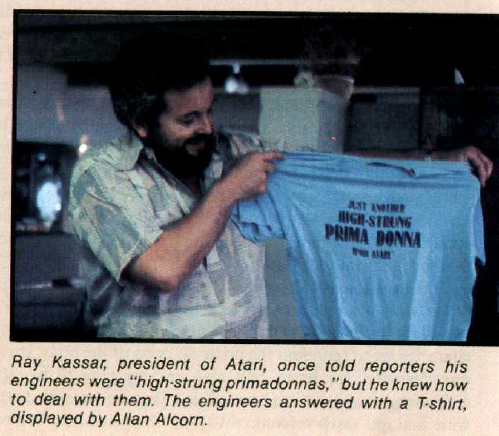
By September of that same year, the "Fantastic Four" left Atari and set out to prove Kassar was wrong. With the memo in hand, they sought out venture capital to start Activision, and it didn’t take long for word to get around on just how much money Atari was making. Activision became the world’s 1st 3rd-party software company in 1979, and the following year started releasing VCS games. Atari’s response was to sue Activision for trademark violations and theft of trade secrets (InfoWorld 8-4-80 article). An article in the June 1982 issue of Electronic Games (pg. 9) states both parties agreed to an out-of-court settlement involving a long-term licensing arrangement (reportedly to be a fixed royalty payment).
The lawsuit lasted nearly 2 years, during which 2 more 3rd-party companies entered the market – Games By Apollo and Imagic. During this time, Fairchild engineer Jerry Lawson had reversed-engineered Atari's VCS, wrote a programming manual for it, and started selling copies to anyone interested (he was involved with the lawsuit at one point, to show how it was possible for Activision to write software for the VCS without resorting to stealing trade secrets). Apparently confident it would win its lawsuit with Activision, Kassar continued to treat employees with indifference (InfoWorld November 28th, 1983). When Rob Fulop finished his excellent coin-op port of Missile Command for the VCS in late December 1980, Kassar rewarded him with a certificate for a free turkey and a letter thanking him for the contribution he made to the Atari team. From Rob Fulop:
| "I sat there, dumbfounded. I couldn't believe that I got a turkey for doing Missile Command. I didn't know a lot about business at the time. I was 23 years old. But I remember thinking, how stupid... I'm going to leave because of this, and all they had to do was give me $10k. If they gave me the keys to a car, I would have stayed and given them another 2 or 3 products." |
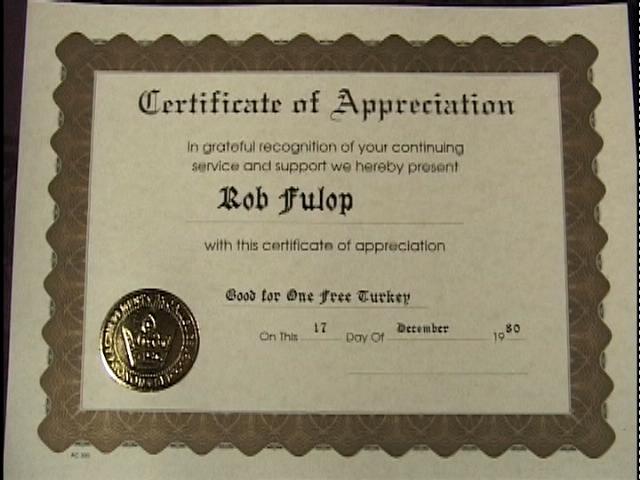
VCS Missile Command was released the following June and was an immediate hit with sales of 2-3 million carts. The next month, Fulop, along with 4 other people - 2 senior VCS programmers (Dennis Koble and Bob Smith), Mark Bradley (national accounts manager), and Bill Grubb (VP of Marketing and Sales) - left to found Imagic. And yet, Kassar still refused to budge on his policies. After Bushnell was ousted and Kassar personally sought to have Space Invaders licensed, Atari's net worth skyrocketed, which no doubt reinforced his belief that his leadership was driving the company's success, when in reality he was simply in the right place at the right time. And although he re-invested heavily in the company's R&D (who created some truly innovative products like the Cosmos handheld), he had no interest in releasing anything they created; all he could see at that point was the runaway success of the VCS, and he was determined not to change course.
By the start of 1982, the Atari VCS was the ‘king of the hill’, having captured some 80% of the home video game market. The first magazine devoted to covering video games in the U.S., Electronic Games, started in late 1981; there would be a half-dozen new magazines a year later. Consumer demand was so high that people would buy just about anything, regardless of quality. The 1981 holiday season was such a huge success that many distributors ran short of product, having failed to order enough; Atari's response was to force them to preorder everything for the entire year of 1982. Distributors, not wanting to be caught short again, were forced to play Atari's game. In February 1982, Tod Frye went to his manager, George Kiss, and informed him that both he and Howard Scott Warshaw were approached by 20th Century Fox to start up a new game company. At that point, Kassar finally realized that with them gone, Atari would have very few senior VCS programmers left, and capitulated in giving the engineers both royalties and credit for their games. Convinced that porting arcade games to the VCS was the most-profitable course of action after the huge sales for Space Invaders, Asteroids, and Missile Command, Atari aggressively went after obtaining the licenses for some of the most-popular arcade games at the time, but the arcade license for the biggest game of all time, Pac-Man, had already been secured in a deal with Namco in 1978. Frye, given the choice of porting either Defender or Pac-Man to the VCS, chose the latter. Pac-Man was already very popular by the time Frye started programming his version, which would have been summer 1981, and Atari's Marketing department went into overdrive promoting the fact they had the exclusive home cartridge license for it. Atari wildly over-produced the game, making 12 million carts, at a time when the installed user base was approximately 7 million. They were hoping for another "Space Invaders" effect of a game driving system sales to pick up the surplus, and to some extent it worked; nearly 8 million cartridges were sold at an astounding $37-$45 each, making it the best-selling VCS cartridge ever, and Atari ended up selling some 5 million consoles that year. The most-anticipated cart release of 1982 also helped Frye earn a reported $1 million in sales royalties, since we can pretty much rule out "word-of-mouth" helping sales of what was soon considered to be not only a bad knock-off, but one of the worst arcade ports ever done. Many liberties were taken - Pac-Man only looked left or right, monsters became flickering ghosts, fruit condensed into a single "multi-vitamin", dots ballooned into large "wafers", energizers became power pills, etc. The garish sounds and colors only added to the nightmare. Only years later did the world learn Frye was given a mere 4K to program it (same with Bob Polaro and Defender), instead of the 8K previously used for Asteroids. By the time 8K was offered to him (as Rob Zdybel claims, although Frye claims he was never offered it), the game was nearly done, which would have meant starting over. However, Atari never fully recovered from their decision to release it (and in the quantities it did) and the scathing criticism that continues to follow it to this day. If the VCS ever had a "jump the shark" moment, this game was it, for the VCS looked hopelessly obsolete immediately upon the game's release, especially next to technologically-superior consoles like the Intellivision and Colecovision. From Tod Frye (Next Generation, April 1998, pg. 41 review):
| "A while after Pac-Man was released, Ms. Pac-Man was developed with an 8K ROM by a three-man team in six months. The first Pac-Man was developed with a 4K ROM by just one man in five months. This 4K ROM was the big problem (Ed.: In subsequent comments, he said RAM was the big problem). My version also included a two-player mode and this drastically ate into what little ROM there was. After the release of the game, Atari set a new rule that
every game needed to have an 8K ROM (Ed. Not true. RealSports Volleyball and
Atari Video Cube were both 4K). Why wasn't the project allocated better resources? At the time the project was started, 8K ROMs weren't available yet (Ed.: Not True. Asteroids was 8K and came out the previous summer and the bank-switching scheme was developed 2 years prior to that, for Video Chess). Also, when we started doing the port, Pac-Man wasn't a particularly big game. 'Pac-Man fever' hit between the start and the finish of the project (Ed.: Pac-Man was already very popular by the time Frye started programming his version, which would have been summer 1981. Both Coleco and Entex had their hand-held versions out later that year, and Magnavox released K.C. Munchkin for their Odyssey2 in November 1981). I have no particular technical regrets when it comes to Pac-Man. I made the best decisions based on the technology available at the time. But six months later, would I have done it differently? Sure (Ed.: I'm sure millions of people who bought the game would have done things differently as well)." |
A video from the 2015 Portland Retro Gaming Expo shows Frye commenting on a new VCS version of Pac-Man and exclaiming he never understood why his version got so much criticism for the different maze layout, and for having the tunnel exits on the top and bottom, instead of on the sides like the arcade version. He also commented (in the Stella at 20 documentary) that he would have had a better flicker management routine had he had enough time to finish it (?), but he also claims he had a kernel working that used the same anti-flicker management system (using vertical separation and variable flicker) that Ms. Pac-Man used, but decided not to use it because nobody else had (?). In a keynote from the same show, Frye states he wish he had made a black background with a blue maze, but claims Atari had a rule against black backgrounds because it would have burned the maze into the CRT (apparently this rule didn't apply to space games...). This makes no sense since Atari touted the anti-burn-in effects of the VCS from day one, plus Frye included the color-cycling code routine in his Pac-Man game! I've also asked several VCS programmers - including Frye's Manager at the time, Dennis Koble - and nobody else recalls there ever being a rule or even a guideline regarding the use of black backgrounds. So Frye's unfounded claim appears to be nothing more than an excuse for his poor design choices.
The success of VCS Pac-Man only fueled the public's desire for more arcade titles. Warner's Manny Gerard personally contacted Kevin Curry of General Computer Corp. (GCC) in April 1981 to have GCC under exclusive contract with Atari to make games for them, and new chips were designed to allow for improved versions (the following year would see GCC's amazing conversion of Ms. Pac-Man). In late 1982, Kassar made a weak attempt to fend off the VCS's competitors with the 5200, but the console was nothing more than a repackaged Atari 400 computer (which was originally released in 1979) with quite possibly the worst controllers ever devised, plus it wasn't compatible with either the VCS or the 400.
For most people, VCS Pac-Man convinced them the system's limitations had been reached. Whereas Bushnell wanted to effectively kill the VCS too early in its life, Kassar hung onto it too long. Still, with an installed base of some 15 million consoles, companies continued to spring up, fully intent on supplying those owners with new software. With the Atari vs Activision lawsuit settled, the path was clear for anyone to sell software for the VCS, and by the end of 1982, some 2 dozen companies did just that, though most of it was inferior. Atari didn't help matters with inferior ports like Defender and Pac-Man, or ill-conceived concepts such as the 4-game SwordQuest contest. The battle to win licenses for the most-popular arcade titles raised the stakes for larger companies who could afford to play that game, like Mattel, Coleco, and Parker Brothers. Arcade companies recognized this, and would often insist on deals for 2 or more games. For example, Parker Brothers was only able to secure the rights to Nintendo's popular Popeye game if they agreed to buy the unsuccessful Sky Skipper as well. After 20th Century Fox licensed its hottest property, Star Wars to Parker Brothers, and their failed attempt to lure away Atari's remaining senior VCS programmers, they formed their own division, Fox Video Games, and subcontracted at least 4 companies (including Sirius Software) to write games for them - some based on their movies and TV shows (Atari had been first with this approach with VCS Superman, but never fully capitalized on it). Parker Brothers struck gold with their first 2 releases: Frogger and Star Wars: The Empire Strikes Back. Determined not to miss out on another property like Star Wars, Atari quickly locked up licensing deals with LucasFilm and Steven Spielberg. They also tried a tie-in with Warner-owned DC Comics, only to realize pack-in comic books don't result in more sales. The bidding frenzy, as well as Atari's own hubris, reached their absolute zenith with Atari's E.T. game.
E.T. the Extra-Terrestrial was Atari's 2nd movie tie-in game, after Raiders of the Lost Ark, and the first bad one (in what would become a long line of). Atari paid an obscene amount of money to Spielberg for E.T., which was the most-successful movie ever at the time, and planned to have the game on store shelves by Thanksgiving, in time for "Black Friday" and the 1982 holiday shopping season. Kassar maintains he tried to convince the head of Warner, Steve Ross (who orchestrated the deal) it was impossible to deliver a game in so short a time frame, but that Ross insisted Atari had to do it. Although another executive stated when he told Kassar the same thing, he replied, "E.T. is such a hot property, whatever we put out will sell." (InfoWorld December 5th, 1983, pg. 146). Unfortunately, due to the deal not being finalized until late July and pressure to get the game on the shelves in time for Christmas, programmer Howard Scott Warshaw was left with an unbelievably short timeframe of 5-1/2 weeks (which meant little or no game testing was done), at a time when game development took several months. Warshaw calculated he produced game code (finished, debugged, and documented) at 13 times the industry average! An article from the Chicago Tribune, dated 11-7-1982, stated Atari planned to spend $5 million advertising the game, with Atari's VP of Coporate Advertising, Jan Soderstrom, proclaiming E.T. "Will be as big a hit if not better than Pac-Man." Not learning from their mistake with Pac-Man, Atari over-produced the game, making between 4-5 million (mainly because they needed to sell that many in order to turn a profit), and only selling about 3.5 million. Some of the unsold copies (along with Pac-Man and other products) ended up being dumped in at least 2 landfills.
On December 8th, 1982, Atari dropped their own belated "Pearl Harbor" attack on Wall Street and announced their 4th Quarter sales estimates were only a 10-15% increase, instead of the 50% they originally predicted. It's important to note that they weren't losing money at that point, they just weren't going to make as much! Warner's stock took a big hit after that (overall the stock market dropped 29 points in the 2 days after Atari's announcement), as did all video game-related stocks. The following day, Mattel announced they actually lost money that quarter, which didn't help matters. The day after that, Perry Odak, Atari's President of CED, stepped down, basically taking the fall for the Wall Street announcement (NY Times article); Odak soon joined Nolan Bushnell's Catalyst group (article). Imagic had planned on going public the following week, but the news forced them to withdraw their plans. According to the editorial in the March 1983 issue of Video Games (pg. 6), analysts had been predicting a "shakeout" in the video game business for about a year before Atari's announcement, and all the negative reports that followed in the months after only fueled the fears of a market crash. Still, the news shocked most analysts and started Atari's precipitous fall, as well as the industry's.
The coin-op industry was even more susceptible to the increased competition. Arcade earnings were but a fraction of home sales, but were still far below what they had been. Like home games, operators saw the same drop in 1982-83. Laserdisc games were the last-ditch efforts to sustain their earnings growth, and when that failed, most arcades closed, and operators sent many an arcade game to the dumpster.
Atari, seeing their 4Q troubles ahead and their market share dropping to 60%, tried to restructure their distribution network a month before. They had some 130-140 distributors for their products - far too many than was needed - and some started getting into price wars with each other. On November 1st, Atari told all their distributors their contracts were cancelled and that only a small number of them would be awarded exclusive contracts. Since Atari never bothered to have exclusive distributor contracts prior to then, their competition simply used the same distributors. Those who were forced to preorder for 1982 and were later dropped by Atari simply started shipping unsold product back to them. Since Atari didn't audit the distributors they had dropped, they were forced to buy back whatever they were sent.
Nearly all of the 3rd-party VCS game companies that started up in 1982 closed down in 1983, and yet by the end of 1983, nearly 3 dozen more companies had sprung up. Seeing Activision's success, they were convinced the market would soon level off and become stable (much like how some Titanic passengers felt the ship would level off and stay afloat). At this point, there was literally a glut of product - more than there was shelf space available for them - and most of it was awful. Atari's market share fell to 40%. As these companies quickly collapsed, they gave their inventory to distributors for practically next-to-nothing, instead of throwing out their product (Atari had the right idea, but for the wrong reasons). People aren't going to spend $25-$40 for the latest games when they're next to games selling for $2, especially after being burned by the marketing hype for Pac-Man and E.T. Meanwhile, Kassar continued to invest heavily in R&D with no long-term plan on what to do with anything that was created. By the end of 1983, Warner was looking at half a BILLION in losses, and the industry had passed the point of no return.
IEEE spectrum mentioned the situation in an article in their January 1984 issue, sub-titled "Chaos in Home-Computer and Video-Game Markets" (pg. 81):
| There was considerably less optimism last year as sales slowed in the home-computer and video-game industries. Startup video-game companies proliferated in 1982, and while industry sales for video games grew by approximately 25 percent in 1983, the number of video-game cartridges produced increased by many times that amount, flooding the market. Also, consumers began moving away from the purchase of traditional video games and towards home computers. As a result, Atari Inc. of Sunnyvale, Calif., a subsidiary of Warner Communications, dumped truckloads of game cartridges in New Mexico after absorbing heavy losses (Atari said the cartridges were defective). Several recently started companies - like U.S. Games, a subsidiary of Quaker Oats; Data Age; Fox Video Games; and Games by Apollo - closed their doors. Imagic Corp. of Los Gatos, Calif., sold its inventory and cut staff: games that previously cost $30 now reached the consumer priced near $5. Even Activision Inc. of Mountain View, Calif., which held on to profit margins longer than most other companies, posted a large loss late in the year. |
From Howard Scott Warshaw:
| "Atari, for years, was using the leverage that they had to just screw distributors everywhere. When they had a hot game, they would force distributors to buy copies of the old games that weren't selling anymore, just to get copies of the new game. This is the kind of stuff they were doing. So when things started to turn on them, everyone in the industry was waiting to jump on them with both feet. That's what killed Atari - the ill will that they had generated through their cutthroat business practices on their way up." |
Both CEO Raymond Kassar and Executive VP Dennis Groth were charged by the Securities and Exchange Commission with insider trading from selling personal shares of company stock minutes before the infamous December 8th, 1982 Wall Street announcement (New York Times article). Atari's stock that day dropped from $52 a share to $36, a 30% drop; Kassar sold his shares 40 minutes before the announcement. In early 1983, two stockholders, Meryl and Richard Gloven, filed suit against Warner Brothers, charging Chairman Steven Ross sold some 140,000 shares of his stock prior to Atari's Wall Street announcement (April/May 1983 issue of Vidiot news blurb), so the man who pushed for E.T. to be rushed to market turns out to have been guilty to insider trading to an even larger degree. Imagine that. But Ross was only starting turn Atari upside-down...
As a result of being caught by the SEC, Kassar was finally forced to resign 7 months later, in July 1983, and was replaced by James J. Morgan. Warner CEO Steven Ross actually interviewed Morgan, who worked for cigarette company Philip Morris USA and helped develop the Marlboro Man advertising campaign; yes, another ex-marketer from another static business field. Morgan took 2 months off before starting as the new Chairman and CEO of Atari, in September; John Farrand from the coin-op department was the interim CEO. Morgan's first decision was to implement a 30-day freeze on all development. He also fumbled with deciding where to have the 800XL manufactured - a delay that eventually cost Atari to miss what would have been a very profitable Christmas season for them that year, at a time when there was a big push in the industry towards home computers. The few 800XLs that reached store shelves were quickly sold, with a large percentage of those being returned due to being defective. In the summer of 1984, Atari was some $400 million in debt, and on July 1st, Warner Communications basically blindsided Morgan and broke up the company, retaining the arcade and AtariTel divisions and selling off the C.E.D. (Consumer Electronics) and H.C.D. (Home Computer) divisions to Jack Tramiel, the founder of Commodore, and a group of unknown investors for $240 million. Warner received no cash, but received $240 million in long-term 'promissory' notes and warrants for a 32% interest in Tramiel's new venture. Tramiel, in return, received warrants giving him the right to purchase one million shares of Warner common stock at $22 a share. In other words, Ross gave Atari away. This was basically an accounting maneuver by Ross to improve Warner's stock to stop a hostile takeover by Rupert Murdoch. Ross had previously rejected Philips offer to purchase 100% of the company because he wanted to keep a stake in Atari.
In conclusion, there were many factors which lead to the market crash of 1983-84:
Warner's management style clashed with Nolan Bushnell's, and led to him leaving the company. He was replaced by Ray Kassar, who had no experience with the video game industry, and was either unable or unwilling to adapt to it. His outdated management policies left Atari with no long-term plans on how to proceed beyond the products they had, and his short-sightedness/lack of vision let to competitor's consoles using next-gen processors that Atari paid to develop. He also failed in his primary task to create a corporate structure, instead choosing to run the company like an "emperor" with him having to approve every decision. Coupled with his penchant for setting people against each other, the result was an atmosphere of paranoia and fear, which led to much employee turnover, especially in Management.
Atari relied on the VCS for too long and was too late in replacing it with next-gen hardware. Upon Bushnell's exit from Atari, he implored on Gerard and Kassar to stop cutting back on R&D. With the VCS's slow sales in its first year, Bushnell felt it was essential for the company's future to invest in developing their next console, especially with the increasing advancements with the technology. Gerard and Kassar looked at the VCS as the next record player, only needing to increase marketing and advertising while releasing more games for it. The 400/800 hardware was initially designed to be the next console after the VCS, in 1979, but Kassar instead repurposed it for a new line of home computers (400/800). By the time competitors Mattel and Coleco started gaining market share with their Intellivision and Colecovision systems, the same 400/800 hardware was quickly redesigned and released as a console (5200), but this was late 1982 and far too late to make much difference.
Atari's engineers were the 'lifeblood' of the company. Instead, Kassar refused to compensate Atari's engineers for their efforts, or credit them on the games they created, viewing them as insignificant and easily replaceable, and the result was Atari ended up creating their own competition with the rise of 3rd-party software companies (whereas before they enjoyed complete control of the VCS), which led to a glut of product. By the time Atari instituted a royalty program and started crediting designers, it was too late.
Atari failed to implement using larger ROM chips in cartridge production years before, and instead focused on constantly trying to maximize their profit to satisfy their "bottom line" (i.e. greed). 8K bank-switched ROMs were developed for Video Chess back in 1979, but were only used once (for Asteroids) prior to Pac-Man. 8K versions of games like Pac-Man and Defender would have been more faithful and generated more sales, but Atari only decided to abandon 4K ROMs after realizing that after the fact with Pac-Man.
Atari's fabled R&D created dozens of amazing products, most of which would have helped Atari maintain their technological edge over their competitors and helped them branch out into other fields. Instead, millions of dollars and countless hours were wasted on projects that were either shelved or later sold off (at a loss) and released by other companies.
Atari moved production of its consoles and computers to outside the U.S. (to Mexico, Taiwan, etc), which allowed others to steal their technology and create dozens of VCS-knockoffs, helping fuel an influx of inferior 3rd-party software.
Atari's Marketing department ended up dictating not only what games should be done, but in what timeframe. The lesson of trying to force game development to fit some preconceived 'deadline' should have been learned with E.T., but in the 18 months that followed E.T.'s release, Marketing's scheduling demands only created more pressure on the programmers to meet them.
The E.T. debacle, which should be placed squarely on Warner CEO Steve Ross. Ross paid Steve Spielberg anywhere between 20-25 million for the rights to the game, all in a vain attempt to win him over from Universal to Warner. In the end, all Warner got from wooing Spielberg was the Gremlins franchise, which was hardly worth losing Atari for, along with Pelé and the Cosmos NASL team as well (article).
The mess with how Atari handled their distributors was yet another problem that could have been avoided. They forced distributors to preorder for all of 1982, but mistakenly gave them the option to return any unsold product for credit. If 3rd-party companies hadn't dumped their inventories onto an already-oversaturated market, Atari and larger companies like Mattel and Coleco might have recovered from their own mistakes. Instead, much like E.T.'s ending, the whole industry went into hibernation until Nintendo came along to revive it.
As a footnote, Manny Gerard was interviewed for the Antic podcast on September 8th, 2015 and he admitted Atari made some mistakes, but claimed the biggest one was allowing 3rd-party software companies to make games for the VCS. Naturally, he failed to acknowledge the fact that the formation of 3rd-party software company Activision was solely due to Kassar's poor treatment of Atari's programmers. As Rob Fulop opined, it would have taken very little (financially) to keep people from leaving. In 2025, Gerard was again interviewed for The Legend of SwordQuest podcast shortly before his death, and in part 5 ("Decent Into Darkness"), Gerard mentions asking Kassar why he didn't license Donkey Kong, which was the most popular game at the time, allowing Coleco to get it to use to help launch their Colecovision system. Kassar's response was that Coleco wanted $2 royalty per cartridge and he wasn't going to pay that much! With Warner behind them, money wasn't Atari's problem, their management was. That's why I have management listed above as the first issue, because that alone directly or indirectly led to all the other issues mentioned. Gerard convinced Warner founder Steve Ross to purchase Atari, and then later brought in Kassar to lead it, but who ultimately destroyed it. Letting Kassar run the company was the biggest mistake in my opinion. Atari was first described to Gerard as a "fast growing technology-based entertainment company". Whatever possessed him to pick an ex-marketing VP from Burlington textiles to run Atari, we'll never know (he passed away in December 2023 at 90 LINK. Kassar passed away 6 years earlier LINK).
Q: What happened to Atari after Warner
Communications sold it in 1984?
A: The Atari that everyone knew and loved (1972-1984) is long gone. In its absence, there have been a string of "imposters". The infamous market "crash" of 1983-84 decimated the video game marketplace. It impacted every company, including Atari, and by early 1984 only a few companies remained in business.
After being ousted from Commodore, Tramiel set up his own company, Tramel Technologies, Ltd. (he intentionally misspelled his name since most people incorrectly pronounced it as "tra-meal" instead of "tra-mel") on May 17th with $75 million from unnamed investors, and renamed his company Atari Corporation with the purchase of these Atari divisions (InfoWorld August 6th, 1984 article, pg. 51-52; A History of Tramel Technology/Atari article). The coin-op division remained with Warner and became Atari Games. Morgan returned to Philip Morris USA, where he later became famous for his claims that cigarettes are no more addictive than gummy bears, and that Philip Morris had never attempted to intentionally market tobacco products toward minors. Moran later became President and CEO of Philip Morris USA in 1994 and retired 3 years later. In 2000, he testified for Philip Morris USA in a case brought against them by someone who had smoked Philip Morris's cigarettes and died of smoking-related illness (LINK).The following is a list of all the various divisions within Atari that existed at some point between 1972 and 1984:
AMPLIFONE CORPORATION
ATARI PRODUCTS CO.
ATARI PUBLISHING - Became AtariSoft
ATARITEL
COIN-OP
CONSUMER - Became CONSUMER ELECTRONICS (CED) in 1982.
COMPUTER/PERSONAL COMPUTER - Became HOME COMPUTER (HCD) in 1982.
CONSUMER PRODUCTS GROUP
CORPORATE RESEARCH
CUSTOMER SERVICE
CYAN ENGINEERING PRODUCT
EDUCATIONAL
ELECTRONIC BOARD GAME (later renamed ELECTRONIC TOYS & GAMES)
ELECTRONIC DISTRIBUTION
ENGINEERING COMPUTER
INTERNATIONAL (sales and marketing)
PINBALL - From 1976 to January 1978, when it was folded into Coin-Op.
PROFESSIONAL PRODUCTS - shut down in 1980.
RESTAURANT OPERATING
SOFTWARE PRODUCTS
THE ATARITEL DIVISION:
The history of this division can be traced back to Atari's Cyan Engineering,
when in 1976 they began work on a video telephone. Codenamed "Phoney", it was headed by Larry Emmons, Dave Stokes, and Michael Cooperhart. Joe Keenan suggested it might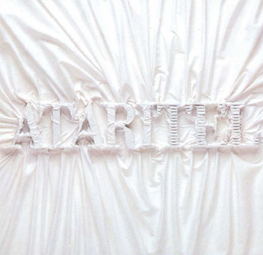 have potential as a toy, but 3 years later the project was mothballed. In 1981 it was decided to revive the project, now codenamed "Project Falcon" (first mentioned in the March 1983 issue of The Video Game Update,
pg. 3, and again in the April 1983 issue, pg. 1. It was also covered in the June 1983 issue of
Video Review, pg. 22-23).
The new division was headed by Steve Bristow, and Atari spent 2 years designing new telecom products for consumers. Both Porche Design and Morison Cousins Associates were commissioned to develop product designs.
The July/August 1983 V2N2 issue of Atari Age
(pg. 7) mentions Atari was close to unveiling their latest product division, AtariTel. The 1983 V2N7 issue (exact date unknown) of Atari Life
also mentions Project Falcon becoming AtariTel - Atari's 4th product division (actually 5th if you include the short-lived Pinball division) - and features quotes from AtariTel president Peter Wensberg. Atari's own Cyan Engineering developed at least one of the new phones, codename "Project P", which was the Picture Phone that allowed you to send digital photos to someone while you were talking to them. The phone used custom VLSI. Future variations planned were for a color photo version, and one that processed video and produced caricatures or 3-D pictures, along with the ability to print out photos. Here's the commercial Atari had created for their Telectra model.
Atari planned to start releasing AtariTel products by early 1984, but soon after AtariTel's announcement, the company went under another restructuring, with James J. Morgan replacing Raymond Kassar. The AtariTel division was shut down soon after that. In December 1984, Warner sold off the AtariTel division to
Mitsubishi, who ended up releasing the Picture Phone through their Santa Clara, CA-based subsidiary, Luma Telecom, Inc., who renamed it the Lumaphone. Michael Current's website covers the complete history of the AtariTel division.
have potential as a toy, but 3 years later the project was mothballed. In 1981 it was decided to revive the project, now codenamed "Project Falcon" (first mentioned in the March 1983 issue of The Video Game Update,
pg. 3, and again in the April 1983 issue, pg. 1. It was also covered in the June 1983 issue of
Video Review, pg. 22-23).
The new division was headed by Steve Bristow, and Atari spent 2 years designing new telecom products for consumers. Both Porche Design and Morison Cousins Associates were commissioned to develop product designs.
The July/August 1983 V2N2 issue of Atari Age
(pg. 7) mentions Atari was close to unveiling their latest product division, AtariTel. The 1983 V2N7 issue (exact date unknown) of Atari Life
also mentions Project Falcon becoming AtariTel - Atari's 4th product division (actually 5th if you include the short-lived Pinball division) - and features quotes from AtariTel president Peter Wensberg. Atari's own Cyan Engineering developed at least one of the new phones, codename "Project P", which was the Picture Phone that allowed you to send digital photos to someone while you were talking to them. The phone used custom VLSI. Future variations planned were for a color photo version, and one that processed video and produced caricatures or 3-D pictures, along with the ability to print out photos. Here's the commercial Atari had created for their Telectra model.
Atari planned to start releasing AtariTel products by early 1984, but soon after AtariTel's announcement, the company went under another restructuring, with James J. Morgan replacing Raymond Kassar. The AtariTel division was shut down soon after that. In December 1984, Warner sold off the AtariTel division to
Mitsubishi, who ended up releasing the Picture Phone through their Santa Clara, CA-based subsidiary, Luma Telecom, Inc., who renamed it the Lumaphone. Michael Current's website covers the complete history of the AtariTel division.
THE COIN-OP DIVISION:
In January 1985, AT Games Inc. was established by Namco Limited and Warner Communications for the purpose of taking over Atari Games. An agreement was reached in early February where Namco America Inc. would own a majority of the company and handle the management of it. Namco would hold about 45% interest in the business and WCI would hold closer to 40%, with about 20% held by Atari Games officers. Atari Ireland Limited (manufacturing plant at Tipperary) and Atari International (U.K.) Inc. (sales) were included in the transaction. Later that same month, AT Games was renamed to Atari Games. The acquisition gave Namco the exclusive rights to distribute Atari games in Japan. Soon after, Namco founder Masaya Nakamura began losing interest and patience in Atari Games, as he viewed Atari as a competitor to Namco and was hesitant to pour additional funds and resources into the company. Nakamura also disliked having to share ownership with Warner Communications, fearing it could lead to him losing control of Atari Games and cause Namco to go under. Namco president Hideyuki Nakajima grew frustrated with Nakamura's attempts at marketing Atari video games in Japan, and had constant disagreements with him over which direction to take the company. Viewing the majority-acquisition as a failure, Namco America sold 33% of its ownership stake to a group of Atari Games employees led by Nakajima in 1987. This prompted Nakajima to resign from Namco America and become president of Atari Games. Atari Games purchased the Barrel of Fun and 2001 Entertainment Center chains on September 1st, 1987, effectively getting back into the arcade business. They also got back into the home video game business with the establishment of Tengen, a publisher that challenged Nintendo's licensing restrictions for the NES by selling several unlicensed games, which included ports of Namco arcade games. Though its sell-off made Atari Games an independent entity, Namco still held a minority stake in the company and Nakamura retained his position as its board chairman until the middle of 1988.
When Warner merged with Time in 1989, a Time-Warner Interactive label appeared on their arcade games (in early 1994, Atari Games would officially be renamed that, as was Tengen). In 1990 Namco sold its Atari Games shares back to Warner but bought the arcade chains, with Nakajima staying with Atari. On March 5th, 1996, Time-Warner sold Time-Warner Interactive to WMS Industries (the merger of Williams and Bally/Midway, when Williams purchased them in 1988), who turned around and spun off part of its Midway Manufacturing division as Midway Games. T-WI was renamed Atari Games and became a subsidiary of Midway Games as a result. On December 22nd, 1999, Midway renamed Atari Games Corporation to Midway Games West Inc., to avoid confusion with Hasbro Interactive's Atari Interactive division. The Atari logo for home conversions of Atari's arcade games during this time appeared under the Midway Home Entertainment label. In spite of all this corporate shuffling, a few of the Atari veterans, such as Ed Logg and John Skruch, remained. Ed Logg, whose credits include the arcade versions of Asteroids and Centipede, as well as VCS/2600 Othello, was still there by the summer of 1999. Midway shut down Midway Games West in February 2003, but it remained an entity. On February 12th, 2009, Midway Games filed for bankruptcy. Ironically, Warner Bros. purchased most of Midway's assets on July 10th, 2009 for approximately $49 million.
THE CONSUMER DIVISIONS:
After taking over Atari, Tramiel immediately ceased all video game development, cancelled several projects (including the 7800 and 600XL), and fired 700 employees, as his focus was on developing and releasing a new line of home computers (BusinessWeek article, July 23rd, 1984, pg. 90-91; Electronic Games article, October 1984, pg. 14; Computer Games news, November/December 1984, pg. 20), starting with the Atari STs; the previous issue of Electronic Games had a 4-page article announcing the 7800 and at least 12 games. The December issue of Electronic Games reiterated Tramiel's plan to focus on computers (article), as did the February 1985 issue of Big K (article). The 7800 was developed by GCC and initially announced the 7800 on May 22nd, 1984 (article); it was officially shown at the 1984 Summer CES (article) along with the initial games and accessories. According to GCC's Steve Golson (VIDEO), Atari planned on releasing it later that year in time for the holidays. With the sale of Atari soon after, Tramiel made it clear he had no intention of paying off the remainder of GCC's contract with Atari Inc., which was to pay for the 7800's development. Instead, he offered to sell it for $50, instead of the planned $150, meaning GCC would basically be paid nothing for it! Legal wrangling between GCC, Warner Bros., and Atari Corp soon ensued. Warner claimed the issue was between GCC and Atari and that Warner had no legal obligation, which is ironic considering it was Warner who personally sought to have GCC under exclusive contract to develop home games for Atari's systems. By the end of the year, Tramiel finally decided to pay off GCC's remaining debt, and then proceeded to 'mothball' the system.
At the 1985 Winter CES show, Jack Tramiel stated Atari was going to change its image from that of a game company to that of a microcomputer organization, and announced no less than 7 new computers (8-bit 65XE, 65XEM, 65XEP, 130XE; 16-bit 130ST, 260ST, 520ST (ROM article, February/March 1985 V1N10, pg. 54). Side note: prior to Tramiel taking over Atari, Atari was in early talks with Nintendo over a possible deal for Atari to handle distribution of Nintendo's NES, but with Atari in chaos at the time, Nintendo decided to release it themselves. 1 year after the takeover, the media confirmed there were no plans to release the 7800 (Computer Entertainment news blurb, August 1985, pg. 71). 2 years after the takeover, Tramiel, seeing Nintendo's success with their NES console, decided to get back into the video game market by resurrecting and re-releasing existing hardware systems (VCS/2600, 400/800/XL) that were originally developed by Atari Inc., with either a new case, a new name, or both. The VCS/2600 became the 2600 JR, and the 65XE computer became the XEGS console. Both new and unreleased games were released for all of them, but the main reason for their release was to sell off the mountains of games Atari still had in their warehouses. Some former programmers, such as Bob Polaro, were sub-contracted to either finish some of their prototypes or program new games. Tramiel also decided to release the 7800 console that he had been sitting on for nearly 2 years, but at that point and with Nintendo's NES already building an insurmountable lead in the market, it was clear the 7800's technology was looking dated, as were the initial game releases.
With their line of 16-bit ST computers failing to compete against IBM PCs and its clones, Atari decided to make a serious attempt to recapture some of the now-hot video game market again, buoyed by the huge success of both Nintendo and Sega. Side note: Atari also had the opportunity to distribute Sega's Genesis in 1988, but the deal ultimately failed to materialize, again due to Jack Tramiel. In 1989, Atari purchased the Handy handheld gaming system being developed by Epyx and released it as the Lynx, to moderate success (5 million were sold). On January 1st, 1992, the VCS/2600 was officially discontinued, along with the 7800. According to VP of Marketing Dana Plotkin, the entire inventory of games for both systems was sold to Consolidated Stores Corp./Odd Lots (a department store chain based in Ohio), with no plans to produce more; the reason given was to focus on the Lynx. In November 1993, Atari released the Jaguar game system, which proved to be the company's undoing. Hampered by poor business ethics and lack of major advertising, as well as a lack of any major 3rd-party support (a little over 100 games were made for it, over 5 years), the Lynx was eventually discontinued in 1994; the Jaguar would follow suit 2 years later. Again, a combination of poor treatment of 3rd-party developers and suppliers as well as a lack of any serious advertising resulted in only 125,000 Jaguar systems being sold by December 1995, with another 100,00 left in warehouses. A settlement with Sega over patent infringements gave Atari a brief lifeline of cash (Sega purchased $40 million of Atari's stock and paid Atari $50 million to license over 70 patents from 1977-1984). Both companies agreed to cross-license up to 5 games per year through 2001, but ultimately nothing came of it, and the Jaguar was discontinued by early 1996. On February 13, 1996, Atari agreed to merge with with disk drive maker JT Storage Inc. (JTS) in a reverse takeover to form JTS Corporation (see Michael Current's page for more details as well as a copy of the agreement between both companies). The reverse merger was completed on July 30th, 1996. Financially, the merge consisted of Atari's "acquisition" of JTS for approximately $112.3 million. Atari became a division of JTS with Jack Tramiel joining JTS's board of directors, and most Atari employees were dismissed or relocated to JTS's headquarters. In his resignation, former Atari alumni Don Thomas wrote a short, insightful bit about the merger and the history leading up to it that asks more questions than it answers.
On February 23rd, 1998, JTS sold substantially all of the assets of the company's Atari Division, consisting primarily of Atari home computer games and the intellectual property rights and license agreements associated with such games (the "Atari Assets"), to Hasbro Interactive AKA HIACXI, Corp. ("HIAC") for $5 million in cash. HIAC XI, Corp. was a wholly-owned subsidiary of Hasbro Interactive, Inc. created in Delaware for purchasing Atari. In May 1998, Hasbro Interactive renamed HIAC XI, Corp. to Atari Interactive, Inc. The following is a brief summary of what Hasbro got (read the entire 8-K form that was submitted to the Securities and Exchange Commission regarding this transaction, which specifically lists some of the things):
| Atari Hardware Platforms • Atari 2600 Key Marks • Atari |
The update of Centipede came (in small part) from the ashes of Atari Corp. Interestingly, Hasbro resurrected the Atari name and logo; many of their classic releases during that time (Atari Arcade Hits 2, for example) appeared under the Atari name (ad).
On December 6th, 2000, Hasbro entered into a "long-term licensing agreement" with French publisher Infogrames Entertainment SA (IESA), wherein Inogrames acquired 100% of Hasbro Interactive (which included the Atari bits they owned - article and sales report). Infogrames then renamed it to Infogrames Interactive, Inc. On May 7th, 2003, Infogrames officially reorganized its subsidiaries into Atari-branded names, which included renaming Infogrames Interactive, Inc. to Atari Interactive, Inc. On October 2008, Infogrames completed its $11 million stock purchase of Atari, making it a wholly-owned subsidiary of the French publisher. In May 2009 Infogrames announced it would be changing their name to Atari SA. In April 2010, Atari board member and former CEO David Gardner resigned, and Atari co-founder Nolan Bushnell joined the board!
In January 2013, Atari US filed for bankruptcy and planned to sell all of its assets - including the famous "Fuji" logo - in an effort to distance itself from its parent company, Atari SA (Forbes article). After approaching some 180 potential buyers (Wall Street Journal article), Atari was unable to find one willing to purchase everything, and auctioned off everything instead (Gamasutra article).
In June 2017, Atari announced a new VCS system, codenamed Project Ataribox. This is a Linux-based gaming PC in an original VCS-styled case. 2 models were available, the base or "Onyx" all-black model and a Collector's Edition woodgrain (or "black walnut") model. 2 different wireless controllers were available as well, the classic (similar to the standard Atari joystick) and the modern (gamepad). Preorders were taken in May 2018, with initial shipments in December 2020 and worldwide shipments in June 2021. In April 2021, 2 new divisions were created - Atari Gaming and Atari Blockchain. CEO Frédéric Chesnais stepped down and Wade J. Rosen took over. In November 2021, Atari announced Atari XP, which was their effort to release new VCS/2600 cartridges. The first 3 were Aquaventure, Saboteur, and Yars' Return; the first 2 were unreleased prototypes, and the 3rd was a lousy hack of Yars' Revenge that was initially available on several Flashback models (LINK). These were sold either as cartridge-only (for $50 each) or as boxed Limited Editions (for $150 each). Every Standard Edition Aquaventure cart had the pcbs installed incorrect, and replacements were sent out. In June 2022, Atari announced 10 more VCS/2600 carts to be released (for $100 each), for the company's 50th Anniversary Collection. Adventure and Missile Command were the first 2 announced, with Warlords, Super Breakout, Crystal Castles, Haunted House, Yars' Revenge, Centipede, Asteroids, and Gravitar announced soon after.
|
SOFTWARE |
Q: How many different games were made for the VCS/2600?
A: At last count, there are 507 unique, original games that were officially released between 1977-1992, not counting titles that were renamed or slightly altered (128) and unreleased prototypes (240). If you include all the pirate clones and unauthorized versions (well over 7,000), and homebrews (over 400), the grand total swells to over 9,000! And then there's the 1,000+ hacks that have been created over the years...
Q: Have any new VCS/2600 games been released lately?
A: Well over 100 new games have been developed for the Atari VCS/2600 since the mid-1990s. Commonly referred to as "homebrews", most of these can either be purchased on cartridge or downloaded for use with an emulator or to make your own cartridge. Here is a partial list of new games recently released:
Q: Where can I download game instructions?
A: Several sites offer manuals online, in text, html, and PDF formats:
Q: What are the most and least popular games?
A: This can be a subjective matter, of course, but here are some of the most popular:
Here are some of the least popular:
Q: What are the most common and most rare games?
A: The simple law of supply and demand is the biggest determining factor; the more popular a game was or the more copies that were produced back in the day, the less valuable (monetarily) a game is worth. Some of the best and most popular games are only worth a few dollars at most. It's the games from small companies with production runs limited to a few hundred or even a few dozen that are worth more to collectors, since they're the hardest to find. Other factors are the condition of the cart and the packaging, what label variation it is, and whether the cart is loose or includes the box and manual (CIB or Complete In Box), and if so, whether or not the box is sealed. Several sites offer online price and/or rarity guides, as do several books. Generally, you'll find higher prices on Ebay than you would through online message boards.
As for which game is the rarest, that game is Air Raid by Men-A-Vision. This was the one and only release from this company, which has a unique, blue, T-bar handle-shaped cartridge casing. Less than a dozen copies have been found since the mid-'90s. A boxed copy went up for sale on eBay in 2010, and sold for a staggering $31k - nearly 10x the value of a loose cart. And like most rare carts, it's a horrible game (to play). What's worse, the game is actually a hacked/pirated version of U.S. Games' Space Jockey (a game that's currently worth about $3 boxed)!
Q: What VCS/2600 software was announced but never released?
A: Atari Compendium has a list for most with photos and related info here.
Q: What was the GameLine and what games were available for it? Were there any other services like it?
A: GameLine was a service offered by Control Video Corporation that allowed you to download games to the VCS/2600 over regular phone lines via the use of their GameLine Master Module. The complete kit contains the Master Module (an 8K RAM cartridge with internal 1200 baud modem - more tech info can be found on the Stella Archive), telephone connecting cord, a duplex T-adapter, owner's manual, registration guide, GameLine membership cards, and "temporary" game directory & instructions. It originally sold for $49.95 and there was a one-time membership fee of $15. Charges were about $.10 a game or $1 for up to an hour of play. Contest games were $1 and there was a $.50 charge to enter a score. Once it connected, it downloaded the menu program to the battery-backed 2K of RAM. A title screen appeared and "Assembly of Trumpeters For Reveille (First Call)" played. Next, a screen appeared for you to enter a 3-digit number for your ID, and after that another screen where you selected the game you wanted via a 3-digit number, or you could enter 999 for a special "browse" menu. Once the game loaded, a screen would appear with both the game's name and the company who made it, and a tune very similar to the German Army WWI bugle call "No. 2 Battery" played. On your birthday, a screen would appear with the message, "Happy Birthday! All of your play today is free!" while the first 2 bars of "Happy Birthday" played. One of the game catalogs that was archived lists 76 games which included Save The Whales - a game long thought to be vaporware until it was found years later. The GameLine system became QuantumLink (also known as Q-Link), an online service for Commodore computer users, which became America On-Line, the most successful online service ever. See Dan Skelton's GameLine article for photos and more information and a complete list of games that were offered, along with footage of it running.
2 other similar services were close to going into service at the time. One was a joint venture between Atari and Activision in 1983 called Electronic Publishing Systems (EPS). They developed the "Electronic Pipeline", a game service for the Atari VCS/2600 that was to sell wireless game cartridges with which users could select and play up to 40 different games each month for a low monthly subscription fee. A TV commercial was created for it, and the service was in alpha testing and a mere 4 days from installing the transmission equipment in the first test market when it was indefinitely postponed due to Warner's sale of Atari in 1984.
The other was "Project Zelda", a top-secret plan to distribute games online (via cable). From my interview with Steve Kranish (who designed the head end hardware):
| The basic idea was that Parker would provide a TV channel signal to cable operators that contained the multiplexed (interleaved) data for their game cartridges. Parker would sell – or the cable operators would subsidize – a special cartridge for the Atari 2600 that would plug into the 2600, and had a cable that would connect to your cable box. In the 1982-83 timeframe, the only distribution channel for games was physical hardware, and cartridges dominated the market. Someone decided there must be another way to distribute games. The chosen solution was the rapidly expanding field of cable TV. This was during the time when Beverly, MA was first wired for coax, so we had cable access available locally." The cartridge menu software worked similar to the GameLine, in that since the menu contents would change frequently, they had to first be downloaded before they could be displayed. At some point, Parker got cold feet and abruptly cancelled the project. The official reason given was Atari - being owned by Warner Brothers, with Warner being a partner in Warner-Amex Cable (a major cable TV company at that time) - must be planning to do the same thing. With their access to cable operators, and deeper pockets, there was no way that Parker would be able to compete with them. |
Steve Kranish states there might have been another possible reason:
| Zelda would have put Parker directly into the distribution business, competing with its major customers such as Toys-R-Us. As a direct distributor of (video game) content, Parker would have even been in a position to handle material from other video game producers, if it wanted to. This could have given it a very dominant position in the business. The channel was to have been used to milk a little more money from older games, and provide ‘teaser’ access to new games that would be available for a few days, and then taken off the channel for a few months, to encourage cartridge sales. But putting Parker in direct competition with its biggest customers would have been very bad for the traditional (paper) side of the business, which needed Toys-R-Us and the like as a distribution channel. So it is possible that this conflict of interests played a major role in the demise of Zelda. |
Q: Which VCS/2600 games use the Paddle controllers?
A:
Q: Which VCS/2600 games use the Driving controllers?
A:
There have also been hacks of Asteroids, Omega Race, and SprintMaster to support them.
Q: Which VCS/2600 games support the Trak-Ball controllers?
A: None. Neither Atari nor any 3rd-party software companies released any games that fully supported the Trak-Ball controllers. All they do is convert the analog signals generated by the Trak-Ball into the same digital signals that a joystick provides. See this article for more information. The following games have been hacked to allow full compatibility with them:
Q: Which VCS/2600 games use a light gun?
A:
Atari released the G1 light gun for use with the VCS/2600 and 7800. It's the same as the XG-1 model that came with the XEGS, except that it's orange instead of grey. Best Electronics sells their own version, called Best Atari Light Gun, which supposedly works better than Atari's own. Also, see the entry for rewiring a Sega light gun down in the "projects" section of this FAQ.
Q: Which VCS/2600 games use the Keyboard controllers, the Video Touch Pad, and the Kid's controllers?
A: All 3 controllers work the same way, and are compatible with the following games, although the overlays will only fit one type (listed after title):
Q: Which VCS/2600 games required the use of 2 controllers, or only the right controller?
A: These games required use of 2 controllers:
Most games primarily used the left joystick (for one player), but these games default to the right joystick:
Tac-Scan is the only paddle game that requires them to be plugged into the right port.
Q: Which VCS/2600 games support 3 or more players?
A:
| GAME | MAX. PLAYERS | SIMULTANEOUS | CONTROLS |
| Blackjack | 3 | Paddles | |
| Breakout | 4 | Paddles | |
| California Games | 8 | Joystick | |
| Casino | 4 | Paddles | |
| Decathlon | 4 | Joystick | |
| Fireball | 4 | Paddles | |
| G.I. Joe: Cobra Strike | 3 | Joystick + Paddles | |
| Party Mix | 4 | Paddles | |
| Steeplechase | 4 | Paddles | |
| Street Racer | 4 | Paddles | |
| Summer Games | 8 | Joystick | |
| Video Olympics | 4 | Paddles | |
| Warlords | 4 | Paddles | |
| Winter Games | 8 | Joystick |
Q: Which VCS/2600 games use the system switches during a game for alternate uses/features (such as a pause)?
A:
Q: Which VCS/2600 games have digitized voice samples?
A:
Q: Which VCS/2600 carts have incompatibility issues with certain systems?
A: There are at least 2 late-1980s releases that are known to have issues with certain models:
The models in question are 6-switchers and PAL JRs. There are also several homebrew carts that are known to have issues with certain models as well (depending on which version of the Melody board was used - LINK):
On most 6-switch models and some early 4-switch models there's an inductor (location L200) that causes problems with the games listed above. Atari's VCS/2600 field service manual indicates that in 8/11/81 the inductor was replaced with a ferrite bead. A quick modification to the board can be done to fix this incompatibility issue which involves jumpering the 2 solder points of L200 together:
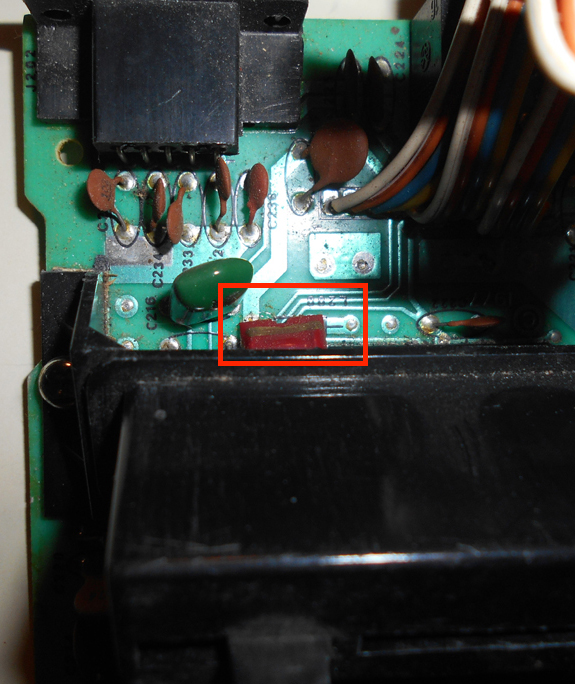
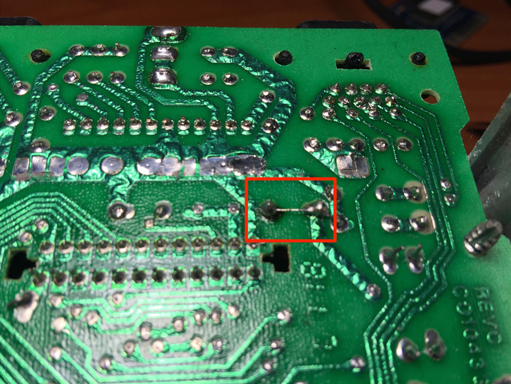
Doing this mod might create some RF interference, in which case installing a ferrite bead across those 2 solder points will correct it.
Regarding the 7800 models, there are known incompatibilities with some NTSC versions (PAL 7800s seem to be unaffected). Games that may not work include:
* The timing circuit was added to models after 1984 to correct a timing issue with 1 or more games (the other games in the list). Unfortunately, the timing circuit created issues with the games indicated (*). Other recent homebrew games and demos (ex. Space Rocks, Star Castle, Removing or disabling the C64 capacitor (a green, ceramic capacitor in the center of the board) will restore compatibility with them. Using a Harmony cartridge for these games might also make them compatible, as the Harmony affects the timing as well.
Overall, 7800s manufactured between 1984 and 1986 are more compatible than systems made after 1986. Below is a compatibility chart by James Randall that shows the testing results from 17 different systems made between 1984 and 1988. Of those, only 3 (highlighted in yellow) proved to be fully compatible:
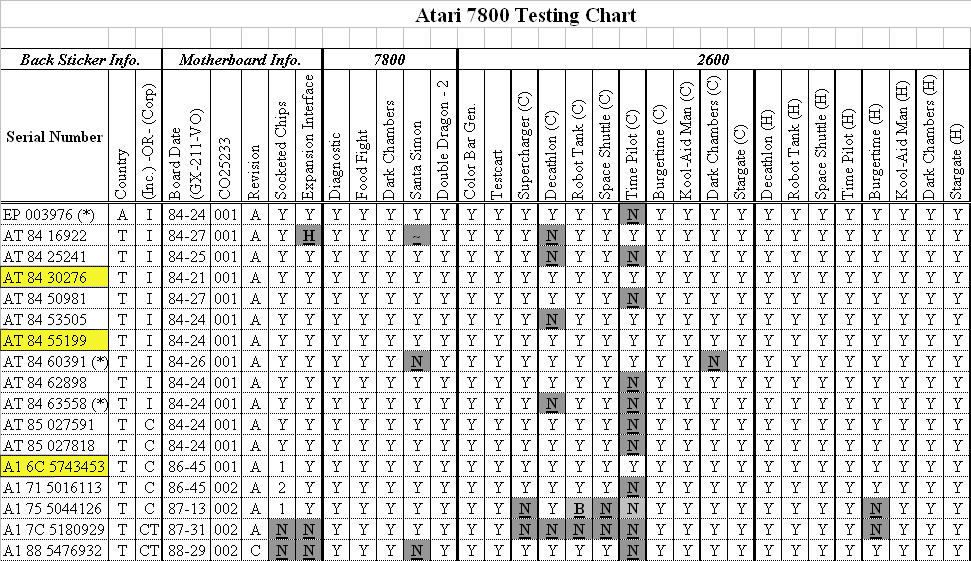
From James Randall:
| In regards to compatibility there is nothing consistent. I did end up with 3 units that could play anything I threw at them, but having a similar unit to these is no guarantee of 100% compatibility. I used the 7800 Diagnostic cart to calibrate the color and to check for errors. I used Double Dragon to test the consoles 2-button functionality for each player. Food Fight, Dark Chambers, and Santa Simon were checked to see if they would load and play fine. All units worked
fine with Food Fight and Dark Chambers. Santa Simon did not work on 2 units and was almost playable on another. For 2600 testing I used both cartridges "(C)" and the Harmony cart "(H)". It was interesting that using the Harmony cart gave me near 100% compatibility for all units. Another great reason to get one! For the two instances where BurgerTime did not work via Harmony, the real cart worked fine. None of the units had problems with the real cart versions of BurgerTime, Kool-Aid Man, or Stargate. Time Pilot was easily the most difficult cart for the 7800 units to handle, followed by Decathlon. The Color Bar Generator and TestCart were not for compatibility but I did use them for console functionality and color calibration (2600 mode). For the early units (EP, AT84&85), the motherboards and serial numbers did not follow any sequence. An early serial number is not a guarantee that the motherboard is an early model as well. Even my "test market" EP motherboard was made in the 24th week of 1984 whereas another unit had a motherboard made in the 21st week. I guess Atari made a bunch of motherboards in 1984 and when they were assembled into the casings then it was whatever the person on the assembly line grabbed. Also, I did have three units with the different rainbow pattern on the front of the 7800, including my "early" EP unit. These are marked with an (*). Normally, most rainbows on the 7800 start in yellow and end in green, but few start in red and end in purple. This is cool as it corresponds to the actual visual spectrum of light (a real rainbow). Also, my lowest serial number AT84 unit only has a hole for the expansion port but no pins. It is also made in the 27th week of 1984. This is weird as other models made in 1986 or 1987 still had the full port with pins. Maybe this was simply an error? |
In addition, a 7800 system has been found (Atari Corp. serial A1 72R4BR 5154270, Rev A 3187 pcb) that doesn't run BurgerTime or He-Man using a Harmony cartridge. All the chips on the pcb were soldered. There was no expansion port nor any markings on the case for it. Another one I found (Atari Corp. serial A1 72RBR 5774010, Rev A 0287) ran both BurgerTime and He-Man using a Harmony cartridge. 3 of the large chips were socketed and there was an expansion port. Some homebrews such as Boulder Dash also have incompatibility issues with some 7800 systems. Btw, the expansion port was planned to be used as an interface with RCA's SelectaVision VideoDisc CED Player, but RCA cancelled the CED player in April 1984.
The conventional wisdom saying that a deck with the expansion port will work with anything is false. Presence or absence of the port is not a reliable indicator of compatibility with all VCS/2600 carts.
The manufacturing standards of systems made in 1984 are better than those made later. All the major chips inside are all socketed instead of being soldered directly to the board. Some of the other decks also have had some minor factory patchwork performed. They occasionally have resistors bridging points where they were clearly not originally intended to be, i.e. soldered directly to a chip pin or placed on the underside of the board.
Q: What is the Starpath CD and can I still get one?
A: The Starpath Supercharger Game Collection on CD, or Stella Gets a New Brain was a non-profit, long-awaited labor of love from the CyberPuNKs (Russ Perry Jr., Glenn Saunders, Jim Nitchals and Dan Skelton). This CD not only contains NTSC and PAL versions of most of the Supercharger games (PAL Survival Island is missing), but also development tools, a collection of Supercharger and Vectrex material, and several surprises (including SoundX and the UR Polo from Carol Shaw). There were 2 different versions of the Starpath CD made. Some things on the first version were not included (e.g. the Vectrex stuff, Polo) while other things were added. CyberPuNKs' Glenn Saunders later donated the remaining unsold inventory to Hozer Video Games, who's long since sold out of them. Original copies occasionally surface on Ebay. More info available here.
Q: Where can I find a list of tricks and Easter Eggs?
A: Atari Compendium maintains the most complete and up-to-date Easter Egg lists for the Atari VCS/2600, 5200, 7800, 8-bit computers, and arcade coin-op games.
Q: What programming resources are available?
A:
Q: Is there a list of VCS/2600 game programmers?
A:
Q: Where can I get solutions to the SwordQuest series?
A: Atari Compendium now hosts Walton C. Gibson and Keita Iida's SwordQuest Archive of Adventure, which offers the solutions.
Q: What's the story with Sears Tele-Games, and why do some games have different titles?
A: Atari's relationship with Sears Roebuck and Co. started with their home Pong system. Under their arrangement, Sears helped Atari in contacting a venture capitalist to obtain the additional funds needed to help with producing the Pong system. In return, Sears would be the exclusive distributor of Pong through the 1975 holiday season on the condition they were rebadged as Sears products. These were given the Tele-Games Electronic Games moniker. This rebadging continued with several other dedicated systems, up to and including the VCS/2600.
It's unknown why exactly this was done. Although collectors like them (Tele-Games carts - especially those complete with box and manual - are harder to find), they often end up being a source of confusion and frustration for owners, especially when they find out what they initially thought was a new game ends up being something else (and sometimes one they already own).
A total of 26 different titles were renamed under the Sears Tele-Games label. Here's the complete list:
| ATARI | SEARS TELE-GAMES |
| Air-Sea Battle | Target Fun |
| Basic Math | Math |
| Breakout | Breakaway IV* |
| Casino | Poker Plus* |
| Circus Atari | Circus |
| Combat | Tank Plus* |
| Dodge 'Em | Dodger Cars |
| Flag Capture | Capture |
| Hangman | Spelling |
| Home Run | Baseball* |
| Human Cannonball | Cannon Man |
| Hunt & Score | Memory Match |
| Indy 500 | Race |
| Maze Craze | Maze Mania |
| Miniature Golf | Arcade Golf |
| Outlaw | Gunslinger* |
| Sky Diver | Dare Diver |
| Slot Machine | Slots |
| Slot Racers | Maze* |
| Space War | Space Combat* |
| Star Ship | Outer Space* |
| Street Racer | Speedway II* |
| Surround | Chase* |
| Video Checkers | Checkers |
| Video Olympics | Pong Sports* |
| Video Pinball | Arcade Pinball |
* These feature different packaging artwork than the Atari releases.
A total of 58 different titles were released under the Sear Tele-Games label. Here's the complete list:
| 3-D Tic-Tac-Toe Adventure Arcade Golf Arcade Pinball Asteroids Backgammon Baseball Basketball Berzerk Black Jack Bowling Brain Games Breakaway IV Cannon Man Canyon Bomber |
Capture Chase Checkers Circus Codebreaker Dare Diver Defender Demons to Diamonds Dodger Cars Football Golf Gunslinger Haunted House Math Math Gran Prix |
Maze Maze Mania Memory Match Missile Command Night Driver Othello Outer Space Pac-Man Poker Plus Pong Sports Race Slots Soccer Space Combat |
Space Invaders Speedway II Spelling Star Raiders Steeplechase * Stellar Track * Submarine Commander * Super Breakout ** Superman Tank-Plus Target Fun Video Chess Warlords Yars' Revenge |
Star Raiders was the last Atari game to be published in both Atari and Sears-style packaging.
* These were Sears exclusives and were never released under the Atari label.
** The Sears version was initially released first as an "exclusive" in 1981, which means Atari probably didn't have much faith in it being popular. The Atari version was released in January the following year.
Q: Are any release dates known for the games?
A: Here's the most complete list I have for Atari's own games, followed by the list for 3rd-party games. Specific release dates listed with some are those listed with the U.S. Copyright Office (LINK); the site's online database only goes as far back to 1978 (so the dates listed for any 1977 titles are not correct). The titles in gray are based off arcade versions (LINK). Copyright date - either onscreen or on the packaging - are not always accurate and cannot be relied on. Also check out Duane Alan Hahn's website for detailed information, although the dates for 1977 and 1978 aren't accurate.
ATARI 1st-party releases:
|
1977 |
Air-Sea Battle
(Sept)
(code finally copyrighted 1-2-1978)
Basic Math
(Sept)
(code finally copyrighted 1-2-1978)
Blackjack
(Sept)
Combat (Aug) (code finally copyrighted 1-2-1978)
Indy 500
(Sept)
(code finally copyrighted 1-2-1978)
Star Ship
(Sept)
(code finally copyrighted 1-2-1978)
Street Racer
(Sept)
(code finally copyrighted 2-8-1978)
Surround (Sept) (code finally copyrighted 1-2-1978)
Video Olympics
(Sept)
|
1978 |
Basketball (Sept)
Boggle (code copyright 8-7-78) – not released
Brain Games
(Sept)
Breakout
(Sept)
Codebreaker
(Sept)
Flag Capture
(Sept)
Hangman
(Sept)
– 1st 4K cart!
Home Run
(Sept)
Hunt & Score
(Sept)
Outlaw
(Sept)
Slot Racers
(Sept)
Space War
(Sept)
|
1979 |
Backgammon (4K) (Oct) - Special Edition cart
Bowling (Mar)
Canyon Bomber (Mar)
Casino
(4K)
(Mar) -
first Special Edition (4K) cart
Football
(Mar)
Human Cannonball
(Mar)
Miniature Golf
(Mar)
Sky Diver
(Mar)
Slot Machine
(Mar)
Snark – not released
Sonar – not released
Superman
(4K)
(Sep) (9-28-79 newspaper ad)
- Special Edition cart
Video Chess (4K) (Nov) - Special Edition cart
|
1980 |
3-D Tic-Tac-Toe (June)
Adventure (4K) (Mar/Apr) (Sears 1980 catalog entry)
BASIC Programming
(4K)
(April) - Special Edition cart
Championship Soccer (4K) (Sept) - last Special Edition cart
Circus Atari
(4K) (July) (Sears 1980 catalog entry)
Concentration, A Game of (Hunt & Score)
(Sept)
Dodge 'Em (4K)
(Sept)
Fun with Numbers (Basic Math)
Golf
(June)
Maze Craze (4K)
(Sept)
Night Driver
(June)
Space Invaders (4K) (March 10, 1980)
Stunt Cycle – not released
Video Checkers
(4K) (Sept)
Wizard (2K) – not released
Last 2K game developed
|
1981 |
Asteroids
(8K)
(Aug) - originally planned for July release, but wasn't released until
August. First 8K game released
Dodge 'Em (4K) (Mercedes garbage truck variant) - not released
Dukes of Hazzard, The
(4K)
(Stunt Cycle variant) - not released
Missile Command
(4K)
(May)
Othello
(4K)
(Mar) - last text label release and last 2K game
Pelé's Soccer
(4K)
(Championship Soccer) (Jan/Feb)
Steeplechase
(4K)
(Sears exclusive) (March)
Stellar Track
(4K)
(Sears exclusive) (March)
Super Breakout
(4K)
(Oct) - Sears version
Video Pinball
(4K)
(3-25-1981) - first
picture release
Warlords
(4K)
(June)
|
1982 |
3-D Rubik's Cube (4K) - not released
Berzerk
(4K)
(Aug) w/ Vol 2 of Atari Force – mentioned in July/August 1982 issue of Atari Age
Combat Two – GCC (8K) (Dec) – not released – mentioned in Sept/Oct 1982 and Nov 1983/Feb 1984 issues of Atari Age
Defender
(4K)
(June) (screen copyright 1981) w/ Vol 1 of Atari Force – mentioned in May/June 1982 issue of Atari Age
Demons To Diamonds
(4K)
(July) – mentioned in July/August 1982 issue of Atari Age
E.T. the Extra-Terrestrial (8K) (Nov) (11-19-82 newspaper ad) – mentioned in November/December 1982 issue of Atari Age
Frog Pond (8K) (Nov) – not released
Haunted House
(4K)
(Feb)
Math Gran Prix (4K) (July) – mentioned in July/August 1982 issue of Atari Age
Pac-Man (4K) (Mar) (screen copyright 1981) – April 3rd, 1982 was the official release date, dubbed “National Pac-Man Day” by Atari.
Racer (8K) – Roklan Corp. – not released
Raiders of the Lost Ark* (8K) (2nd week in Nov) (orig. Sept) – mentioned in November/December 1982 issue of Atari Age
Realsports Baseball (8K) (Oct) (orig. Sept) – mentioned in September/October 1982 issue of Atari Age
Realsports Football
(8K)
(Dec) (orig. Sept) – 1st mentioned in Sept/Oct 1982 issue of Atari Age, and later in Nov/Dec 1982 issue
Realsports Volleyball
(4K)
(Oct) (orig. Sept) – mentioned in September/October 1982 issue of Atari Age
Star Raiders
(8K)
(Sept) w/ Vol 3 of Atari Force $39.95 – mentioned in September/October 1982 issue of Atari Age
Submarine Commander (4K) (Sept) (Sears exclusive)
Super Breakout (4K) (Jan) – Atari
version
Swordquest Earthworld
(8K)
(Oct) – mentioned in September/October 1982 issue of Atari Age
Vanguard - GCC (8K) (Dec) – mentioned in January/February 1983 issue of Atari Age
Yars' Revenge
(4K)
(May) – mentioned in May/June 1982 issue of Atari Age
* Atari announced it as November release, but it was the first silver label sold through Sears which would put it on the shelves in late September/early October before Earthworld was released. The retail sheet I once owned showed ROTLA as a September release. A label variant of Raiders of the Lost Ark exists with a normal silver label on top, and an orange Sears-style end label. No silver-labeled Atari carts have any Sears-labeled counterparts, so this is exactly where the Sears label variants era ended.
A Sears manual for SwordQuest EarthWorld also exists, which was owned by former Atari technical writer John-Michael Battaglia. This may have been a one-off, as no Sears EW carts have ever been found.
|
1983 |
Aquaventure
(8K)
– not released
Alpha Beam With Ernie
(8K)
(Nov) – mentioned in September/October 1983 issue of Atari Age
Atari Video Cube – GCC (4K) (May) (box copyright 1983, screen & cart copyright 1982 – released no later than April) Mentioned in May/June 1983 issue of Atari Age
Battlezone – GCC
(8K)
(Aug) – mentioned in July/August 1983 issue of Atari Age
Big Bird's Egg Catch
(8K)
(Nov) – mentioned in November 1983/February 1984 issue of Atari Age
Centipede – GCC
(8K)
(Mar) (screen
copyright 1982) – mentioned in March/April 1983 issue of Atari Age
Cookie Monster Munch
(8K)
(Nov) – mentioned in September/October 1983 issue of Atari Age
Crazy Climber
(8K)
(Mar) (screen copyright 1982) – Roklan Corp. – mentioned in January/February 1983 issue of Atari Age
Dig Dug – GCC
(8K)
(Oct) – mentioned in September/October 1983 issue of Atari Age
Donald Duck's Speedboat
(8K)
– not released
Dukes of Hazzard, The
(8K)
(Mar/Apr) – not released – mentioned in Nov/Dec 1982
and Sept/Oct 1983 issues of Atari Age
Dumbo's Flying Circus
(8K)
– not released
Galaxian – GCC w/ Vol 5 of Atari Force
(8K)
(Jun) – mentioned in March/April 1983 issue of Atari Age
Gravitar
(8K)
(Oct) – mentioned in September/October 1983 issue of Atari Age
Grover's Music Maker
(8K)
– not released
Joust – GCC
(8K)
(Nov) – mentioned in September/October 1983 issue of Atari Age
Jungle Hunt – GCC
(8K)
(July) – mentioned in May/June 1983 issue of Atari Age
Kangaroo – GCC
(8K)
(July) – mentioned in May/June 1983 issue of Atari Age
Krull
(8K)
(Oct) – mentioned in July/August 1983 issue of Atari Age
Mario Bros.
(8K)
(Dec) – mentioned in November 1983/February 1984 issue of Atari Age
Mark of the Mole
(8K)
- not released
Miss Piggy's Wedding
(8K)
– not released
Moon Patrol – GCC
(8K)
(Nov) – mentioned in September/October 1983 issue of Atari Age
Ms. Pac-Man - GCC
(8K)
(Feb) – mentioned in January/February 1983 issue of Atari Age
Phoenix - GCC w/ Vol 4 of Atari Force
(8K)
(Feb) – mentioned in January/February 1983 issue of Atari Age
Pigs In Space –
(8K)
(Nov) mentioned in November 1983/February 1984 issue of Atari Age
Pole Position – GCC
(8K)
(Aug) – mentioned in July/August 1983 issue of Atari Age
Pole Position – GCC
(8K)
–
not released - Puffer controller version
Quadrun
(8K)
– release was delayed – mentioned in November 1983/February 1984 issue of Atari Age
RealSports Baseball
(8K)
–
not released - Voice Controller version
RealSports Basketball
(8K)
– not released – Roklan Corp.
(originally planned for April release, and later delayed to the fall)
RealSports Soccer
(8K)
(Jun) – mentioned in March/April 1983 issue of Atari Age
RealSports Tennis
(8K)
(Jun) – mentioned in March/April 1983 issue of Atari Age
River Boat –
not released - Puffer controller version
Robotron: 2084 (Jun) – not released
– tentative release date 6-1-83, according to an internal memo
Saboteur
(8K)
– not released
Snoopy And The Red Baron
(8K)
(Nov) – mentioned in November 1983/February 1984 issue of Atari Age
Snow White and the Seven Dwarfs
(8K)
– not released
Sorcerer's Apprentice
(8K)
(Nov) – mentioned in September/October 1983 issue of Atari Age
SwordQuest FireWorld
(8K)
(Feb)
(screen copyright 1982)
(orig. Nov 82) – mentioned in January/February 1983 issue of Atari Age
SwordQuest WaterWorld
(8K)
(Oct) – mentioned in September/October 1983 issue of Atari Age
|
1984 |
A-Team, The
(8K)
– not released
Bagman – not released
Ballblazer – not released
Bionic Breakthrough
(8K)
– not released
Bugs Bunny
(8K)
(screen copyright 1983) – not released – programmer Bob Polaro mentioned a fall 1984 release was planned
Choplifter – GCC
(8K)
(Apr) – not released – mentioned in Atari's 1983 CES press kit
Count's Castle – not released
Crystal Castles (16K) (Apr) – mentioned in March/April 1984 issue of Atari Age
Dune
(8K)
- not released
Elevator Action
(8K)
– not released
Firefox (4K) – not released
Garfield (16K) – not released
Good Luck, Charlie Brown
(8K)
– not released – mentioned
in March/April 1983 issue of Atari Age
Gremlins (Aug)
Holey Moley
(8K)
- not released
Honker Bonker – not released
Millipede (16K) (Apr) – mentioned in March/April 1984 issue of Atari Age
Mind Maze
(8K)
(screen copyright 1983)
– not released
Monstercise
(8K)
– not released
Oscar's Trash Race
(8K) (May)
(screen copyright 1983)
– mentioned in March/April 1984 issue of Atari Age
Peek-A-Boo (4K) – not released – mentioned in May/June 1983 issue of Atari Age
Pengo (8K) (July) – mentioned in the
March/April 1983 and July/August 1983 issues of Atari Age
Rubik’s Cube (4K) – GCC (screen copyright 1982)
Sinistar
(8K)
– not released
Stargate
(8K)
(Aug) – mentioned in Nov
1983/Feb 1984 and March/April 1984 issues of Atari Age
SwordQuest AirWorld – not released – originally planned for a September 1983 release, according to April 1983 issue of Videogaming Illustrated
– mentioned in May/June 1982 issue of Atari Age
Taz
(8K)
(Apr) (screen copyright 1983) – mentioned in March/April 1984 issue of Atari Age
Tempest
(8K)
(screen copyright 1983 but latest prototype dated 1984)
– not released
Track & Field (16K) – GCC
–
possibly
released in limited numbers due to Atari's commitment to sponsor the 1984
Olympics.
Xevious
(8K)
(screen copyright 1983 but latest prototype dated 1984) – not released
Zoo Keeper – not released
– mentioned in March/April 1984 issue of Atari Age
|
1985 |
--none--
|
1986 |
Jr. Pac-Man GCC
(16K)
(Oct)
Midnight Magic
(16K)
(Nov)
Solaris
(16K)
(Nov)
|
1987 |
Crossbow
(16K)
(May) – Imagineering
Defender II
(8K)
Desert Falcon
(16K)
– Bobco
Donkey Kong (4K) – Coleco
Donkey Kong Junior (8K) – Coleco
Mouse Trap (4K) – James Wickstead Design Associates
Q*Bert (4K) – Parker Brothers
RealSports Boxing
(16K)
– Imagineering
Venture (4K) - CommaVid
|
1988 |
32 in 1 (64K)
Crack'ed
(16K)
– not released
Dark Chambers
(16K)
(Dec) – Sculptured Software
Sprint Master
(16K)
– Bobco
Super Baseball
(16K)
(Aug)
Super Football
(16K)
(Dec)
|
1989 |
Adventures of Max, The – Axlon –
not released
Black Lamp
–
not released
Double Dunk
(16K)
(May) – Matthew Hubbard
Off The Wall
(16K)
(Dec) – Axlon
Radar Lock
(16K)
(Dec)
Road Runner
(16K)
(Dec) – Atari/Bobco
Secret Quest
(16K)
(Dec) – Axlon
Shooting Arcade
(16K)
– Axlon –
not released
Whitewater Madness – not released
|
1990 |
BMX Airmaster
(16K)
– Sculptured Software
Fatal Run (32K) – Sculptured Software (screen copyright 1989) – only
available overseas
Save Mary
(16K)
– Axlon –
not released
|
1991 |
Ikari Warriors
(16K)
(Mar) – Imagineering (screen copyright 1987) – only available overseas directly from Atari in early 1991
KLAX
(16K)
– DeFrisco Entertainment – the last release for the VCS by Atari and was only available overseas
Motorodeo
(16K)
(Mar) – Axlon – only available directly from Atari in early 1991
Sentinel
(16K)
(Mar) – Imagineering – only available directly from Atari in early 1991
Xenophobe
(16K)
(Mar) – only available directly from Atari in early 1991
3rd-party releases:
|
1980 |
Boxing (Jul)
1981 Freeway (Mar)
Checkers (Jul)
Dragster (Jul)
Fishing Derby (Jul)
Ice Hockey (Dec)
Kaboom! (Mar)
Laser Blast (Mar)
Skeet Shoot (Dec)
Stampede (Dec)
Tennis (Mar)
|
1982 |
Air Raid
Airlock (Oct)
Alien (10-29-1982)
Amidar (Nov)
Armor Ambush (Sep)
Astroblast (Aug)
Atlantis (Jun)
Bachelor Party (Oct)
Barnstorming (Mar)
Beany Bopper (Oct)
Beat'Em & Eat'Em (Oct)
Bugs (Oct)
Carnival (Nov)
China Syndrome (Dec)
Chopper Command (Jun)
CocoNuts (Nov)
Commando Raid (Oct)
Communist Mutants From Space (Sep)
Condor Attack (Nov)
Cosmic Ark (Jul)
Cosmic Creeps (Dec)
Cosmic Swarm (May)
Cross Force (Oct)
Custer's Revenge (Oct)
Dark Cavern (Oct)
Deadly Duck (Oct)
Demon Attack (Apr)
Donkey Kong (Jul)
Dragonfire (Dec)
DragonStomper (Dec)
Encounter at L-5 (Oct)
Escape from the MindMaster (Dec)
Fantastic Voyage (Dec)
Fast Eddie (Oct)
Fast Food (Oct)
Final Approach (Oct)
Fire Fighter (Aug)
Fireball (Sep)
Frogger (Aug)
Frogs and Flies (Oct)
Gangster Alley (Jul)
Gorf (Dec)
Grand Prix (Mar)
Guardian (Nov)
Infiltrate (Sep)
International Soccer (Dec)
Jawbreaker (Oct)
Karate (Nov)
King Kong (Aug)
Lock 'N' Chase (Sep)
Lockjaw (AKA Shark Attack (Jun)
Lost Luggage (Jun)
Marauder (Dec)
MegaForce (Nov)
MegaMania (Sep)
Mines of Minos (Nov)
Mouse Trap (Oct)
Nexar, The Challenge of (Oct)
Phaser Patrol (Sep)
Pitfall! (Sep)
Planet Patrol (Jul)
Racquetball (Jun)
Rescue Terra I (Dec)
Riddle of the Sphinx (Aug)
River Raid (Dec)
Room of Doom (Sep)
Sky Jinks (Nov)
Sneak'n Peek (Aug)
Space Attack (Aug)
Space Cavern (May)
Space Jockey (Jan)
Spacechase (Feb)
Spider-Man (Dec)
Sssnake (Oct)
Star Voyager (Apr)
Star Wars: The Empire Strikes Back (Jul)
Starmaster (Jun)
Suicide Mission (Sep)
Super Challenge Baseball (Aug)
Super Challenge Football (Aug)
Tape Worm (Oct)
Threshold (Sep)
Towering Inferno (Oct)
Trick Shot (Apr)
Turmoil (Nov)
Venture (Sep)
Wabbit (Oct)
Warplock (Oct)
Wizard of Wor (Dec)
Word Zapper (Aug)
Worm War I (Oct)
|
1983 |
Adventures of TRON (Feb)
Air Raiders (Feb)
Artillery Duel (Nov)
Bachelorette Party
Bank Heist (Jul)
Bermuda Triangle (Mar)
Blue-Print (Jul)
Boing! (Nov)
Buck Rogers: Planet of Zoom - Official Arcade Version (Nov)
Bump 'n' Jump (Dec)
Bumper Bash
BurgerTime (Jul)
Burning Desire
Cakewalk (Jun)
Cathouse Blues
Chase the Chuck Wagon (Oct)
Chuck Norris: Superkicks (Nov)
Congo Bongo (Nov)
Crashdive (Sep)
Crackpots (Aug)
Crypts of Chaos (Feb)
Dancing Plate (Apr)
Death Trap (Jul)
Decathlon, The Activision (Aug)
Demolition Herby (May)
Dice Puzzle
Dolphin (Apr)
Donkey Kong Junior (Oct)
Earth Dies Screaming, The (Jul)
Eggomania (Jan)
Enduro (May)
Entombed (Mar)
Exocet
Fathom (Aug)
Firefly (Oct)
Flash Gordon (Mar)
Frankenstein's Monster (Apr)
Frostbite (Oct)
G.I. Joe: Cobra Strike (Mar)
Gamma-Attack (Jan)
Gauntlet
Ghost Manor (Sep)
Gigolo
Glib (Oct)
Gopher (Jan)
Great Escape
Halloween (Jun)
Journey Escape (Jan)
Jungle Fever
Keystone Kapers (Apr)
Killer Satellites (Mar)
Knight on the Town
Lady in Wading
Kool-Aid Man (Jul)
Laser Gates (Nov)
London Blitz (Jun)
M*A*S*H (Apr)
M.A.D. (Missile Attack and Defense) (Jan)
Malagai
Mangia'
Marine Wars
Master Builder
Masters of the Universe: The Power of He-Man (Dec)
Miner 2049er (May)
Mogul Maniac (Aug)
Moonsweeper (Aug)
Mountain King (Nov)
Mr. Do! (Sep)
Music Machine, The (Nov)
Name This Game (Jan)
Nightmare
No Escape! (Apr)
Official Frogger, The (Oct)
Oink! (Apr)
Omega Race (Nov)
Open Sesame! (Apr)
Party Mix (Oct)
Philly Flasher
Picnic (Jan)
Piece O' Cake (Mar)
Plaque Attack (Jun)
Polaris (Apr)
Pooyan
Popeye (Oct)
Porky's (Jul)
Pressure Cooker (Nov)
Q*bert (Jul)
Quick Step (Nov)
Rabbit Transit (Sep)
Raft Rider (Mar)
Ram It (May)
Reactor (Feb)
Red Sea Crossing (Oct)
Revenge of the Beefsteak Tomatoes (Mar)
Robot Tank (Jul)
Seahawk
Seaquest (Feb)
Shootin' Gallery (Apr)
Skindiver
Sky Alien
Sky Skipper (Apr)
Smurf: Rescue in Gargamel's Castle (Apr)
Smurfs Save the Day (Nov)
Solar Fox (Jul)
Solar Storm (Jun)
Sorceror (Oct)
Space Shuttle: A Journey Into Space (Dec)
Space Tunnel (Apr)
Spacemaster X-7 (Jul)
Spider Fighter (Jan)
Spike's Peak (Sep)
Spitfire Attack (Oct)
Springer (Oct)
Squeeze Box (Jan)
Star Fox (Oct)
Star Gunner (May)
Star Strike (Jun)
Star Trek: Strategic Operations Simulator - Official Arcade Version (Oct)
Star Wars: Jedi Arena (Feb)
Star Wars: Return of the Jedi - Death Star Battle (Sep)
Strategy X
Strawberry Shortcake: Musical Match-Ups (Apr)
Stronghold (Jul)
Sub-Scan (Apr)
Subterranea (Dec)
Super Cobra (Oct)
Survival Island (Nov)
Survival Run (Oct)
Sword of Saros (Nov)
Tac-Scan (Apr)
Texas Chainsaw Massacre, The (Jun)
Thunderground (Sep)
Tooth Protectors (Aug)
TRON Deadly Discs (Jan)
Tunnel Runner (Nov)
Tutankham (Jun)
Video Jogger
Video Reflex
Wall Ball (Jun)
Wall Break
X-Man (Jul)
Zaxxon (Apr)
|
1984 |
Beamrider (Jun)
Berenstain Bears, The (Mar)
Birthday Mania (Dec)
Eli’s Ladder (Aug)
Espial (Apr)
Extra Terrestrials
Frogger II: Threeedeep! (Sep)
Front Line (Apr)
Gas Hog
Gyruss (Jul)
H.E.R.O. (Apr)
James Bond 007 (May)
Miner 2049er Vol. II (Apr)
Montezuma’s Revenge (Sep)
Motocross Racer (Oct)
Mr. Do!’s Castle (Nov)
Out Of Control (Mar)
Pitfall II: Lost Caverns (Feb)
Private Eye (Feb)
Quest for Quintana Roo
River Patrol (May)
Robin Hood (Mar)
Roc’n Rope (Jul)
Shuttle Orbiter (Mar)
Sir Lancelot (Mar)
Spy Hunter (Nov)
Star Wars: The Arcade Game (Jun)
Tapper (Sep)
Tomarc The Barbarian
Up'n Down (Nov)
|
1985 |
Cosmic Commuter (Oct)
Ghostbusters (Oct)
Q*Bert's Qubes (May)
|
1986 |
Tax Avoiders (Dec)
|
1987 |
Kung-Fu Master (Sep)
Summer Games (Nov)
Title Match Pro Wrestling (Oct)
Winter Games (Nov)
|
1988 |
California Games (Jun)
Commando (Jun)
Pete Rose Baseball (Dec)
River Raid II (Nov)
Skate Boardin' (Jan)
Tomcat - The F-14 Fighter Simulator (Dec)
|
1989 |
BMX Air Master (TNT Games version) (Oct)
Double Dragon (Oct)
Glacier Patrol (Oct)
Rampage (May)
|
1990 |
--none--
|
1991 |
--none--
Q: Are there any sales figures for the games?
A: Once Upon Atari showed some documents (in the "Agony & Ecstasy" episode) that listed some cartridge sales figures (note - the ranking is not correct):
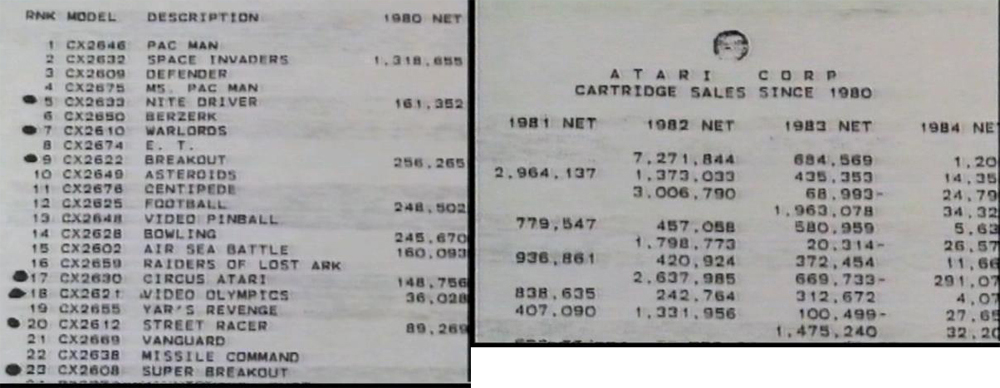
Total Atari VCS cart sales 1980-1984 for top 11 games based on the above document:
| 1. Pac-Man 2. Space Invaders 3. E.T. the Extra-Terrestrial 4. Defender 5. Missile Command 6. Ms. Pac-Man 7. Night Driver 8. Asteroids 9. Berzerk 10. Warlords 11. Breakout 12. Centipede 13. Yars' Revenge 14. Raiders of the Lost Ark |
7,957,613 6,105,528 3,598,788 3,100,573 At least 2,500,000, according to Rob Fulop 1,997,398 1,984,546 1,867,195 1,845,657 1,730,239 1,654,406 1,507,440 At least 1 million, according to Howard Scott Warshaw At least 1 million, according to Howard Scott Warshaw |
Other notable cart sales figures from 3rd-party companies:
| 1. Donkey Kong 2. Frogger 3. Pitfall 4. Demon Attack 5. Atlantis 5. Cosmic Ark 6. Star Wars: The Empire Strikes Back 7. Laser Blast 8. Freeway 9. Kaboom! 10. River Raid 11. Megamania |
Over 4 million, according to Garry Kitchen Over 4 million, according to Ed English 3.5 million, according to David Crane 3-4 million, according to Dennis Koble Over 2 million, according to Dennis Koble Over 1 million, according to Rob Fulop Over 1 million At least 1 million, according to James Levy At least 1 million, according to James Levy At least 1 million, according to James Levy At least 1 million, according to James Levy At least 1 million |
Q: How many different Atari cartridge label styles are there?
A: There are 6 main styles that were sold, with several subsets of each, as well as prototypes and anomalies. See the Atari VCS/2600 Label Variations page for more information.
Q: Why were the boxes on some early Atari carts marked "Special Edition"?
A: These were some of the first cartridges to feature a 4K ROM. There were only 6 that had this label on their boxes:
Backgammon
BASIC Programming
Casino (some boxes didn't have the "Special Edition" label on them)
Championship Soccer
Superman
Video Chess

The very first 4K cartridge released, Hangman, did not have this label.
Q: What was the Special Feature 'Teddy
bear' logo on
some boxes and manuals for?
A: These cartridges have additional variations for young children. This logo appeared either on the box, manual, or onscreen. The first game to include these was Missile Command. Below are the logos as they appear on the box and manual, along with the variations:

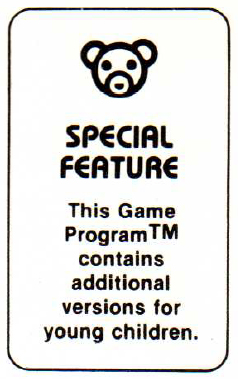
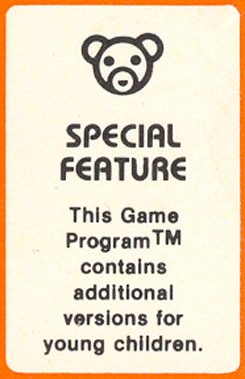
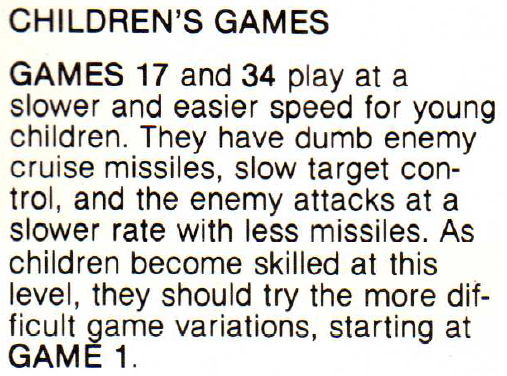
These were all the games that included Special Features:
Asteroids - variations noted on game select matrix
Berzerk - variations noted in pink on game select matrix
Centipede - 1st to only feature logo onscreen
Dark Chambers - features 3 different logos onscreen and in manual
Defender - variations noted in red on game select matrix
Dig Dug - only features logo onscreen
Joust - only features logo onscreen
Jr. Pac-Man - features 1, 2, or 3 logos onscreen
Missile Command - variations noted in yellow on game select matrix
Moon Patrol - only features logo onscreen
Ms. Pac-Man - features 1, 2, or 3 logos onscreen
Pac-Man - variations noted on game select matrix
Super Breakout - variations noted in pink on game select matrix
Warlords - variations noted on game select matrix
Yars' Revenge - only features logo on manual and back of box. Game
variation 0 is noted as being the children's version.
Q: Where can I find game reviews?
A: Atari Compendium archives reviews from several magazines and books from that era for the Atari VCS/2600, 5200, and 8-bit computers.
|
HARDWARE |
Q: How many VCS/2600 systems were sold?
A: Here's a rough timeline based on the available info (below)
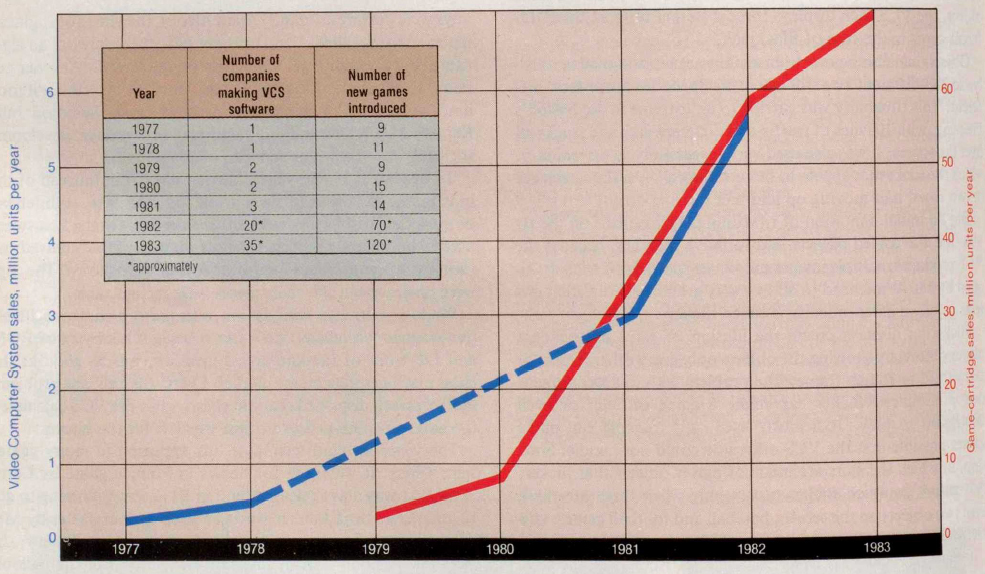
Chart from the March 1983 issue of
1977 250,000
1978 +500,000 = 750,000
1979 +1.3 million = 2,050,000
1980 +2 million = 4,050,000
1981 +3 million = 7,050,000
1982 +5.5 million = 12,550,000
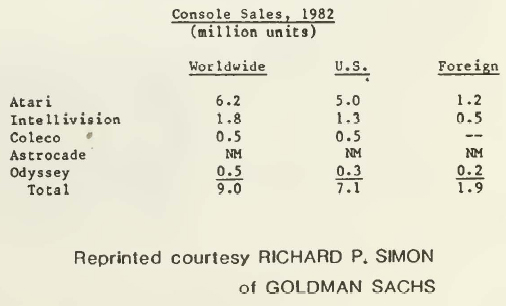
Chart from the October 1983 issue of The
Video Game Update, pg. 99.
10-12 January/February 1983
12 March 1983
14 February 1984
25 1988 (worldwide?)
30 total (worldwide)
Atari's own "Consumer Electronics Division (Jan/Feb) 1983" press kit has a letter about the 2600 (My First) Computer, mentioning "an installed base of more than 10 million VCS owners..."
A January 19th, 1983 Wall Street Journal article has a quote from Activision's
Alan Miller mentioning a "market of 12 million VCS units."
A January 1983 press release from Starpath notes there being "12 million Atari VCS owners".
The March 1983 issue of IEEE spectrum states "...over 12 million sold at about $140 apiece".
An article in the spring 1983 issue of Creative Computing Video & Arcade Games
conservatively estimates 6 million consoles (pg.
32).
Both the April and May 1983 issues of Antic mention there being a user base of 10 million VCS systems, but they would have been using whatever figures Atari was publishing.
The May/June 1983 issue of Atari Inside notes "...an installed base of more than 12 million VCS owners."
A May 1983 press release from Unitronics regarding its Interface Module I refers to "an installed base of more than 12 million VCS owners".
The "Atari 2nd Half 1983" press kit has a flyer about the Graduate that states there are over 12 million VCS owners.
From Jed Margolin's archive of Atari VAX messages is this February 1st, 1984 email from Chris Downend:
| The Quality of 2600 carts is the pits - no doubt about it. The system was introduced in 1977 so it is SEVEN years old. I think Breakout and Space Invaders are decent renditions of the coin-op originals and those are 1976 and 1979 games respectively. But with 14 million 2600's out there, financial issues outweigh aesthetic issues. |
The October 1987 issue of TGM has an article with Atari claiming, "Over 20 million (VCS) units are already in people's homes, and millions more continue to be sold each year."
2 internal Atari memos from 1988 (one regarding Axlon games, and the other regarding Atari hardware) state 25 million systems were sold by then.
The book, Encyclopedia of Game Machines, lists 30 million VCS systems sold (total - worldwide).
The accuracy of these last 2 figures is questionable, unless the figures Atari stated in 1983 were based on domestic (U.S.) sales only. But if true, what reason would they have to do that?
Sales numbers have been reported anywhere from 9-12 million units sold in the U.S. by the time the 2600 JR was released in 1986. Given Atari's own statements in 1983, and the fact that the system was actively pushed by Atari until mid-1984, I'd say the 12 million would be the low-end estimate. Perhaps 12-15 would be more accurate. But to see basically the same figures between 1984-1991 that
were seen between 1977-1984 would be impossible, especially considering Atari's own cartridge sales figures from 1986-1990 paled in comparison.
Q: What are the different VCS/2600 models?
A:
ATARI VIDEO COMPUTER SYSTEM (VCS) - model CX2600
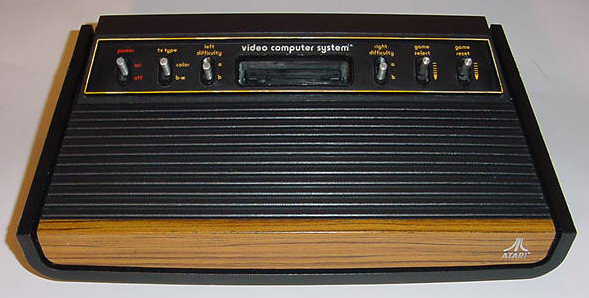
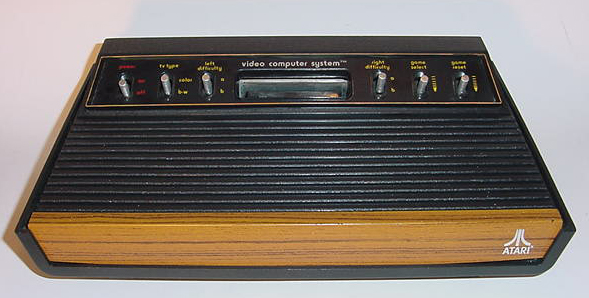
Atari showed the VCS at the June 1977 CES and it was available for sale as early as August 1977. There are 6 switches on top of this model (Power, Color/ B&W, Left and Right Difficulty (A and B), Game Select, and Game Reset). All the text on the switch panel is in lower-case. The power and controller jacks are on the back. The pack-in game was Combat, which seems an odd choice to make considering that of the 9 games originally released, that's the only one without any 1-player variations. The system also included 2 joysticks and paddles. The in-house nickname for the system, "Stella", was not derived from a female employee like most Atari hardware projects were, but rather designer Joe Decuir's bicycle. The wood grain case was designed by Douglas Hardy and Fredrick Thompson. The original 1977 models were made in Sunnyvale and are called "heavy sixers" (1st photo) by the gaming community because the plastic casing is thicker and heavier, and the base is slightly more rounded than the standard 6-switch (2nd photo), which were produced between 1978-79 and made in Hong Kong. The photos below show the major differences between the "heavy" and "light" 6-switch models:
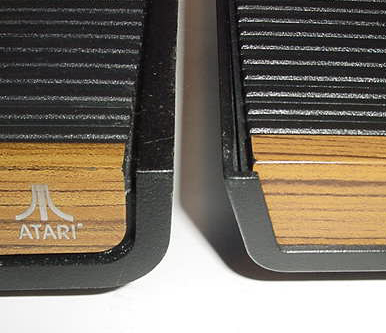
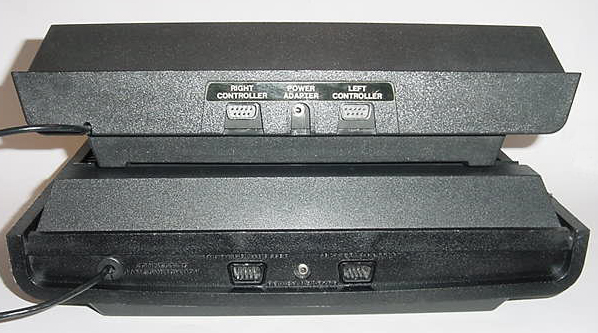
The original "heavy sixers" released did not have a channel selector switch (it was preset for channel 3. Customers who had a problem with interference from their local TV station could obtain a replacement preset for channel 4); there's no switch on the board, and typically no hole in the case for it (if there is, it might be marked CHANNEL SELECT A/B):
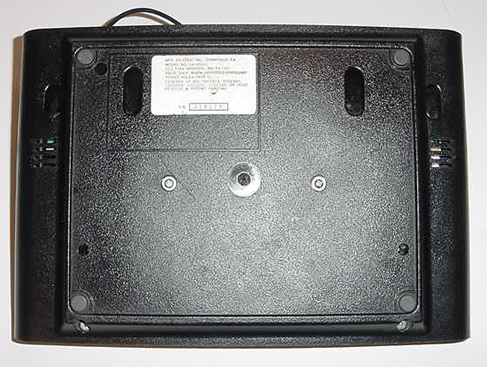
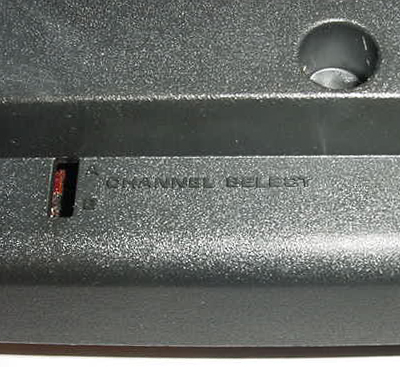
The last "heavy sixers" released included the channel selector switch and modified case. Also, all 6-switch models have the motherboard board within a heavy-duty aluminum casing. You can see this around the cartridge port.
ATARI VIDEO COMPUTER SYSTEM (VCS) - model CX2600A
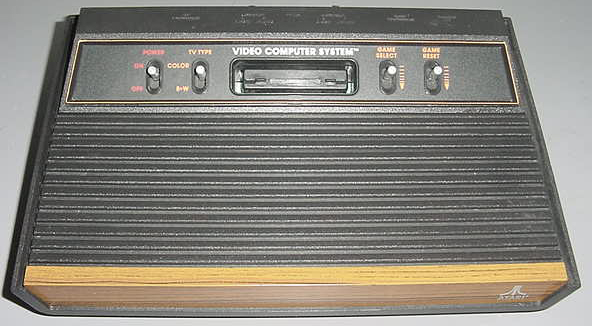
The VCS was redesigned in 1980. This model, 2600A, has 4 switches on top (Power, Color/ B&W, Game Select, and Game Reset). All the text on the switch panel is in upper-case. The 2 internal circuit boards were integrated into one, and the heavy aluminum shielding was replaced with a thin, metal casing. The difficulty switches are on the upper-backside of the console, along with the power connector, controller jacks, and channel switch; the top edge of the case has raised lettering for each. These 2 photos show the differences with the back of the case between the 2600 model and the 2600A model:
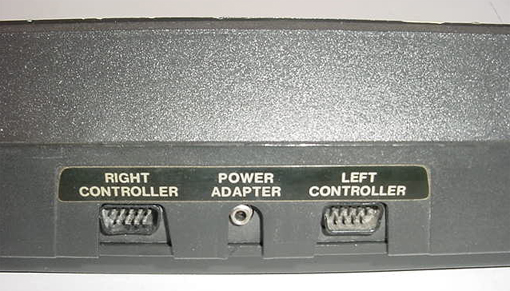
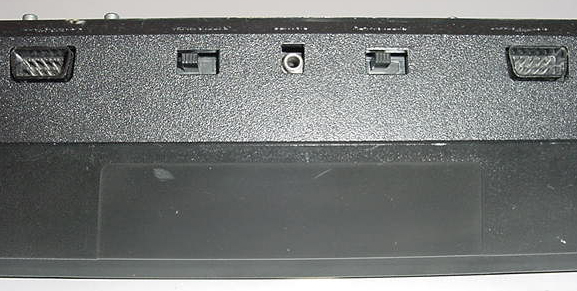
The channel selector switch was also relocated to the back of the case, next to the right controller jack, and is now marked CHANNEL 2-3.

The box shows a few different game-related pictures, but the system shown on the box is a "heavy-four" (which was never produced)! Some cases (esp. those made by Dimerco Electronics in Taiwan) don't have a hole in the bottom for color pot adjustments.
Some of the early 2600A models have "light" 6-switch bottom cases, probably done to use up the remaining inventory. These have a thick, black piece of tape covering the opening for what would have been used for the power and controller jacks:
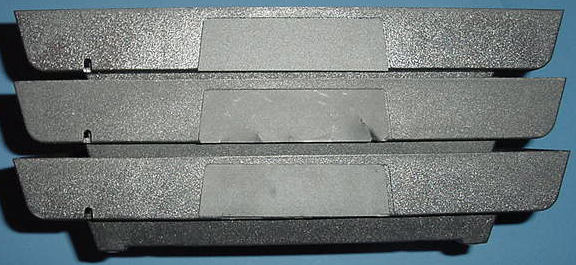
ATARI VIDEO COMPUTER SYSTEM (2600) - model CX2600
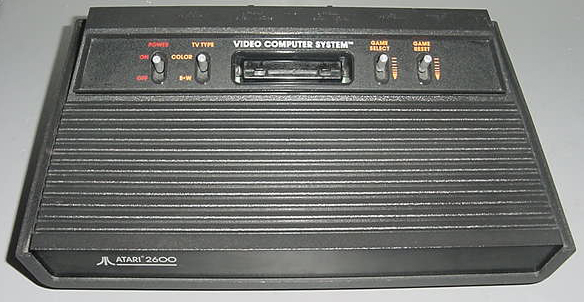
In 1982 the system became known as the "2600", and besides having a black front panel (instead of wood grain) and unpainted trim around the switch panel, the system box was silver. Collectors sometimes refer to this version as the 2600 "Vader" because of the all-black style. The trim around the joysticks was also unpainted. The difficulty switches are marked the same as the later 2600A variant. The manual lists the model number as "2600" (no 'A'). A few systems have the model number "CX-2600 CR". Starting in 1983, both Pac-Man and Combat were included, but paddles were not. A company flyer from that year notes it was priced to sell at under $100. PAL systems have the model number "2600 AP". Some cases (esp. those made by Dimerco Electronics in Taiwan) don't have a hole in the bottom for color pot adjustments.
A slight variation was made with this raised lettering - the original 2600A version labels the difficulty switches as:
| DIFFICULTY A B |
A later variation labels them as:
| DIFFICULTY A B EXPERT NOVICE |
ATARI 2600 (JR) - model CX2100
This is a VCS/2600 in a very compact and sleek case (commonly referred to as a 2600 "Junior"), which was originally designed for other uses (the 2200 and Voice Controller). Mark Biassotti designed the case, based on a concept by Regan Cheng. The system was originally designed to incorporate a new 3-in-1 chip called "JAN" which combined the MPU, TIA, and RIOT chipset. A prototype came with 1 joystick and Combat, in a 'lunchbox'-style box; the released version had a similar box but no pack-in game. Codenamed "Bonnie", development was completed in 1983 and it started shipping the following year. Labeled as the "Atari Video Computer System, Model #2600", it included the Pro-Line CX24 joysticks (same that were released with the 7800). Production stopped in 1984 and when it started up again in 1986, it was renamed the "2600 JR" (some have "JR" on the bottom sticker). At least 3 different versions of this model were produced. The 1st has a short "rainbow" graphic on the top metal panel:
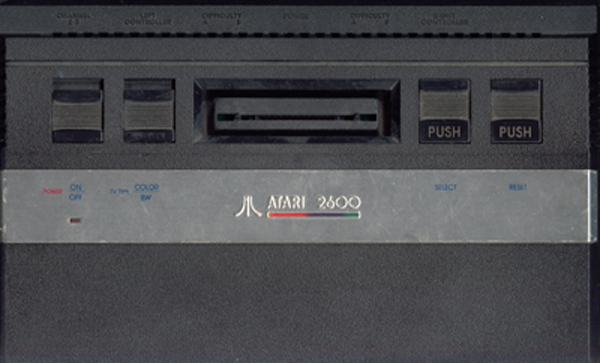
The 2nd has a long rainbow graphic that spans the width of the system:
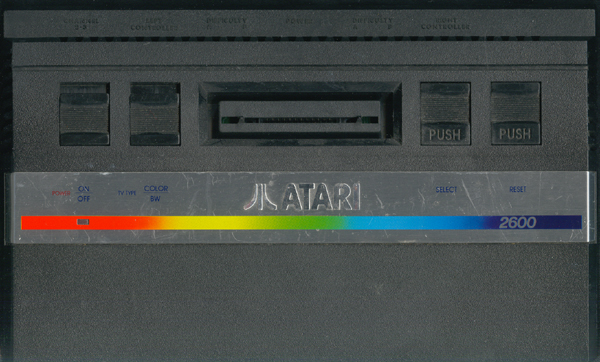
The 3rd doesn't have a metal panel (and may only have been sold in Ireland). Versions have been found with both white and orange lettering:
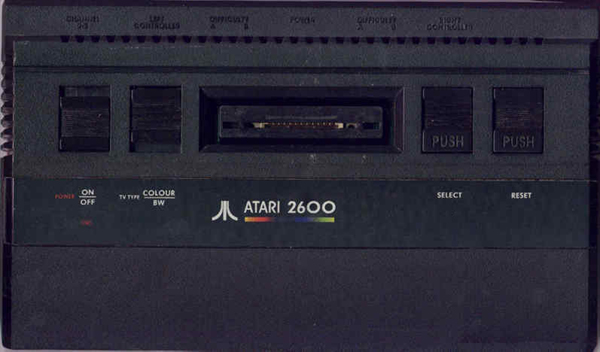
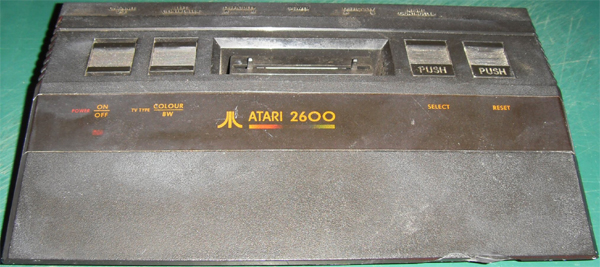
The motherboards are all copyrighted 1983 and most revisions have the name "ACTION" them (same with 7800 pcbs). This may have been another codename. Several different boxes exist as well and different joysticks were included (CX40, CX24, or CX78). A white JR surfaced recently, which may or may not have been a fake.
A unique 1-chip NTSC variant exists which may use the original JAN (or "Janice") chip (the model was referred to as the 2100 internally at Atari). There's no date or "ACTION" name on it, and known revisions are 3 and 4. This variant is sometimes referred to as a "unicorn". There's other differences, such as no color adjustment pot, input buffer (4050) chip, or stereo output (mono only, as with all PAL 2600 JR systems). There's also a spot for a 24-pin chip, which suggests the pcb was designed to incorporate a built-in game (much like how the original VCS was). The case is exactly the same as the long rainbow version, but with a serial number that starts with "A1" instead of "AT". There's only shielding around the RF module and most of the bottom of the pcb, and the pcb ground foil is solid metal instead of the typical crosshatch metal - both of which can be seen through the bottom case vents:
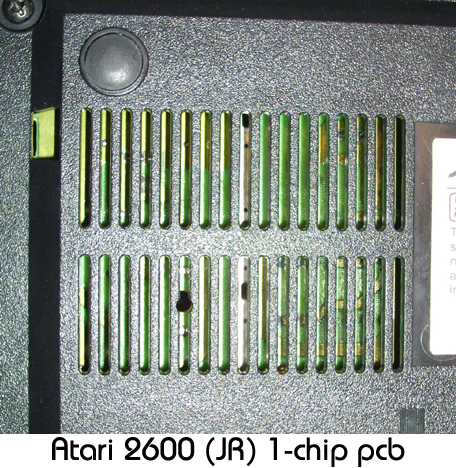
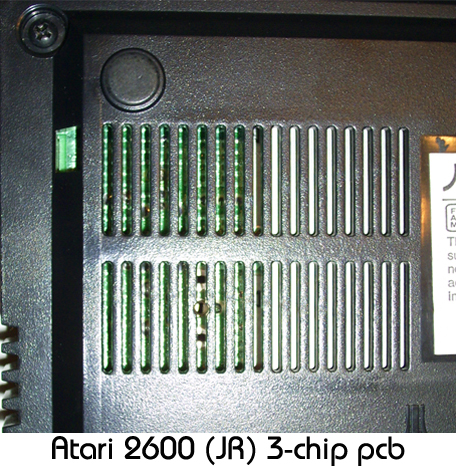
A white prototype version also exists:
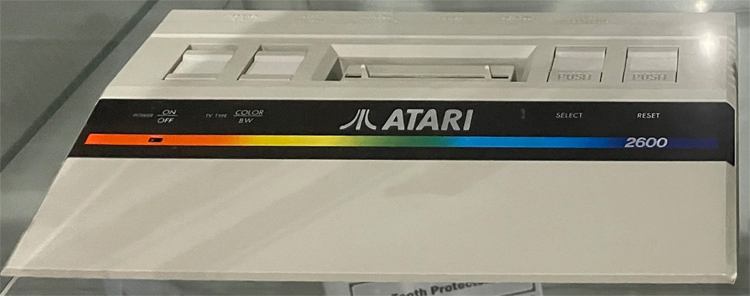
This is a PAL-B variant that was released in Australia. What's really unique is it has 128 games built-in! 4 of the 7 large chips are also manufactured by Atari and dated 1991 (the other are by UMC). The TV Type switch is a spring-loaded slider that selects the games:
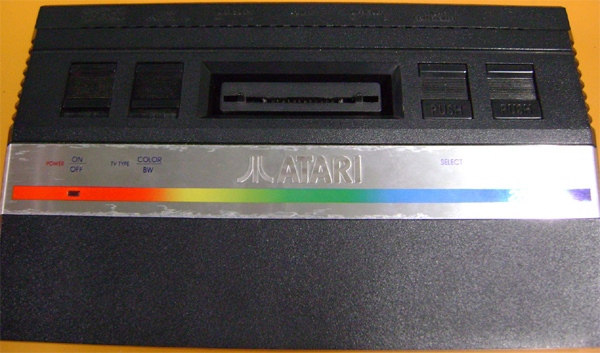
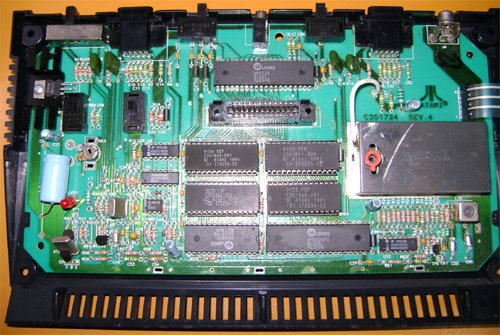
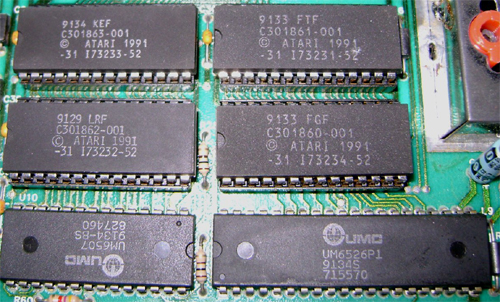
SEARS TELE-GAMES VIDEO ARCADE - model 637.99743
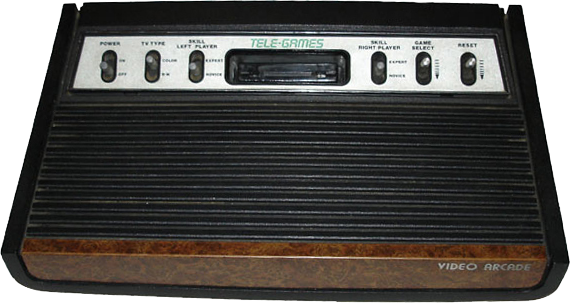
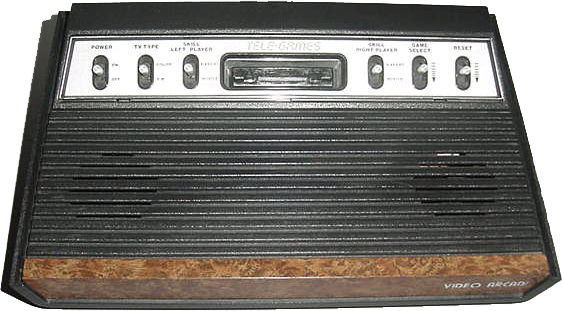
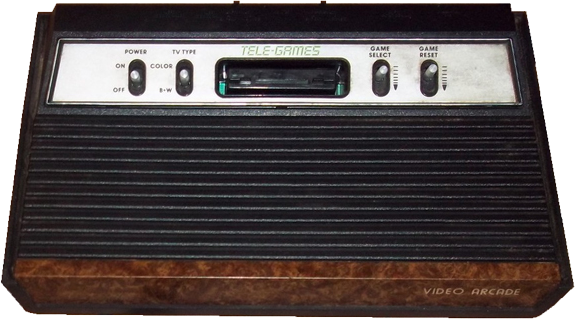
Sears Tele-Games models (called the Video Arcade) of both the 4 and 6-switch Atari VCS versions were also produced. The difficulty switches are relabeled as skill switches, and instead of A and B, they're marked Expert and Novice. The pack-in game was Target Fun (AKA Air-Sea Battle). The full name as listed on the original system box (which shows a "heavy" 6-switch system) was "Sears Cartridge Tele-Games System Video Arcade" on the top, and "Sears Tele-Games Electronic Games Video Arcade" on the side. A later version of the box (which shows a standard 6-switch system) simply had "Sears Tele-Games Video Arcade", which is the name shown on the system itself. The boxes for the games and accessories were black (except for Superman, which was blue) and had the name "Sears Tele-Games Video Arcade". Green cartridge connectors were originally used but were soon phased out or replaced due to high failure rates:

SEARS TELE-GAMES VIDEO ARCADE II - model 637.75000
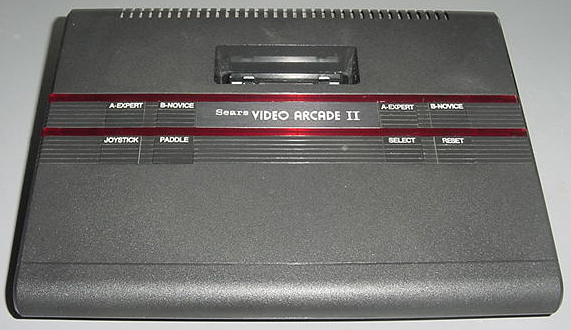
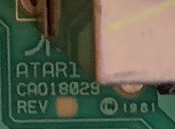
This system, model 637.75000, uses a special combination joystick/paddle controller (similar to the CX2700s). There are 4 controller jacks below the front edge, along with a power switch. On top are 8 buttons, each with its own LED. On the bottom are the channel (A/B) and TV Type switches. The pack-in game was Space Invaders. It also uses a power supply with a different connector, so standard VCS/2600 power supplies aren't compatible. The same case style, designed by Barney Huang, was later used for the 7800. Although the system was released in 1983, the board is dated 1981!
ATARI 2400 - model CX2400?
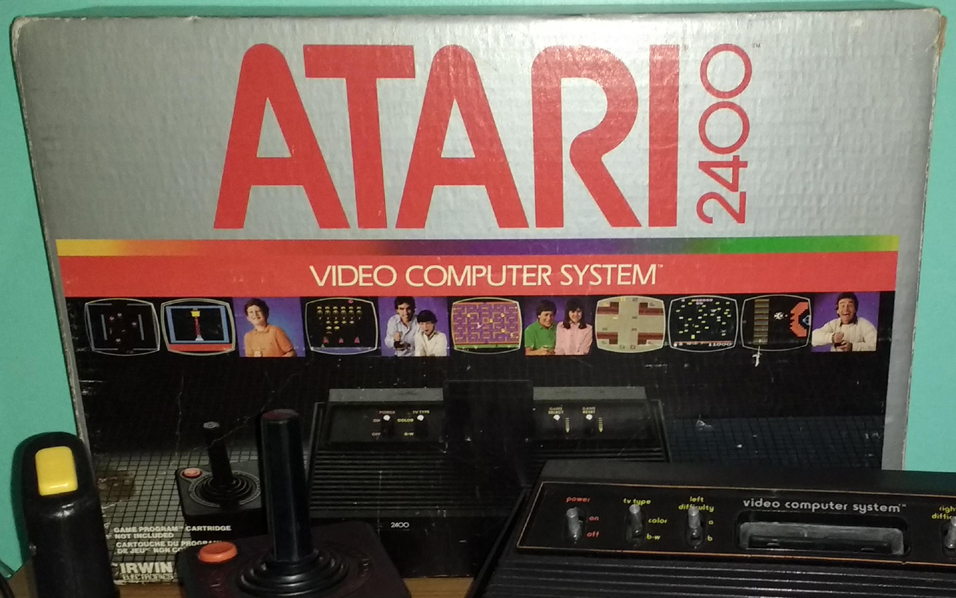
This is the Canadian version of the 2600A "Vader" (4-switch). The box states "Distributed in Canada by Irwin Electronics".
ATARI 2800 - model CX2800
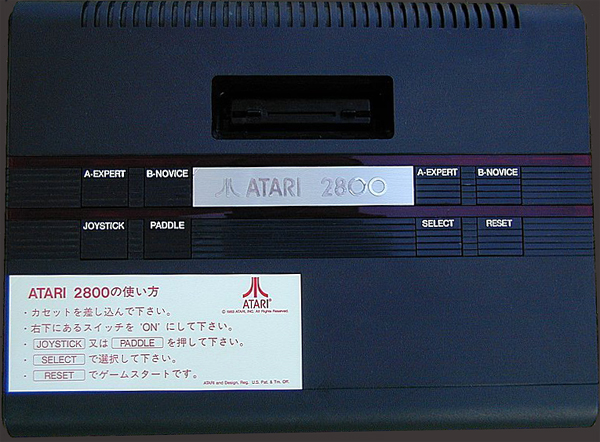
The Japanese counterpart to the Atari 2600. Same as the Sears Tele-Games Video Arcade II. The pack-in game was Space Invaders.
ATARI 7800 ProSystem - model CX7800
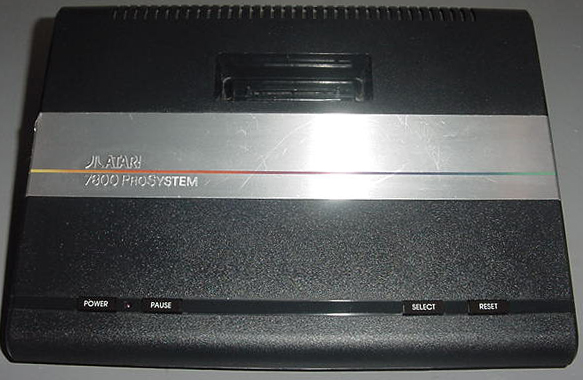
Initially announced on May 22nd 1984 (article) and officially shown at the 1984 Summer CES (article), but then mothballed for 2 years before being re-released in 1986. According to GCC's Steve Golson, the system was planned for release in late 1984, but was delayed for 2 years because of Jack Tramiel. This system uses the same-size cartridges as the VCS/2600 and has built-in software support for all but a handful of cartridges (see "Which VCS/2600 carts do not work on the 7800?" in the Software section of this FAQ for the latest compatibility listing). The motherboard actually contains all the VCS/2600 circuitry (including a TIA chip) and automatically switches between VCS/2600 and 7800 carts.
UNIQUE VARIANTS
ATARI VIDEO COMPUTER SYSTEM (VCS) "Promotional model" - model CX2600
This was special promotional version that was produced (in Sunnyvale) in limited numbers, in both 6-switch and 4-switch versions - the only differences are the switches are chrome (instead of brushed aluminum), the orange outline around the switches is yellow, and the box has "PROMOTIONAL USE ONLY NOT FOR RESALE" marked on it.
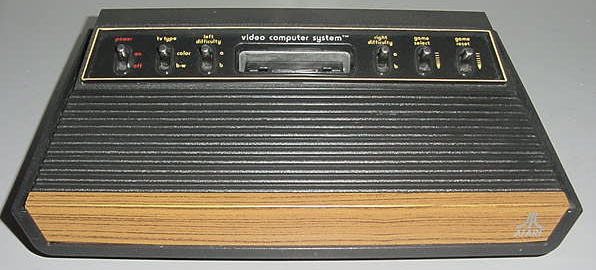
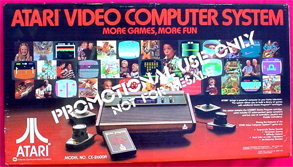
Some systems (only 4-switch model?) have "NOT FOR RESALE FOR PROMOTIONAL USE ONLY" hot-stamped into the bottom of the case:
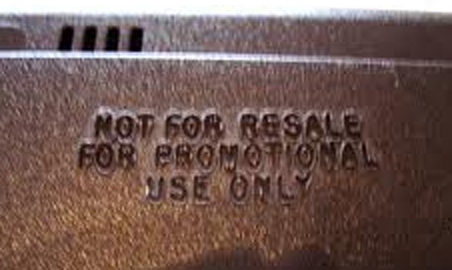
KEE GAMES PROGRAMMABLE GAME SYSTEM (PGS) - model CX2600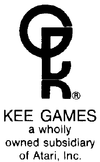
The photo below shows the only Kee Games VCS system known to exist (at least one fake was produced years later and shown at the MidWest Gaming Classic as though it was the original). As far as anyone knows, the Atari Gaming Headquarters site were the first outside of Atari to own this, and first posted photos of it online on May 15th, 1998 (LINK). They likely displayed it at the World of Atari show in August of that year, as they were both a co-sponsor and an exhibitor there. John Hardie was also a co-sponsor of WoA and likely acquired it while there, as it became part of Classic Gaming Expo's museum the following year (of which Hardie was a co-founder of). It's now part of the National Videogame Museum collection (of which Hardie is the director of), and the accompanying index card description that's with it offers no real information about it. To date, we don't know why this marketing prototype was created, who were involved, or what the provenance of the system is (When did Atari HQ acquire it, and from whom? Is the red shell case painted or solid red plastic?). What's worse, not only is the index card that's displayed with the system exactly the same as was shown with it at CGE word-for-word, it claims Kee Games designed it!
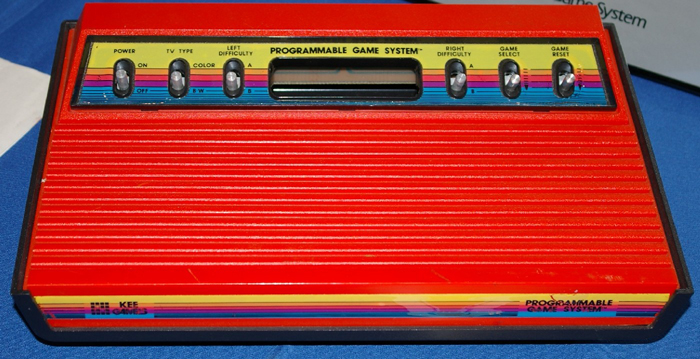
Kee Games was Atari's solution to circumvent arcade game distributors who demanded exclusivity deals with their competitors. The games Kee Games released were mostly original, but a few were clones of Atari games:
Elimination
Formula K
Spike
Tank
Tank II
Twin Racer
Indy 800
Tank III
Quiz Show
Sprint 2
Tank 8
Drag Race
Super Bug
Witch Hunt
Sprint One
Ultra Tank
The ruse started in 1973, but by the following year most people were aware of Atari's strategy. Starting in 1975, Atari openly admitted the connection in their literature, and by 1978 the 2 companies "merged". The same problem with distributors didn't exist with the home market, and Atari already had a clone with the Sears Tele-Games model, so the reason for why Atari would have produced a Kee Games VCS model is still unknown.
Q: Where were Atari's systems and games made?
A: The first year (1977), all production was done at Sunnyvale, CA. The following 2 years (1978-79) saw production shifted to Atari's Hong Kong facility, Atari-Wong Ltd. (Atari owned 51 percent of Wong Electronics, according to this article). When the 2600A model was introduced (in 1980), the bulk of production was being done in Taiwan through at least 5 different companies :
Dimerco Electronics
Kingtek Electronics Co., Ltd.
Taiwan Manufacturing Corp.
Taiwan William Computer Manufacturing Corp.
TRW Electronic Components Company
Sunnyvale production of the VCS stopped in 1980 (according to former Atari technician Jerry Jessop, some 2600A models were produced there). By early 1983, the bulk of all production of home video games and computers was shifted to Hong Kong and Taiwan (article). An article in the V1N6 (March/April 1983) issue of Atari Age (pg. 2) mentions VCSs, 5200s, and the 400/800/1200XL computers were being made in Hong Kong, Puerto Rico, Ireland, and Sunnyvale, CA., but the article describes 5200 systems being assembled in Sunnyvale.
Q: What VCS/2600 clones exist?
A: The following are those currently known:
Q: What VCS/2600 adapters exist for other systems?
A:
Atari 5200 VCS Cartridge Adaptor - CX55
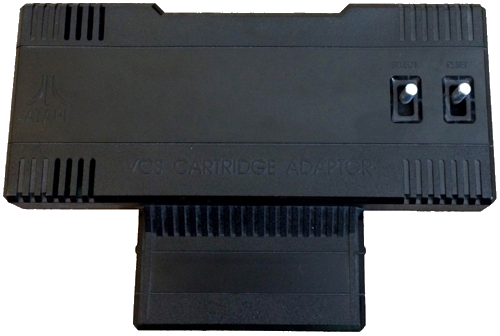
This device allows you to play your VCS/2600 games on the 5200 using any standard compatible 9-pin D-sub connector. The elimination of the TV Type switch makes it incompatible with several VCS games that use it as part of the game, which is ironic since Coleco and Mattel included it with theirs. Announced at the Summer 1982 CES, Atari Engineer George Howard designed it, and the reason it's so large is because it's basically a complete VCS console, much like adaptors for other systems! The only thing it uses the 5200 for is for power and to pass the audio/video signals on to the TV. The original 4-port 5200 consoles have to be modified in order for this to work on it. Rob Zdybel admits in this video he was the one responsible for making sure the 5200 wasn't backwards-compatible. He felt why would anyone want to play old carts on a next-gen system? The fact it took nearly a year for Atari to release it when it was mentioned in the original press releases for the system is yet another example of just how ineffectual Kassar's leadership was.
Cardco VIC-20 Cardapter
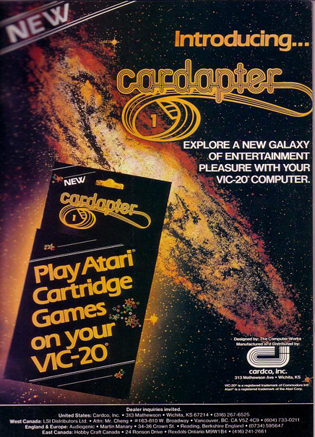
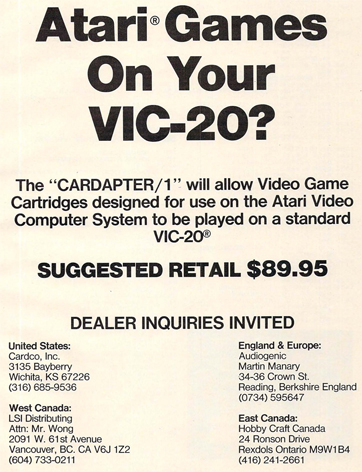
The September 1983 issue of Electronic Games (pg. 41) shows an advertisement for Cardapter, a VCS/2600 cart adapter for the VIC-20. The October 1983 issue of Electronic Fun (pg. 26) lists a price ($89.95) and the distributor's address - 313 Mathewson, Wichita, KS 67214. The distributor was Cardco, Inc. in the US, LSI Distributors Ltd in West Canada, Hobby Craft Canada in East Canada, and Audiogenic in Europe. The device was shown at the 1983 Winter CES (Creative Computing, April 1983, pg. 43). Emulation quality and reliability are unknown. The article states the device was shown with much secrecy in an out-of-the-way hotel room with a rent-a-guard at the door. It was housed (temporarily) in an orange cardboard and Scotch tape box, and plugged into the VIC-20's expansion connector. There was a slot for VCS carts to plug into, and a pass-through connection for the expansion connector. The VIC-20's function keys take the place of the VCS switches and the whole thing "worked like a charm". Retail price was $89.95.
Coleco ColecoVision Expansion Module #1

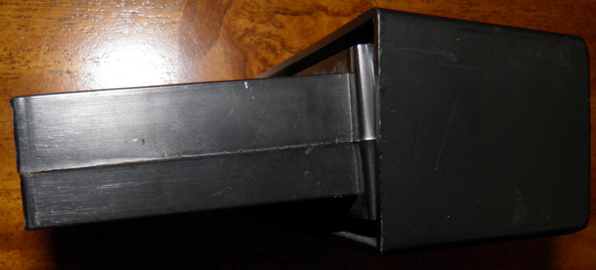
Made by Coleco, copyright 1982. Priced at $60 and available late 1982/early 1983 (listed in the January 1983 issue of Electronic Fun, pg. 12). This was the first VCS adaptor made for any system (and nearly a year before Atari's 5200 adaptor), and instantly gave the Colecovision the largest software library available for any system. It includes all the console switches an Atari system has. Black, 5" x 10", 1 3/4" high in front, sloping to 2 3/4" in back. Chips inside are: "COLECO 73192 E4002" (TIA clone?), SY6507, SY6532. Curiously, there is an empty space for a 14 pin chip and assorted resistors and capacitors on the right side of the circuit board. The space for a "Y1" indicates that this was probably intended to be a clock generator - could this board also have been intended for standalone use, such as in a VCS/2600 clone? There is also an adjustment hole on the bottom that turns a potentiometer (probably for color). The Reset button on the main ColecoVision console acts as a hard reset for the Expansion Module #1. Sample wording:
| ColecoVision Model No. 2405 Coleco Industries, Inc., Amsterdam, NY 12010 Serial # A0065820 For service help call: F.C.C. ID# BNV8432405 1+800+842-1225 Coleco Industries, Inc. (Nationwide) Made in U.S.A. Printed in U.S.A. 74859A |
Coleco later offered a Cartridge Extender to owners having issues with some 3rd-party cartridges not fitting properly (Texas Chainsaw Massacre, most Tigervision cartridges, and the Supercharger). Coleco sold these for $30 each by request, but owners of the Expansion Module #1 were entitled to one (and only one) for free, as long as they could provide Coleco with the serial number from the Module. Coleco was still providing these as late as January 1985!
A day after Atari's infamous "Pearl Harbor day" announcement on Wall Street, they sued Coleco over the Expansion Module #1. Here's an article from the April 1983 issue of Electronic Games (pg. 10), and a follow-up article from the September 1983 issue (pg. 16). Coleco claimed the module only used "off the shelf" parts and didn't infringe on any of Atari's technology, but one only needs to open up a module (or a Gemini console) to see it uses a copy of Atari's proprietary TIA chip made by VTI (article). From Michael Current's website:
| December 8th, 1982 - Atari announced that it had filed suit in U.S. District Court, Northern District of Illinois, Eastern Division against Coleco Industries, charging patent infringement and unfair competition under State and Federal law. Atari's lawsuit sought a preliminary and permanent injunction against the manufacture and sale of Coleco's Expansion Module No. 1 which was intended to allow Atari's VCS compatible cartridges to be played on the Colecovision home video
game unit. Atari claimed that the Coleco cartridge adapter infringed two basic video game patents held by Atari--U.S. Patent No. 4,112,422 covering motion objects commonly referred to as players, missiles or sprites and U.S. Patent No. 4,314,236 relating to digital generation of sound and noise especially suitable to video games. Coleco said it would file a counterclaim charging violations of antitrust law by Atari. March 11th, 1983 - Atari Inc. and Coleco Industries announced they had settled their December 1982 lawsuits against each other. Under their settlement, the companies said Coleco could continue making and selling its ColecoVision Expansion Module No. 1 and also could ship its planned Atari 2600-compatible Gemini Video Game System. However, Coleco would do so as a licensee of Atari's patents, and would pay a royalty to Atari. |
Mattel Intellivision System Changer
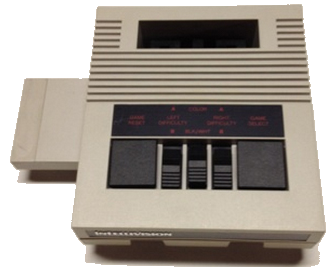
Made by Mattel, copyright 1983, and developed under the code name "Portofino". It was originally called the Intellivision Expansion System A in an early press kit before being slightly redesigned and renamed the Intellivision System Changer. Mattel decided to one-up Coleco and release its own VCS adaptor for their Intellivision, thereby instantly giving it the largest software library available. It includes all the console switches an Atari system has. White, roughly about 5-6" square and 2" high, with a piece sticking out of the left side that fits into the Intellivision cartridge slot. Front face had two standard joystick ports. Known to work with virtually all VCS/2600 carts except those that don't work with other adapters. Sample wording:
| (one white label and one orange label) "Model No. 4610 FCC ID: BSU9RD4610 Serial No. 003255 |
The Changer does not work with the "original" (2609) Intellivision Master Component without factory modification
(see this website for more info).
Contrary to statements on the Intellivision Lives website, the Atari VCS is not comprised solely of "off the shelf" hardware. While they boast that Atari never sued Mattel over the System Changer, Mattel knew full well how difficult it would have been for Atari to prove Mattel was copying the TIA being Mattel obfuscated it by using COB technology.
Protecto VIC-20 Game Loader
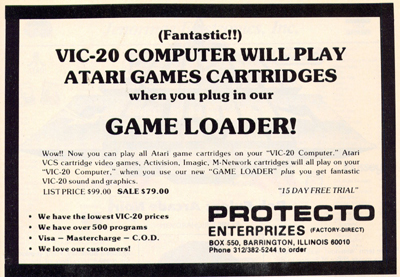

Rumored to exist. Was advertised by Protecto in mail order ads in during the 1983 time frame. Plugged into VIC expansion connector and provided VCS/2600 software emulation. The October 1983 issue of Electronic Fun (pg. 26) mentions the price and address. Emulation quality and reliability are unknown.
Retrode PC USB adapter
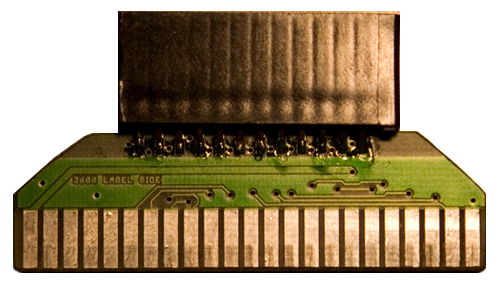
This adapter allows for the insertion of Atari 2600 cartridges in the Retrode’s SNES slot. See Retrode's website for more information.
Q: What VCS/2600 hardware was announced, but never released?
A: The short answer is quite a bit. Here are some examples:
Q: How do I hook up my Atari to a TV? Or, I've hooked up my system, but the picture is fuzzy.
A: The system originally used a manual RF switch box with 2 screws for the antenna (or cable) and a short, flat cable with 2 "fork" terminal leads coming off it for the TV:

The short, flat cable typically went to the (300 ohm) VHF screw terminals on the back of a TV. Since manufacturers stopped including the screw terminals with the rise of cable service providers and replaced them with a (75 ohm) coax connector, you'll need a small adapter (as shown in above photo). Likewise, the antenna screw terminals on the switch box will need an adapter called an impedance matching transformer (as shown in above photo) for attaching your current TV cable. Some switchbox variations have connections for both antenna and cable:
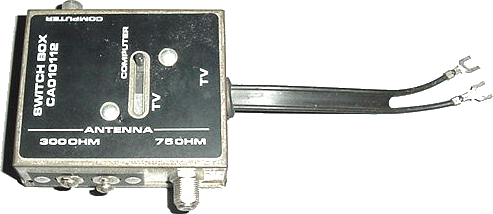
A picture that's snowy or lacking color usually indicates a connection problem. The system's RF cable may need to be replaced, or the problem could be with the switch box. Old switch boxes may have worn or dirty contacts insides. You can still buy new switch boxes from any store specializing in electronic parts, such as Radio Shack. Make sure you get a manual type; most (all?) systems starting with the NES use automatic RF switches. This type will not work for the VCS/2600 (or 7800), as the signal is not strong enough to trigger the switch completely. A manual RF switch, available at any Radio Shack or equivalent is needed.
A better alternative (picture quality-wise) to using a switch box is to eliminate it and connect the system directly by using a male coax- to- female RCA phono connector:
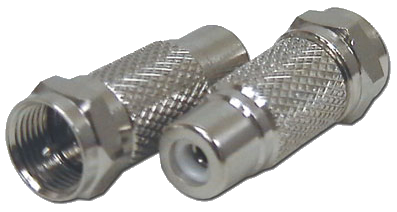
This will allow you to connect the system to any cable-ready TV.
Remember that having your TV set to the proper channel is necessary, no matter what method you use to connect the system. All but the original VCS/2600 "heavy sixer" models have a TV channel switch either on the back or bottom of the system. The switch sets the output signal to match either channel 2 or 3 on your TV.
If using a wide-screen TV, the ratio perspective will be different (16x9, instead of 4x3), so those used to playing with the original 4x3 perspective will find it a different experience. Flat-screen users (especially with LCD TVs) may experience display lag issues. HD TV users may experience upscaling issues (due to the system's inherent low-resolution). For optimal playing experience, it's best to use a CRT (tube) TV, preferably in standard 4x3 format.
Q: The colors seem wrong. How do I adjust them?
A: To properly adjust your system to the original specifications, you'll need an Atari Diagnostic cartridge. One of the tests on it brings up a color bar screen:

Note the gray reference bar. The purpose of this is to help in adjusting the color potentiometer that's on the motherboard. Most VCS/2600 cases (excluding all 6-switch models) have a small hole on the bottom, which lines up with the pot:
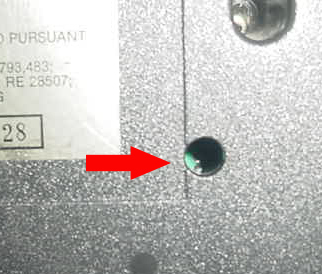
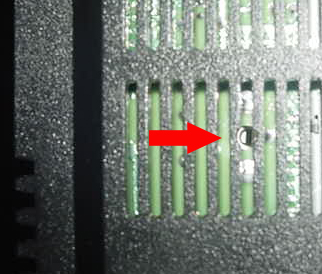
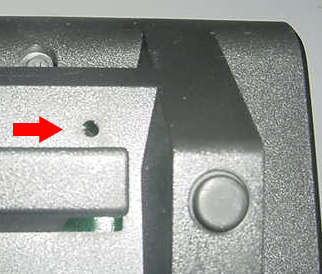
(4-switch model on left; "JR" model in the center; Sears Video Arcade II on the right)
By inserting a small, flathead screwdriver here, you can adjust the colors on the screen until the color bar directly above and below this reference bar are the same. Some of the heavy 6-switch models have an adjustment hole, but the "light" 6-switch models don't, so you have to open the case up. The aluminum casing has a hole on both the top and bottom of it that can be used to adjust the color. 4-switch models made by Dimerco Electronics in Taiwan don't have an adjustment hole either, and neither do 7800 systems.
Q: Where do I get my VCS/2600 fixed, or how can I fix it?
A: In general, it is usually more cost effective to buy another console. Ask online or at your local video game store; they may not offer to repair them, but they may put you in contact with someone who does.
If you're knowledgeable with repairing electronics, you'll want to see this 10-part how-to repair video for VCS/2600 systems. The May 1982 issue of Electronic Games also has this article by Henry Cohen on fixing systems that exhibit loss of color or snowy video. Best Electronics sells replacement parts for all the different Atari models.
Q: How many different controllers were made for use with the VCS/2600?
A: There were well over 100 different types of controllers, ranging from joysticks, paddles, keypads, and trackballs. There's also several 'specialized' controllers, such as light guns, foot controllers, and all-button controllers. Atari Compendium has a comprehensive list of nearly every one.
Q: How do I fix my joysticks and paddles?
A: The September 1983 issue of Videogaming Illustrated featured an article for beginners on how to troubleshoot and repair a standard Atari joystick controller.
Best Electronics sells replacement parts for Atari-made controllers - everything except the snap dome switches. Some parts, such as replacement controller cables, may work with 3rd party controllers.
Cleaning the exposed copper under the dome contact switches is often required after 40+ years. The easiest way is to 'razor' a square area around the switch and remove the original clear tape and switch. Clean the copper area with isopropyl alcohol an electronics cleaner. Inspect the dome switch for any visible cracks and make sure it still works as designed (ie. pops up when pushed down) before re-taping it to the pcb with clear packing tape. The dome contact switches used in most joystick and trackball controllers (with the fire buttons) commonly crack over time and usage and need to be replaced. Most controllers (both Atari and 3rd-party) used them, so any 'donor' controller would be a suitable source for replacements. Console5 sells replacement self-adhesive snap dome switches that were used in most controllers back then, although they are often out of stock.
Replacement CX40 pcbs with improved dome contact switches were first sold by Osgeld in 2018 for $7 each, but the company has since gone out of business. In 2020 the Ebay seller "commodore-kazz" designed and sold similar boards for $13; in 2022 he revised the board to have larger contact switches. Note: these replacement boards offer a more stiff 'feel' and those used to using the original design might not like them.
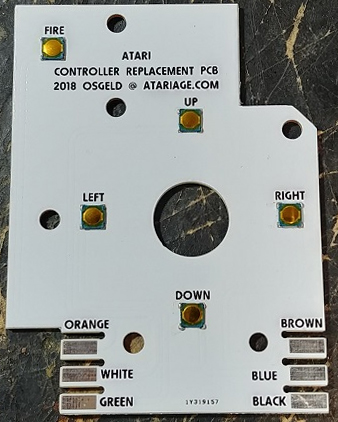
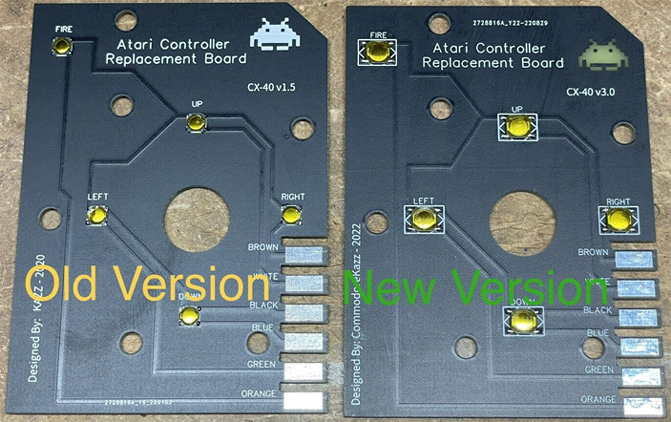
Replacement springs for the standard Atari joystick fire button can be made by using a spring from a ballpoint pen and cutting it approximately in half.
Dirty paddles are a cause of great frustration. To clean them, buy a can of Electronics Cleaner/Degreaser (available at Radio Shack, catalog #: 64-4345) or any type of TV tuner or metal contact cleaner, open up the paddles and spray directly into the pot area. Close them up, give them a few twists and they should be good as new. Do NOT use any type of oil or silicon spray (such as WD40) as this will gum up the contacts. In most cases, using cleaner only provides a temporary solution, as the pot may be too dirty. In that case, the pot will have to be opened and the contacts wiped down with cleaner or alcohol. This site shows you how to do it (the only difference is I also wipe down the contact ring that mates with the 'prongs'). The potentiometer used is 500K ohms. Brand new paddle pots can be purchased from Best Electronics (link), but they're pricey at $12 each.
Q: Do Bally Astrocade, MSX, or Texas Instruments joysticks work on the VCS/2600?
A: No to all of them. With the Bally Astrocade and MSX, even though they use the standard 9-pin connector, the pinouts are different. However, using the pinouts found in these Bally Astrocade and MSX FAQs, they can be rewired to work on the VCS/2600. Texas Instruments joysticks can be rewired as well, but it would require either replacing the controller wire (TI joysticks are wired in pairs, like Atari's paddles), or making an adapter. Both Suncom and Wico released adapters to allow Atari-compatible controllers to be used with TI computers (see this comprehensive controller listing). A schematic by Gary Cook for making an adapter to use Atari controllers with TI computers first appeared in the August 1983 issue of Compute! (pg. 16 info) and again in the September 1983 issue of Creative Computing (pg. 140 info). This could be altered to make an adapter for TI controllers. Jim Mallonee later revised this in the December 1983 issue of Compute! (pg. 14 info - the actual page incorrectly says "September" at the bottom!) to allow for 2 joysticks to be used. There's also a few recently-produced adapters (look on Ebay or Arcadeshopper).
Q: How do I use an Atari joystick on a PC/Mac?
A: Here are links to some adapters for the PC:
See this article on how to make your own USB controllers.
Q: What hardware peripherals exist for the VCS/2600?
A: Here's some that were released:
Comp-K7
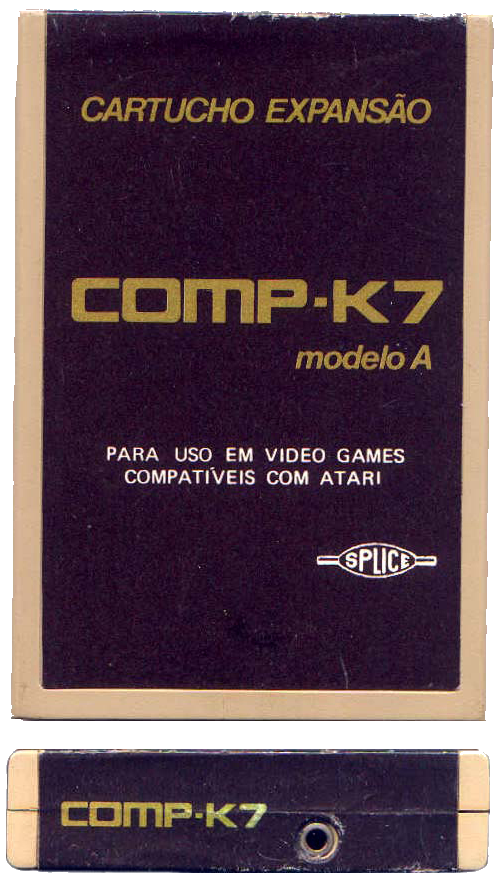
Made by Splice. A Brazilian Supercharger knock-off.
CompuGame
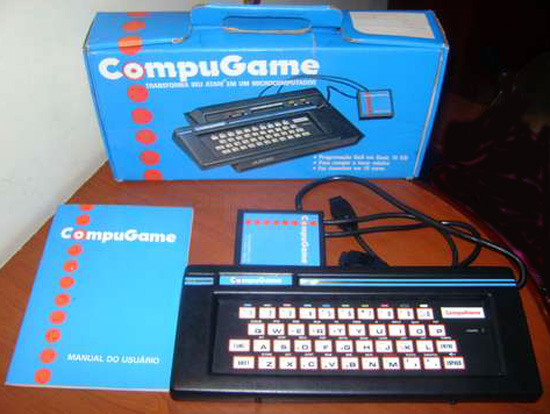
Made by Sosecal. Brazilian version of Spectravideo's CompuMate keyboard.
CompuMate
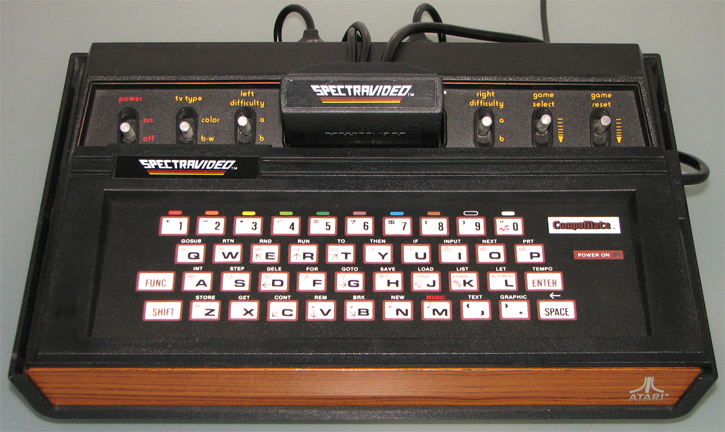
Made by Spectravideo. This is a 42-key touch pad-style computer add-on that adds 16K ROM, 2K RAM, a 2-channel + 2 octave music composer, BASIC, and Magic Easel. The unit looks like a small keyboard connected to a cartridge, which has 2 cables that connect to the controller ports. It has 3 function/display modes: Text (which runs BASIC), Graphic (which runs Magic Easel) and Music. Magic Easel allows you to create photos (with up to 10 different colors) and animations (up to 9 frames) using the joystick). Originally sold for $79.99. This was once quite rare to find until a large quantity surfaced in Venezuela in 2010. There's also a German version made by Universum.
Dactar-Comp

Made by Milmar. A Brazilian CompuMate knock-off.
Digigame K7

Made by Digitel. A Brazilian Supercharger knock-off.
Game Changer
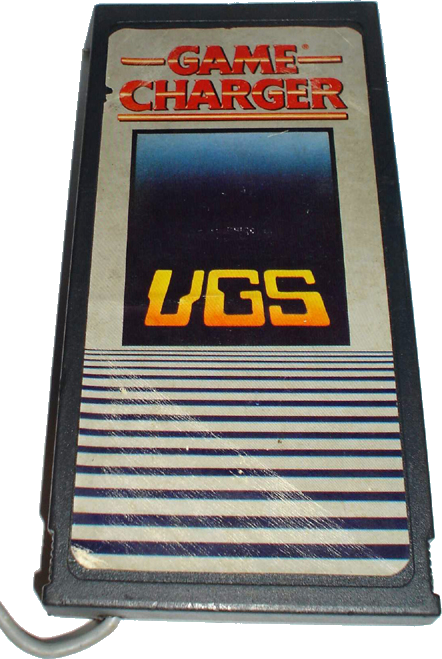
Made by VGS. A Brazilian Supercharger knock-off.
GameLine Master Module
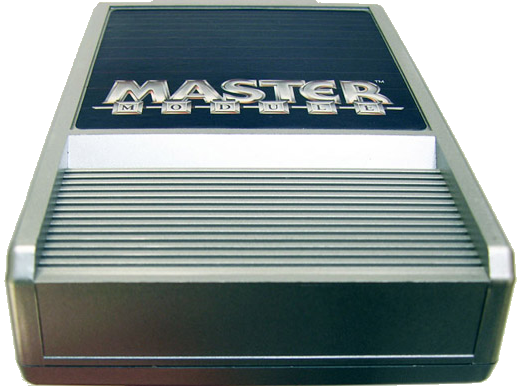
Made by CVC. See the GameLine entry in the Software section for more info.
Kid Vid Voice Module
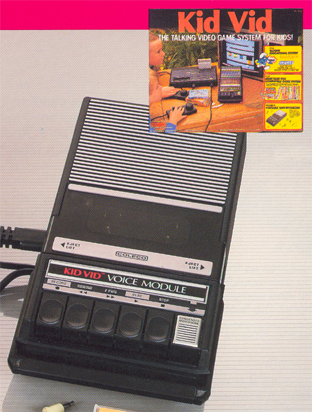
Made by Coleco. This was a cassette recorder and cartridge interface. Additional wire connects recorder to joystick port. Voices and songs tell player what to do on screen. Tape shuts off automatically to wait for player input. 3 tapes per game, only games were Berenstain Bears and Smurfs Save the Day.
Personal Game Programmer
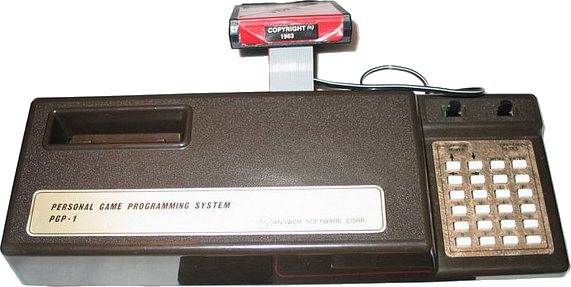
Made by Answer. Similar to the Game Genie. Available directly through Answer Software for a short time (for $200), this peripheral allows you to change the code on existing games to your own liking. It doesn't actually store the changes on the cartridge - all effects are temporary. Brown and gold with white keys, the unit sits on top of the Atari 2600. Two cables: one to the cartridge port and one to the power receptacle, connect it. Only 2 are known to be in existence: Al Backiel got his direct from Answer, who later sold it to John Hardie, and Marco Kerstens got his from William Sommerwerck.
Supercharger
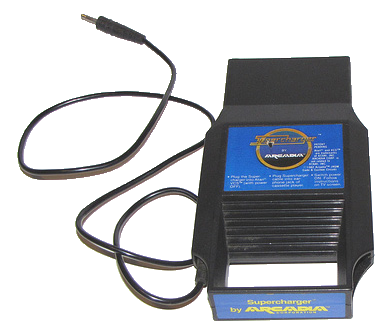
Made by Starpath. This is an add-on device that improves the Atari VCS memory, graphics, and sound capability. The unit itself contains 6K RAM and 2K ROM. ROM is in top 2K and RAM is banked in lower 2K. The additional 6K of screen RAM was a huge improvement over the hardware's 128 bytes. Games were distributed on cassette tape. By plugging the Supercharger into the VCS and connecting its cable (with a standard 1/8" jack on the end) to a standard cassette tape player, games could be "loaded in" to memory. Phaser Patrol was also included. The unit initially retailed for $70, but in January 1983 the price was reduced to $45. The device won't fit in Coleco's Expansion Module but Starpath provided an extension adapter upon request.
Telegame
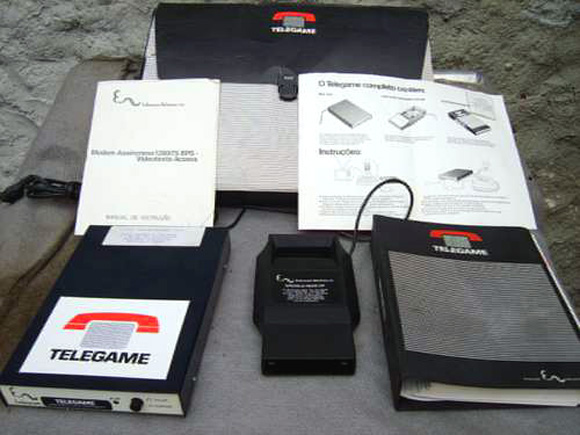
Made by Embracom Electronica. Basically a Brazilian knock-off of the Supercharger.
Game Selex
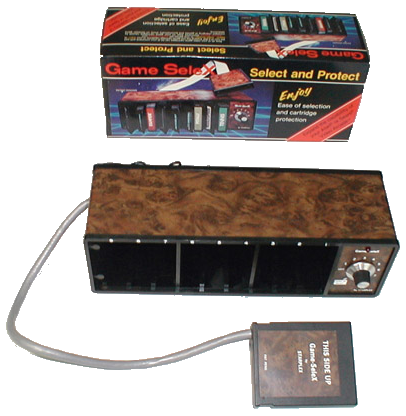

Made by Starplex Electronics, Inc. This was available in either a 9 or 24-cartridge multicart switcher. By turning a dial you can switch between them. The VCS power supply plugs into the back of it, and a wire from the Game Selex plugs into the power jack on a VCS. A note came with it stating if you see excess static with the device attached, Starplex would provide anti-static filters at no cost.
ROMScanner
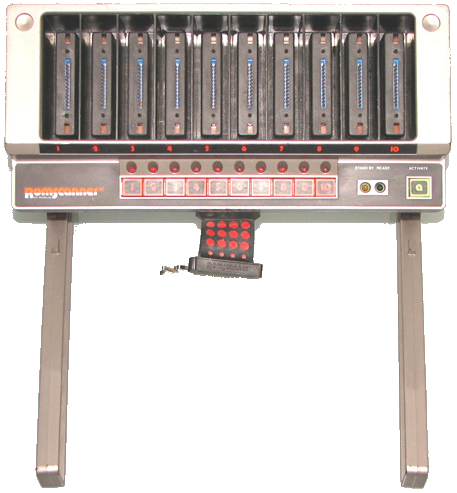
Made by Marjac. A 10-cartridge multicart switcher. At the press of a button, you can switch between them. This was even advertised in the Atari Age, V2N4 (pg. 22), priced at $49.95!
Six Pack
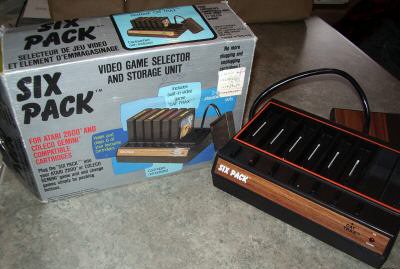
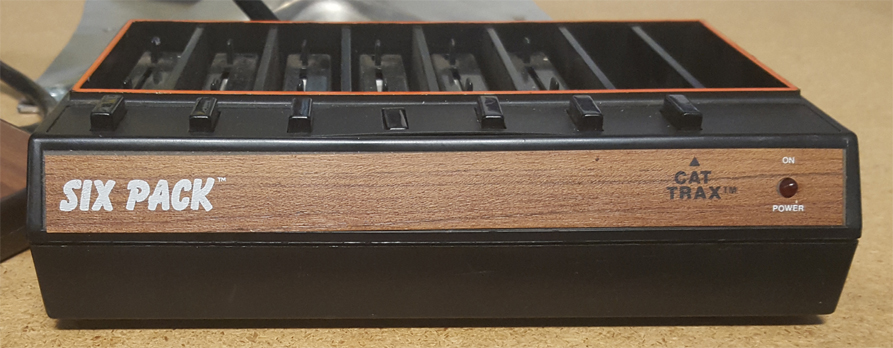
Pirate version of RGA International's Video Game Brain, except this variant has Cat Trax built-in!
Video Game Brain
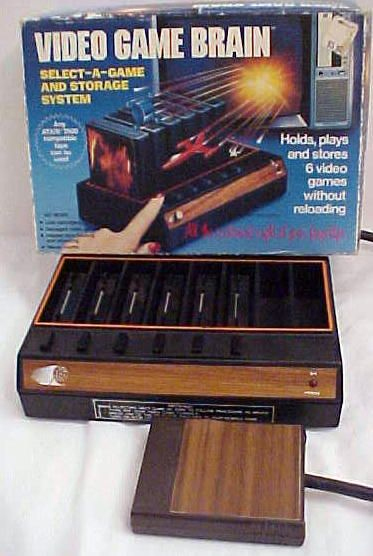
Made by RGA International. A 6-cartridge multicart switcher. Made in Hong Kong. The cartridge shell is the same as those used by UA Limited. Warning - this device can damage your games, your system, or both, due to how it's internally wired. Voltage is constantly running through the address and data lines while the power line is floating, when a cartridge is NOT selected! It's possible to modify the device to operate properly and safely, otherwise don't use one until it's been fixed.
Videoplexer
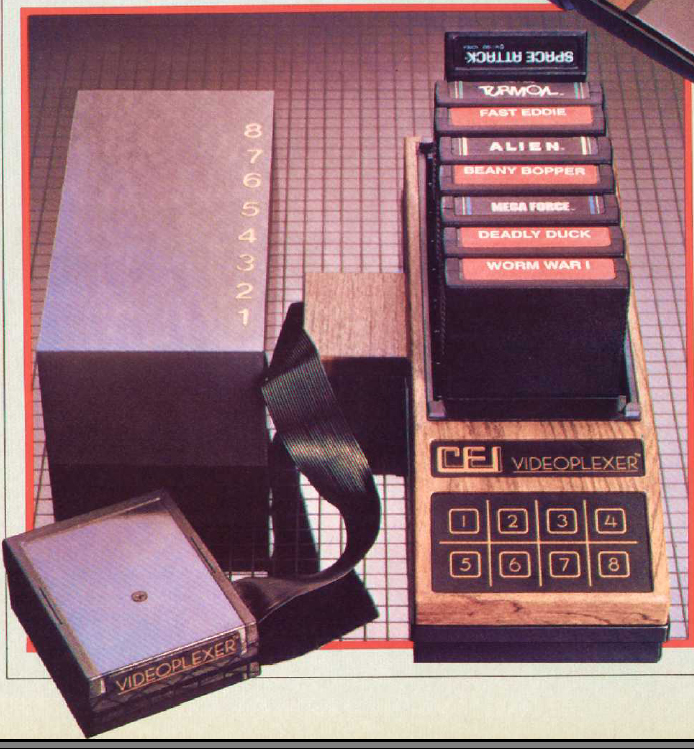
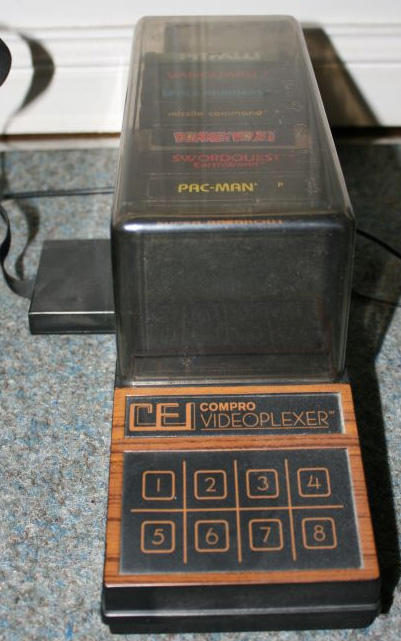
Made by Compro Electronics, Inc. An 8-cartridge multicart switcher, with a smoke brown plexiglass hood and 8 sensor touch buttons on the front panel. The manual claimed to "Reduce the wear on your expensive system and cartridges".
Q: What are the differences between NTSC/PAL/SECAM games?
A: NTSC (National Television Standards Committee), PAL (Phase Alternating Lines) and SECAM (SEquentiel Couleur Avec Memoire) are different worldwide, generally incompatible television standards. Why is this information important? Different carts will exhibit different characteristics based on what kind of TV and console are used. For example, a PAL cart on an NTSC console and TV will roll the screen and exhibit a strange color scheme. An adjustable vertical hold is a must in these situations. Another issue is NTSC versions will be ~10% faster and PAL ~7% slower. This is especially important with any contests that involve players from different countries. Most companies developed games in NTSC and later converted them to PAL. Since programmers were mainly concerned with having a stable image and acceptable colors, no time was spent on adjusting gameplay so that it ran identical to the NTSC version. As a general rule, PAL players have an advantage over NTSC players, making any fair competitions between the two impossible. Atari Compendium maintains an NTSC/PAL/SECAM Scanline List with more detailed information.
Q: Why do some 6-switch systems have vent holes in the top of the case?
A: The VCS was originally designed to produce sound effects internally via 2 internal speakers (much like Atari's earlier dedicated systems), instead of through a TV (via the RF box). The system’s casing has slits on the top-half and brackets on the bottom-half - these were for the speakers. Arcade games from the mid-70s often used 2 speakers, with each being driven by a separate tone generator - one for each player. Atari's Tank coin-ops used this design. This "dual mono" tradition carried over to the VCS, as the system has 2 independent sound generators. Jim Heller, who was a former Atari engineer, stated a last-minute production change was made to drop the internal speakers, since it was felt the audio would be better through the TV set. Due to this change, the 2 sound output pins (pin 12 is the left channel audio and pin 13 is the right channel audio) on the TIA were simply tied together, resulting in mono sound. This also explains why 4 of the 9 launch titles (Combat, Air-Sea Battle, Indy 500, and Street Racer) were programmed for stereo sound. Space Invaders also was programmed to use both channels separately.
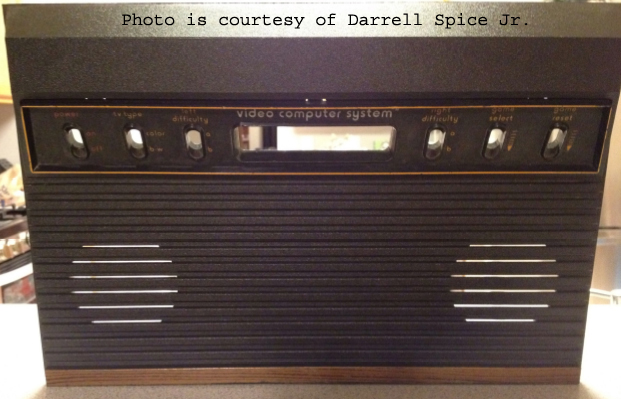
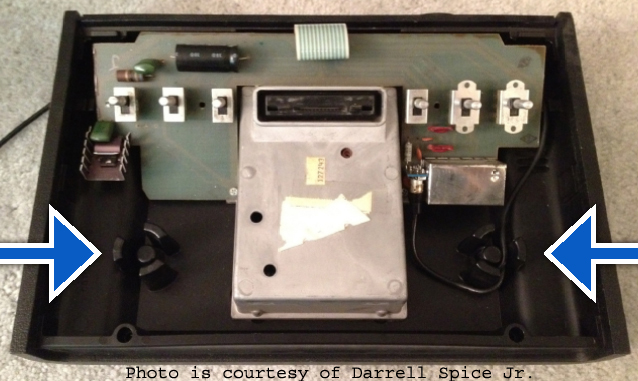
The "stereo" mod (described in the Projects section of this FAQ) sends the outputs of one generator to the left channel and the other to the right. As far as "using" stereo is concerned, the games can be divided into 4 categories, though there is some overlap. The 2 channels can be used in the following ways:
1) Some games only use one generator. All the sound will come from one channel, with nothing from the other.
2) Some games use each channel for a particular purpose. This division may or may not make sense spatially or aesthetically. Combat, for example, will use one channel for the left player's vehicle noises, shots, and explosions, and the other channel for the right player's. These assignments will remain constant regardless of where the vehicles move around on screen, so they may not make much spatial sense in relation to where the players are sitting in relation to the screen.
Other games may use one channel for background noise and the other channel for shots and explosions. In that case, a left/right division might not be meaningful, but having one speaker closer than the other might be good. With the homebrew game, Medieval Mayhem, any sounds for left side castles come out the left, and sounds for right side castles come out the right. It's also quite noticeable when the dragon flies across the screen.
3) Some games, such as Toyshop Trouble, allocate sounds to the two channels essentially randomly. This allows sounds to 'overlap' (e.g. if you paint two toys in quick succession, the sound for the second can start while the sound from the first is still playing) but would make things sound weird if the channels weren't mixed together.
4) Very few games output sounds to both channels but vary the amplitudes to create a "stereo" effect. Frogger and Turmoil are 2 games that use both channels to create true, 2-channel music. The homebrew games A-VCS-tec Challenge, Skeleton+, and Synthcart also take advantage of the system's stereo capability. The spear level in A-VCS-tec Challenge is programmed so you can hear if the spear is coming from the left or right side;
when reaching the middle of the screen, the sound
switches to the other side. Additionally, the spear sound gets louder when coming closer to the player,
so, in stereo you hear the spear fading in and out and flying from left to right or vice-versa. Skeleton+ uses the stereo to help players locate skeletons in the maze.
Q: Some motherboards have a space for another chip. What was this for?
A: The original version of the VCS was designed to have a game built-in (Combat for the Atari version and Air-Sea Battle for the Tele-Games version). All 6-switch motherboards have this. There's a space on the motherboard for the ROM chip:
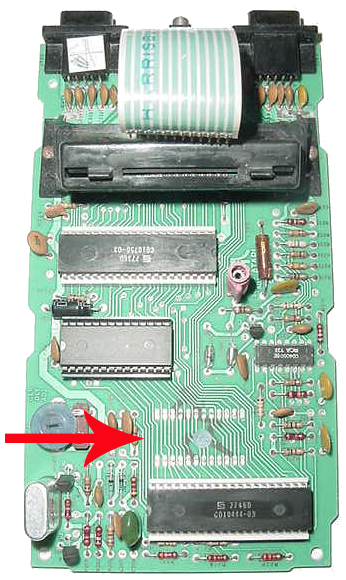
A 2K or 4K ROM chip could be installed here, however, there’s no circuit to switch between the ROM socket and a cart if a 4K ROM is used.
The "unicorn" 2600 "JR" variant also was designed to have a game built-in as well, and can handle a 2K or 4K ROM automatically if installed:
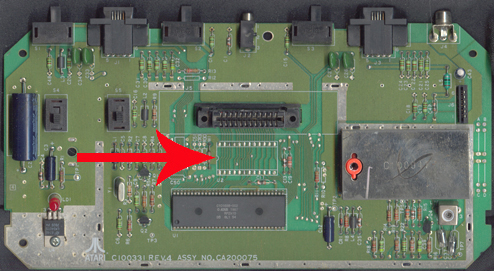
What game was to be included is unknown.
Q: What are the specs for the VCS/2600?
A: The system has 3 main chips at its heart - the MPU, the TIA, and the RIOT. The MPU is a 6507 (by MOS), which is a low-cost variant of the popular 6502. The TIA is the Television Interface Adapter and is an Atari proprietary chip. It was made by over a half-dozen manufacturers, resulting in dozens of variations (see my TIA chip article). The RIOT is a 6532 RAM, I/O, Timer chip (by Rockwell). Early models contain a 4th chip - a 4050 CMOS hex buffer - that was later removed due to being unnecessary.
| MPU (or CPU) | 6507 |
| RAM | 128 Bytes, in VLSI |
| ROM | 4K maximum |
| MPU clock | 1.19 MHz |
| graphics clock | 1.19 MHz |
| slot configuration | ROM access only |
| MPU available | less than 50% |
| total colors available | 128 (NTSC), 104 (PAL), 8 (SECAM) |
| total audio available | 2 channels (mono) |
| ports available | 1 cartridge slot, 2 controller ports |
| total onscreen objects available | 5 (2 "player" sprites, 2 "missile" sprites, 1 "ball") |
Notes: ROM specs are based on non-bank select scheme, and the graphics clock is the master clock used to drive the TIA video chip.
For more information about Atari's TIA chip and how it works, check out Andrew Towers' TIA Hardware Notes article.
Q: How large (memory-wise) do VCS/2600 games get?
A: The range is 2K, 4K, 8K, 16K, 32K (Fatal Run), and 64K (32-in-1 and Mega Boy). Games using 8K or more require a programming technique called bank-switching (patent 4,368,515 and patent 4,432,067). Bank-switching increases the amount of a system's usable memory beyond the amount directly addressable by the processor. The programming technique was known about since 1971, as it was discussed in C. Gordon Bell and Allen Newell's book, Computer Structures: Readings and Examples. In the case of the VCS/2600, the system's inherent cartridge ROM limit is 4K. Larry Wagner's and Bob Whitehead's development of Video Chess also led to the use of bank-switching on the VCS. Atari's Asteroids was the first game released to use bank-switching, resulting in an 8K ROM. Unfortunately, even with the huge success of VCS Asteroids, Atari was slow to accept the higher cost of using larger ROMs, and finally agreed to after the backlash it received over VCS Pac-Man. By the following year (1983), all 'A-list' titles used ROMs of at least 8K. Other companies soon learned from Atari's mistake and started using bank-switching by 1983 as well. Activision developed their own method (for Decathlon and Robot Tank), as did Parker Brothers and Tigervision. Most companies simply used Atari's method. More information about the different bank-switching methods can be found on Kevin Horton's website.
A few companies (Activision, Atari, CBS Electronics, CommaVid, Mattel, and U.S. Games) developed special RAM chips or "SuperChips" for certain games.
Activision called theirs the Display Processor Chip, or DPC. It was named after the person who developed it - David Patrick Crane (patent 4,644,495). According to Crane,
| The DPC chip added more graphic capability as well as 3 channel music (plus drum), and made Pitfall II: Lost Caverns possible. Unfortunately, the 2600 business died before any other games could take advantage of that technology. |
Atari called theirs SARA and used them in the following games:
Both Garfield and Zoo Keeper were to use the SARA chip as well. The following homebrew games also use the SARA:
CBS Electronics called theirs RAM Plus, and it added 12K of ROM and 256 bytes of RAM. It was used in Omega Race and Tunnel Runner (Wings was to be the 3rd).
CommaVid developed "Extended RAM" cartridges for Magicard and Video Life that offered 2K of ROM and 1K of RAM. According to a company ad, it "provides eight times the RAM available to a normal 2600 Video Computer System game." It was developed by Dr. John Bronstein, who received patent 4,386,773 for it.
Mattel/M Network called theirs "Super Cartridges" and added up to 16K of ROM and 2K of RAM ("Big Game" was printed on the prototype carts), but BurgerTime was the only game they released that used it (In Search of the Golden Skull was to be another).
U.S. Games had a special "RAM/ROM" chip for their Pink Panther game ( both developed by James Wickstead Design Associates), which added 8K of ROM and 2K of RAM., but the company went under before it was produced. NAP bought the Pink Panther game from them, along with the RAM/ROM chip. According to an interview with NAP's Bob Harris (in the spring 2001 issue of Classic Gamer Magazine) NAP hired a company to fabricate the RAM/ROM chip , but unfortunately, the new chips failed and the Probe 2000 division was shut down as a result.
See this article for more information about these, as well as the newer 'homebrew' bank-switching methods.
Q: What is the VCS/2600 pinout information?
A: Controller port pinout:
The fire button for Paddle A is LEFT; the fire button for Paddle B is RIGHT.
Top
D3 D4 D5 D6 D7 A12 A10 A11 A9 A8 +5V SGND
--1- --2- --3- --4- --5- --6- --7---8- --9- -10- -11- -12-
GND D2 D1 D0 A0 A1 A2 A3 A4 A5 A6 A7
Bottom
Top Row
|
Pin |
2716 Pin |
MPU Name |
Description |
| 1 | 13 | D3 | Data 3 |
| 2 | 14 | D4 | Data 4 |
| 3 | 15 | D5 | Data 5 |
| 4 | 16 | D6 | Data 6 |
| 5 | 17 | D7 | Data 7 |
| 6 | * | A12 | Address 12 |
| 7 | 19 | A10 | Address 10 |
| 8 | n/c | A11 | Address 11 |
| 9 | 22 | A9 | Address 9 |
| 10 | 23 | A8 | Address 8 |
| 11 | 24 | +5V | +5 VDC |
| 12 | 12 | SGND | Shield Ground |
* to inverter and back to 18 for chip select
Bottom Row
|
Pin |
2716 Pin |
MPU Name |
Description |
| 1 | 1 | A7 | Address 7 |
| 1 | 2 | A6 | Address 6 |
| 3 | 3 | A5 | Address 5 |
| 4 | 4 | A4 | Address 4 |
| 5 | 5 | A3 | Address 3 |
| 6 | 6 | A2 | Address 2 |
| 7 | 7 | A1 | Address 1 |
| 8 | 8 | A0 | Address 0 |
| 9 | 9 | D0 | Data 0 |
| 10 | 10 | D1 | Data 1 |
| 11 | 11 | D2 | Data 2 |
| 12 | n/c | GND | Ground |
A standard VCS/2600 cartridge contains the equivalent of a 2716 or 2732/2532 with one notable exception: the chip select line is active high, not low. The high order address line of the 6507 (A12) is used as the chip enable. There was at least one company that used EPROMs with a 74LS04 inverter to compensate for this. Note that numbers indicate left to right numbering.
On cartridges, GND was also connected to SGND. Best to make sure that they are wired together.
Q: What are the AC Adapter power supply specs?
A:
VCS/2600:
| Rating | 9VDC, 500mA |
| Plug type | 1/8" phone |
| Polarity | Tip positive |
| Alternative | All Atari-made models of the VCS?2600 have compatible power supplies |
2800/Sears Video Arcade II
| Rating | 10VAC, 750mA |
| Plug type | coaxial ??mm/??mm |
| Polarity | n/a |
| Alternative | Atari 5200, Atari Jaguar, SMS / Genesis, TurboGrafx-16 |
7800:
| Rating | 9VDC, 1A |
| Plug type | unique |
| Polarity | n/a |
| Alternative | None, although a 1/8" phone jack can be added and a VCS/2600 AC Adapter used |
A: The TV Boy is a handheld-sized Atari VCS/2600 (made by SystemA) with 127 built-in games that connects to your TV (it does not have its own screen). It's basically the first VCS/2600 "Plug-n-Play" type of system, years before the Flashbacks. While it features a built-in GameBoy-like joypad and external 9-pin ports so one can connect one's favorite controller, it does not, alas, have a cartridge slot. Inside the TV Boy is a jumper marked "NTSC/PAL," so it appears that it will work on either type of TV. See the "clones" section here for a list of different versions.
A: The Flashback is a miniature Atari VCS/2600 Plug-n-Play system, with most being made by AtGames. At least 30 different models were made since 2004 - none of which that are not without their own issues. The list of built-in games often varied with each model. All but the first few were emulator-based, with the most recent using Stella. See this review for a complete list of different versions.
A: The RetroN 77 is an emulator-based (Stella) system (made by Hyperkin) that allows you to use cartridges, but being it's emulator-based, it's not fully compatible with every cartridge _full cart compatibility is unknown). The system displays 1080p and supports both original and USB controllers. Original retail price was around $80; it was re-released with an upgraded joystick controller (the Trooper) which looks identical to the original.
Q: Are there any compatible FPGA consoles?
A: There are currently 2 that are commercially for sale. The Phoenix by CollectorVision Games is a FPGA-based Colecovision and VCS/2600 compatible system. MiSTer AddOns uses their Terasic DE10-Nano FPGA board. They currently have a very good Atari 8-bit/5200 core, and a serviceable VCS core (that is lacking in compatibility). There are also a 7800 and (new) 2600 core being worked on by one of the developers. MiSTer will accept pretty much any wired/wireless controller that exists, with the right adapter.
There's also a custom console by Chris Brenner called the Atariman that is housed in a case to mirror the look of a Sony Walkman.
|
TECHNICAL |
Q: Are there any published VCS/2600 technical articles available?
A: Here’s one from the March 1983 issue of IEEE spectrum, titled: Design Case History: the Atari Video Computer System. It is quite an interesting read, although it contains no code. I also have several others in the archives section.
Q: Are there any emulators for the VCS/2600?
A: Several, although only javatari and Stella are still maintained and updated:
Q: How do I archive or dump cartridges?
A: Modified 7800 system - see Eckhard Stolberg's Atari 7800 Developer's Page for more information.
Several different cartridge copier devices were made:
Atari Game Recorder
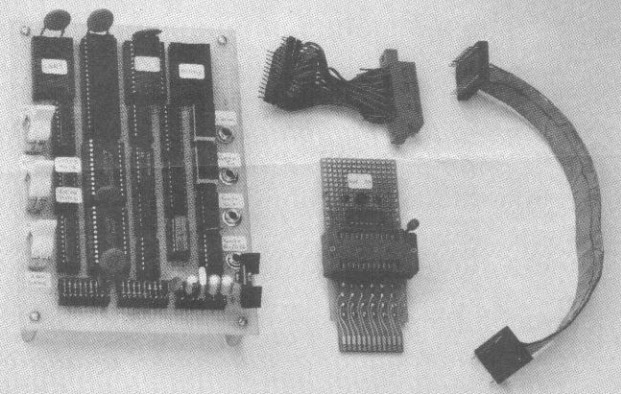
The Atari Game Recorder is a device that copies carts to cassette tape and also admits the playing of games from tape. Instructions and schematics are in the following issues of Radio-Electronics (it's a three-part article):
Dec 84 Vol 55 no 12 pg. 69-72.
Jan 85 Vol 56 no 1 pg. 51-58.
Feb 85 Vol 56 no 2 pg. 69-72.
The article was written by Guy Vachon and David A. Chan. The construction of the AGR is not for the faint of heart, and the device does not handle bank-switched carts - you're limited to 2K and 4K games only.
Atarimax Maxflash USB Cartridge Programmer
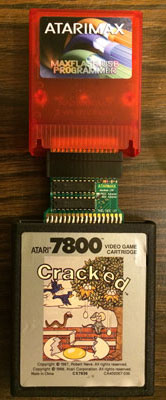
Currently sold by AtariMax, this modern device can be used to dump cartridges for several different systems (coupled with a Dumping Adapter) including Atari VCS/2600, 5200, 7800, Colecovision, and Intellivision.
Copy Game
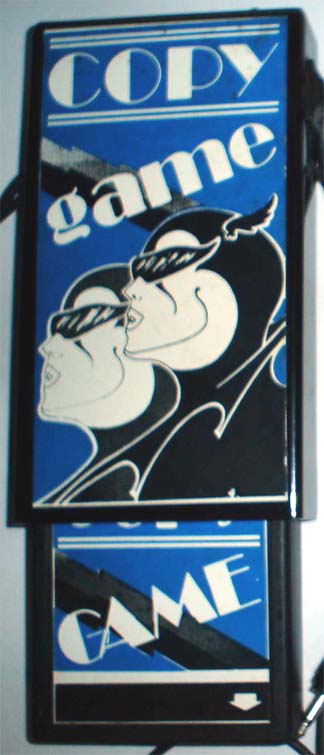
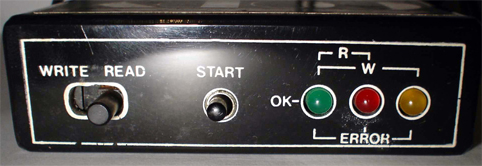
Made by VGS. A device released in Brazil that allows you to copy cartridges. It looks similar to a Xonox cart shell, with switches and LEDs on one end, and a cartridge port on the other. You plug in the cartridge you want to copy and read it into the device's memory. You then plug in a 'blank' EPROM cartridge and write the device's memory to it.
Duplicator
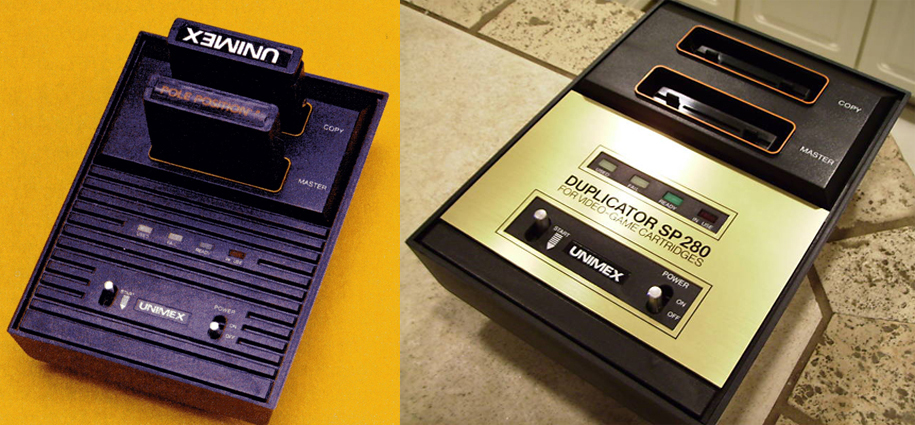
Made by Unimex. Upon its release in 1984, the Unimex Duplicator cost 200 DM, about as much as the 2600 itself. Like the Yoko, it feeds off of the 2600's power supply. There are 4K, 8K and 12/16K EPROMS available for the Duplicator. Similar in appearance to half of a 6-switch VCS, it has a MASTER and a COPY slot. Copying a game takes about 8 minutes. Small changes in voltage, however, will cause the copying to fail, and not all new EPROMs work. So far, the system has only been found in Germany. There are 2 versions - one that's all black, and the other that has a gold plate on top.
EPRO 2000
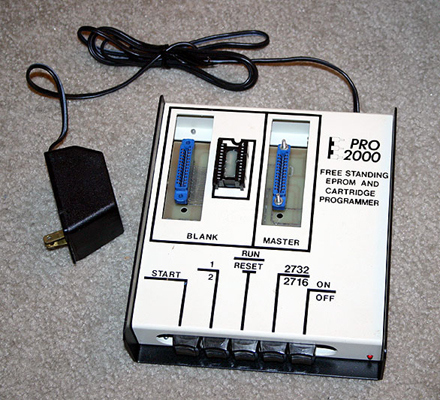
Made by Pete McKevitz. Allows you to copy 2K and 4K carts to either an EPROM, a blank cartridge, or both (at the same time). You can also put two 2K games on a 4K EPROM and flip between them via a toggle switch (using the included blank cartridge). How many were made/sold is unknown, but John Hardie found close to a dozen units, with most of them being complete; he sold one (complete with cart and manual) to Jose "wonder007" Artiles in 2006, and brought another to CGE2K7. A 3rd one is on display at the Digital Press store. Mr. McKevitz contacted me in October 2012 and provided the following information:
|
I designed and built that programmer around 1981/ spring 1982. As far as development went, I had a shop back then called Pete's Electronic Service & Supply. We were selling satellite TV equipment, Apple II clones, and a few other things, and I did PC board design on the side. I had a good friend named Paul who worked at a Radio Shack down the street from the shop, and after a little persuading got him into Pete's. We worked on the project together and came up with the E-Pro 2000. We actually hand-built about 100 units. I remember placing a half-page ad in Computer Shopper, when it used to be the size of a large Metropolitan phone book. Sales were not good. Atari went into bankruptcy a few weeks later and we scrapped the project and liquidated the entire stock to a fellow in Texas at around $30.00 bucks a piece. I still have motherboards, mem xfer boards, a few game boards, and assorted parts, such as the 24 pin .100 spacing connectors (these were used on the ATARI VCS/2600 game machine itself. They were just not available in those days, so we had to place an order of around 1000 units to have them made especially for us, and they were not cheap as I recall). What I do not have is a complete boxed unit. I don’t know why, but I never saved a complete unit. The E-Pro 2000 and the directly-programmable game carts were all that we did. We had hopes of doing much more, but when Atari tanked as well as everything else in 1983, we just pulled the plug on all efforts in that direction. |
The Game Brain
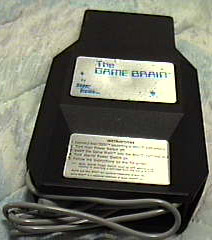
Made by Super Vision. A backup device that allows you to copy cartridges to cassette tapes, using a standard cassette player. It resembles a Supercharger in appearance. It was only available through mail order and cost $98.95, which included a free T-shirt. Collector Rick Weis is the only person known to have one. An ad appeared in the October 1983 issue of The Logical Gamer newsletter (pg. 2).
Game-Copier
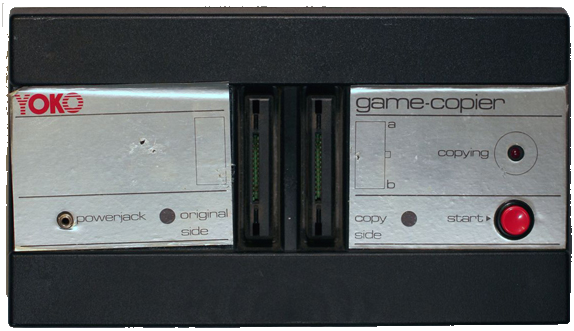
Made by Yoko. Sold and distributed by a company called C.S.K., the Yoko came boxed in Styrofoam with paper wrapping. The EPROM cart was sold separately. Each cart can hold two games (4K max). The games are selectable via a small dipswitch on the front of the cart. The copier gets its power from the 2600's power supply. To copy, insert the blank cart in one slot and the original in the other, and hit the red start button. The manual contains a list of games that can be duplicated. Oddly enough, the list has many games that have never been released, such as Fall Guy, Alligator People, Voyage to the Bottom of the Sea, Targ, Kickman, Stomp It, and Butch Cassidy. Believed to have been sold only in The Netherlands.
Harmony Cart + Game Brain
A Harmony cart with a modified Game Brain or old floppy drive cable can be used to dump just about any 2600 game made. See this page for more information.
Magic Box
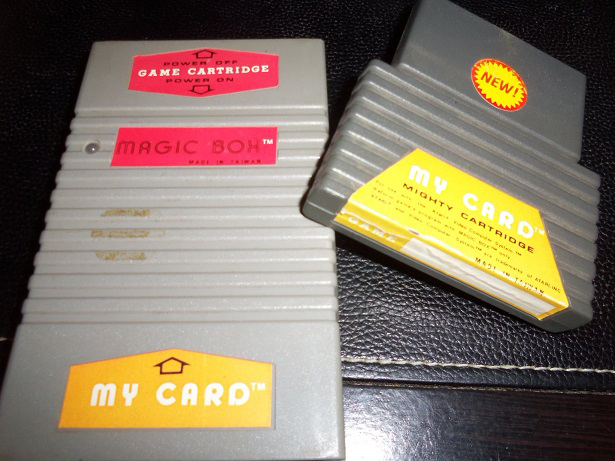
Made in Taiwan. No other information is available about this.
Prom Blaster
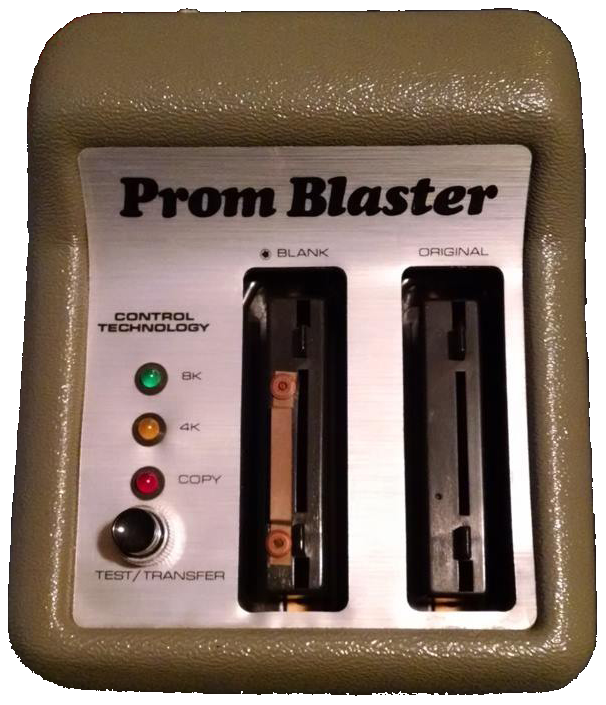
Made by JS & A. A small unit with 2 cartridge ports that allows you to copy 4K or 8K games in 3 minutes with the push of a button. The copier sold for $119 and blank carts were $15. According to their ad, it was developed by a company in Houston, TX and touted as a perfectly legal device (referring to the copyright act amendment passed in 1980), while at the same time promoting it as a good way to make extra money. J S & A (J.S. & A. Group, Inc., for Joseph Sugarman and Associates) also planned to offer 9 exclusive games with the intention that Prom Blaster owners could sell copies to their friends. It wasn't long before Atari took them to court to stop the sale of them (especially since an Atari cart appeared in their ad). They shut down soon after, and the games never materialized. A copy of the court hearing records detailing Atari's cast against them can be found HERE.
Repro Game Kit/Repro Vision System and Repro Cart
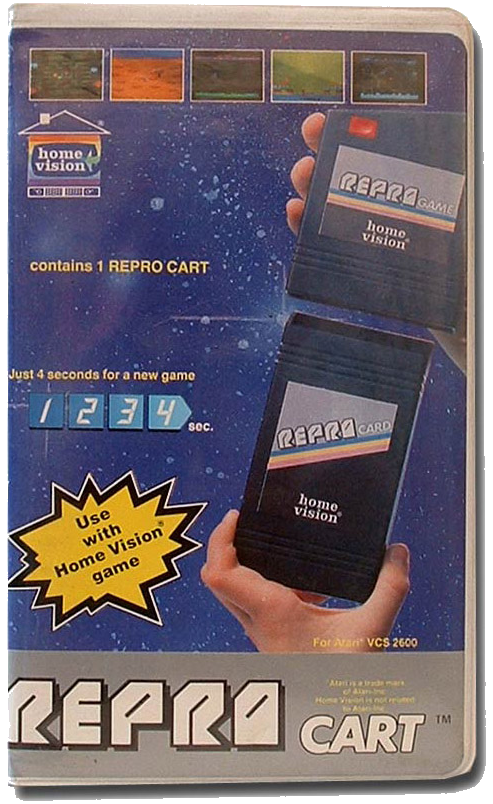
Made by Home Vision. This cart duplicating device is much smaller than the other two European copiers by Yoko and Unimex, and is very similar to Vidco's Video Game Recorder. The kit was packaged in a small cardboard box and contains a copier, a blank copy cart (called a Repro Cart, although the picture on the box shows a Repro Card label), and a game cartridge. The copier is a small, black device with a slot on each end with a red button and LED in the middle. The cartridge you want to copy plugs into one end, and a Repro Cart goes into the other. An internal (9v) battery powers it .According to the box, copying takes about four seconds (while the Yoko and Duplikator take at least 5 minutes). It has only been found in Germany and Belgium. The game Parachute was pre-copied on the Repro Cart. Also included as a separate cartridge is the game Robot Fight, which is a hack of Missile Command.
Video Game Recorder and Copy Cart
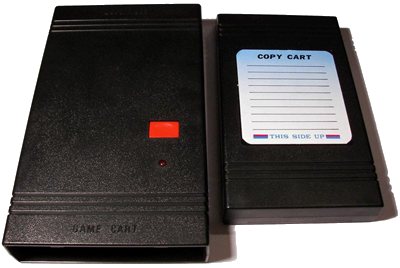
Made by Vidco International. Very similar to the Repro Game Kit by Home Vision (a copy of a copier?). The cartridge you want to copy plugs into one end, and a special blank cartridge called a Copy Cart goes into the other. 3 AA batteries power it (the Repro Cart uses a 9v battery). According to a January 1984 article in Video Games, it took 9 months to develop this copier. Due to memory limitations, not every cartridge can be copied, but the unit is fairly reliable. Dishaster was packaged with the unit, along with 1 Copy Cart. The listed entry applies to the complete set (which is usually referred to as Copy Cart, as that's the only name on the box). Originally listed in 1983 at $59.95, and later advertised for $49.95. A sealed copy sold on eBay in 2010 for $3,500.
Q: How do I transfer ROMs or binary files to a VCS/2600?
A: You need one of the following items:
Cuttle Cart - Made by Chad Schell / Shell's Electronics. He made these for both the Atari VCS/2600 and 7800. The Cuttle Carts are no longer made. Used ones occasionally appear on Ebay, but be prepared to spend more than they were originally sold for.
Modified 7800 system - see Eckhard Stolberg's Atari 7800 Developer's Page for more information.
Modified Atari Flashback2 system - see Fred X. Quimby's modified Flashback 2 and "Alex 79" variant
Modified Starpath Supercharger (by Bob Colbert)
Q: How do I program my own VCS/2600 games?
A: Back in the 1970s, a major financial investment in specialized equipment (such as a Genrad) was needed, but now programming a VCS game can be done with a standard PC and a few software tools. You need a fundamental understanding of assembly language programming, as well as basic knowledge of the Atari VCS's 6507 processor chip (which is a variant of the more-popular 6502). Even the most novice programmer can use a program like Batari Basic to program games for it. Starting in 1979, new programmers were given a copy of Steve Wright's Stella Programmer's Guide. These days, the main online source of information for VCS programmers is the Atariage website. A good place to start is with Andrew Davie's 2600 Programming for Newbies; a copy of it, along with other articles, can be found HERE. Prior to that, the Stella mailing list (also know as the Atari 2600 Programming list) was the go-to place, but since April 2006 it's no longer supported (here are the Stella list archives which still contain a lot of valuable information). Another good source of information is Kyle Reiach's 8Blit YouTube channel.
Q: How do I make my own cartridge?
A: You'll need some equipment - both soldering and desoldering irons, an EPROM programmer, and an EPROM eraser. Parts needed are EPROMS, pcbs (in most instances, a standard 4K cart pcb will work, which you can purchase here), and an additional chip, such as a 74LS04 hex inverter, or a GAL or PAL chip. What size EPROM and what type of pcb you'll need depends on the size of the game. 2K and 4K games use either a 2532 or 2732 (plus a 74LS04). 8K games use a 2764 and a GAL/PAL chip (either chip can be used, only the programming is different). Larger games, or ones that require special chips such as the SARA require a special pcb. Different methods of bank-switching were also used by different companies, although the most popular method is Atari's. For more information on bank-switching, see Kevin Horton's excellent article.
Apollo designed at least 3 different 4K boards. These were used in Apollo's Lochjaw and Chase The Chuck Wagon carts. Other companies used them for their games such as Gammation (Gamma Attack), Telesys, and Wizard Video (Halloween and The Texas Chainsaw Massacre). They were also sold through Jameco to the public:
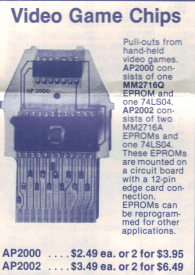
Longtime pirate Randy Crihfield of Hozer Video Games was the first person to describe how to modify an Atari 4K pcb to make your own cartridges. He later designed and sold new 4K boards.
He also wrote a very informative article regarding all the various bank-switching methods, explaining how Atariage's boards work and how to write GAL files for them, where folks can get the software to program their own .jdec files, etc.Chris Wilkson was the first person to use a PAL chip and design a board for 8K and 16K games. Wilkson was also the first person to design a 32K board. Unfortunately, according to Wilkson, Joe Grand copied Wilkson's work without permission and sold boards using Wilkson's designs both through his Grand Idea Studio website (under the Pixels Past name) and to Albert Yarusso of AtariAge to use (neither credited or compensated Wilkson), and Grand even went so far as to encrypt their PAL or GAL chips to try and prevent others from copying them.
8-Bit Classics sells new cart pcbs for $5 each. Note that these aren't designed for use with a RF shield and at least one person has indicated the board generates a lot of RF interference when populated.
Robert Demming has a website describing how to build your own 512-in-1 multicart.
Jeff Wierer wrote up a document on how to create a 32K 7800 cartridge.
Q: How do I add a pause switch?
A: Victor Trucco has created a true pause circuit that can be added to any VCS/2600 system, similar to how the pause switch works on the Brazilian Atari VCS/2600-compatible system, the Onyx Jr., by Microdigital. Michael Pagano / Vintage Gaming and More sells copies of this.
Q: How do I convert an Atari joystick for use with a PC?
A: Greg Bendokus wrote an article about how to hack a serial-style PC gamepad controller for use with an arcade-style controller. Scott Stilphen wrote a similar article using Gravis USB gamepad inside of an Atari joystick. Victor Trucco has an article on how to make your own USB interface board for use with an Atari joystick. RetroZone also sells a kit called the Atari RetroKit to convert your joystick to USB
Q: How can I convert a mouse into a paddle controller?
A: Eduardo has done this, you can see some pictures and general instructions here.
Q: How do I convert an NES controller to an Atari pinout?
A: See the following video.
Q: How do I convert a Sega Master System light gun to an Atari pinout?
A: The Aug 1988 (Vol 7, Num 4) of Antic contained an article called First look: Inside the XE Game System: Hardware surprises revealed. It described the conversion:
To modify the Sega gun for the Atari, you'll have to cut off the incompatible connector. The wires must be stripped back and soldered into an Atari joystick connector as follows:
| SEGA GUN | ATARI JOYSTICK PORT |
| Blue wire | Pin 1 stick FWD |
| Gray wire | Pin 6 trigger |
| Green wire | Pin 7 +5 volts |
| Black wire | Pin 8 Ground |
Because of the close-fitting connections with the XEGS ports, don't wire in a DB9 female connector that has "ears". Most joysticks don't have wires for unused signals, so cutting up an old joystick cable may not work. Specifically, an Atari joystick does not need the +5 volts, so there isn't likely to be a wire connected to pin 7. However, you can find joystick extension cables at Radio Shack, which have all nine pins wired from male to female.
Once it's all hooked up, you'll notice the gun fires when you release the trigger; the Sega trigger wiring is the opposite of what the Atari light gun uses. To rewire the trigger switch, remove the 5 screws (one is under the Sega logo on the side), find the trigger micro-switch with three connections, and wire it to the normally-closed contacts.
A schematic can also be found on John Soper's website.
Q: How do I make a glove controller, similar to Mattel's Power Glove for the Nintendo NES?
A: Eduardo has done this, and you can see some pictures and general instructions here.
Q: What audio mods are/were available?
A: Modifying an Atari VCS/2600 for stereo sound is a simple project that involves adding a couple RCA phono jacks to the system case, and wiring them to the output pins of the TIA chip. Victor Trucco wrote an article on his method.
Some of the more professional video mods (below) also include support for stereo sound.
Q: What video mods are/were available?
A:
Nathan Strum has a nice comparison site of some of the various A/V mods.
In my experience, the 6-switch models offer a superior picture output, compared to the 4-switch and JR models. Coupled with a coax-to-phono connector, they offer a picture quality that's comparable to any mod, and you can obtain composite A/V output if used in conjunction with a VCR.
Q: What console mods/updates are available?
A: INCOMPATIBILITY: For 6-switch models, a mod can be done to fix incompatibility problems with certain cartridges (such as River Raid II).
WEAK COLOR: There's Atari tech tips regarding adding an 820 Ohm, 1/4 watt resistor between pins 6 and 9 of the TIA chip (A201) on all 2600As (up to Rev 15) and Rev #4 2800s to improve color saturation. See the 2600/2600A Field Service Manual in the documents section of Atari Compendium's archives.
BLACK SCREEN ON POWERUP: 2600A models may show a black screen if powered off and on too quickly. The fix is to change the resistor at R227 from 24K Ohms to 110K Ohms.
POWER LED: The July 1983 issue of Videogaming Illustrated featured an article by Bob Guerra on how to install a power LED to the VCS.
Q: What controller mods are/were available?
A: The December 1982/January 1983 issue of A.N.A.L.O.G. featured an article on how to rewire a joystick for left-handed players.
The January/February 1983 issue of Atari Age also featured an article on how to rewire a joystick for left-handed players.
The spring 1984 issue of Special Projects featured an article by Jim Stephens called "Build Fire-Fli" on how to build a rapid-fire module for your Atari VCS/2600.
John Soper posted this autofire circuit by Marco Antonio and Checa Funcke.
The October 1983 issue of Videogaming Illustrated featured an article by Bob Guerra on how to install your own pause button on your Atari VCS/2600. Actually, it wasn't a true pause button, but rather how to add an extra switch to your joystick that's wired up to the TV Type switch on the system. It also mentions adding extra buttons for SELECT and RESET.
The October 1982 and December 1982 issues of Videogaming Illustrated featured an article on how to build a Stroblaster and hook it up to your fire button.
Osgeld's Mod Shop sells a drop-in replacement pcb with tactile switches for the Atari CX-40 standard joystick.
Q: How do the Driving controllers work?
A: Although they look similar to the analog Paddle controllers, they do not work the same way. The controller uses a rotary (quadrature) encoder to generate full 2-bit gray code for each full turn of the knob. This results in a 'resolution' of 16 different positions.
Q: What does it mean to "fry" a game?
A: "Frying" a game involves jiggling the power switch in order to power up a cartridge to create random states with the console's RAM. It causes the program to boot from an unspecified location (usually bypassing the game's initialization routines). Despite the name, the technique is relatively safe on your hardware, beyond possibly damaging the power switch itself. The Stella emulator includes an option to "fry" a game in a similar fashion by pressing the backspace key.
Q: How do I make my own controller?
A: The February 1983 issue of Radio-Electronics features an article by David J. Sweeney on how to build the Atari Videogame Controller - a custom button controller that features rapid-fire and a tilt-activated fire button.
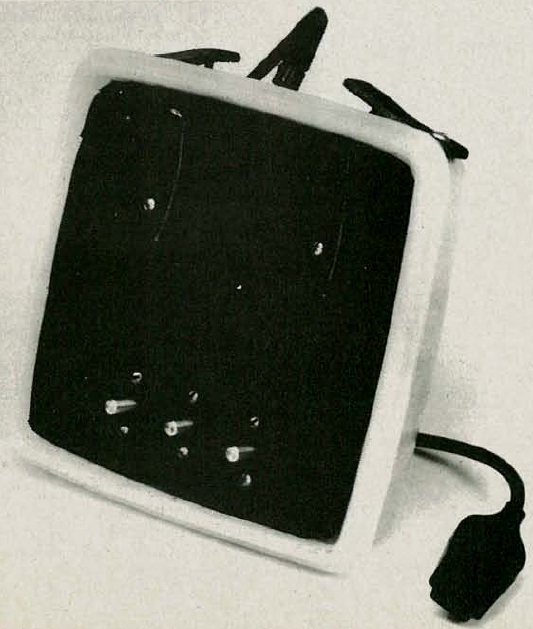
Q: What are the pinouts to the custom TIA chip?
A: Pinouts for both the NTSC and PAL versions of Atari's TIA chip can befound in my TIA chip article, along with Coleco's TIA knock-off, the VIC, which was used in their Colecovision Expansion Module #1 and Gemini Video Game System.
Q: Which games offer stereo sound?
A:
Q: How do you modify a Video Game Brain to make it
safer on cartridges?
A: The Video Game Brain is notable for having a design flaw that can potentially damage cartridges. When a cart is not selected, voltage is still running through the address and data lines while the power pin is floating, which chips are not designed for. This can result in damage to games, the system, or both. It's possible to modify the unit by re-wiring the switches to run the GND or A12 connector from the system to the appropriate pin on the cart port. The following photos show the pcb how it was wired both before and after the modification. NOTE: the fat traces on the pcb are NOT grounds! The yellow wire on the middle terminal of the switch was the +5v power connection. This wire was removed, as was the unsheathed wire through all of the middle terminals of all switches.
